
Achieving the right fiscal-
monetary mix (in the
context of the economic
governance review)
Compilation of papers
Economic Governance and EMU Scrutiny Unit (EGOV)
Directorate-General for Internal Policies
PE 747.830 - September 2023
EN
STUDY
Requested by the ECON committee
Monetary Dialogue Papers, September 2023

IPOL | Economic Governance and EMU Scrutiny Unit (EGOV)
2 PE 747.830

Achieving the right fiscal-monetary mix (in the context of the economic governance review)
PE 747.830 3
Monetary Dialogue September 2023
Abstract
Alignment of monetary and fiscal policies has proven to be
decisive for the euro area's ability to withstand successive crises
over the years. Today, the European Central Bank (ECB) continues
its fight against inflation by implementing a monetary policy
tightening unprecedented in pace and scale. At the same time,
after allowing for some deviations from regular budgetary rules
with the activation of the general escape clause in 2020, the EU is
set to reapply its fiscal rules fully from 2024. In addition, co-
legislators are currently discussing the proposed legislation by
the European Commission for the reform of the economic
governance framework. Five papers were prepared by the ECON
Committee’s Monetary Expert Panel, discussing the interaction
between monetary and fiscal policies in the euro area.
This document was provided by the Economic Governance and
EMU Scrutiny Unit at the request of the Committee on Economic
and Monetary Affairs (ECON) ahead of the Monetary Dialogue
with the ECB President on 25 September 2023.
Achieving the right fiscal-
monetary mix (in the
context of the economic
governance review)
Compilation of papers

IPOL | Economic Governance and EMU Scrutiny Unit (EGOV)
4 PE 747.830
This document was requested by the European Parliament's Committee on Economic and Monetary
Affairs.
AUTHOR(S)
The economic governance review and its impact on monetary-fiscal coordination
Zsolt DARVAS, Bruegel and Corvinus University of Budapest
Jeromin ZETTELMEYER, Bruegel and CEPR
Monetary-fiscal interaction: achieving the right monetary-fiscal policy mix in the euro area
Kerstin BERNOTH, DIW Berlin
Sara DIETZ, Hengeler Mueller
Rosa LASTRA, Queen Mary University of London
Marie RULLIÈRE, DIW Berlin
Big central banks and big public debts: The next challenges
Charles WYPLOSZ, The Graduate Institute, Geneva
An effective policy mix for the EU’s post-pandemic challenges
Paolo Canofari, Università Politecnica delle Marche, Ancona.
Giovanni Di Bartolomeo, Sapienza Università di Roma and University of Antwerp.
Marcello Messori, Luiss Guido Carli, Roma
Fiscal adjustment supports the fight against sticky inflation
Daniel GROS, Bocconi University, CEPS
Farzaneh SHAMSFAKHR, CEPS
ADMINISTRATOR RESPONSIBLE
Drazen RAKIC
Giacomo LOI
Maja SABOL
EDITORIAL ASSISTANT
Adriana HECSER
LINGUISTIC VERSIONS
Original: EN
ABOUT THE EDITOR
The Economic Governance and EMU Scrutiny Unit provides in-house and external expertise to support
EP committees and other parliamentary bodies in shaping legislation and exercising democratic
scrutiny over EU internal policies.
To contact Economic Governance and EMU Scrutiny Unit or to subscribe to its newsletter please write
to:
Economic Governance and EMU Scrutiny Unit
European Parliament
B-1047 Brussels
E-mail: [email protected]

Achieving the right fiscal-monetary mix (in the context of the economic governance review)
PE 747.830 5
Manuscript completed in September 2023
© European Union, 2023
DISCLAIMER AND COPYRIGHT
The opinions expressed in this document are the sole responsibility of the authors and do not
necessarily represent the official position of the European Parliament.
Reproduction and translation for non-commercial purposes are authorised, provided the source is
acknowledged and the European Parliament is given prior notice and sent a copy.

IPOL | Economic Governance and EMU Scrutiny Unit (EGOV)
6 PE 747.830
CONTENTS
THE ECONOMIC GOVERNANCE REVIEW AND ITS IMPACT ON MONETARY-FISCAL
COORDINATION 7
Zsolt DARVAS
Jeromin ZETTELMEYER
MONETARY-FISCAL INTERACTION: ACHIEVING THE RIGHT MONETARY-FISCAL POLICY MIX IN
THE EURO AREA 35
Kerstin BERNOTH
Sara DIETZ
Rosa LASTRA
Marie RULLIÈRE
BIG CENTRAL BANKS AND BIG PUBLIC DEBTS: THE NEXT CHALLENGES 65
Charles WYPLOSZ
AN EFFECTIVE POLICY MIX FOR THE EU’S POST-PANDEMIC CHALLENGES 91
Paolo CANOFARI
Giovanni Di BARTOLOMEO
Marcello MESSORI
FISCAL ADJUSTMENT SUPPORTS THE FIGHT AGAINST STICKY INFLATION 119
Daniel GROS
Farzaneh SHAMSFAKHR

Achieving the right fiscal-monetary mix (in the context of the economic governance review)
PE 747.830 7
The economic governance
review and its impact on
monetary-fiscal
coordination
Zsolt DARVAS
Jeromin ZETTELMEYER
External author:
Zsolt DARVAS
Jeromin ZETTELMEYER

IPOL | Economic Governance and EMU Scrutiny Unit (EGOV)
8 PE 747.830
Abstract
This paper analyses how the fiscal framework proposed by the
European Commission in April 2023 might affect the interplay
between fiscal and monetary policies, from three perspectives: its
impact on the medium-term fiscal stance in the euro area, its
design, and its implications for the ECB’s Transmission Protection
Instrument (TPI). It concludes with recommendations for
amending both the fiscal governance proposal and the TPI.
This document was provided by the Economic Governance and
EMU Scrutiny Unit at the request of the Committee on Economic
and Monetary Affairs (ECON) ahead of the Monetary Dialogue
with the ECB President on 25 September 2023.

Achieving the right fiscal-monetary mix (in the context of the economic governance review)
PE 747.830 9
CONTENTS
LIST OF ABBREVIATIONS 10
LIST OF FIGURES 11
LIST OF TABLES 11
EXECUTIVE SUMMARY 12
INTRODUCTION 13
IMPLICATIONS OF THE PROPOSED FISCAL GOVERNANCE FRAMEWORK FOR THE FISCAL
STANCE IN THE EU 15
DOES THE PROPOSED FRAMEWORK OPTIMALLY TRADE-OFF FISCAL SUSTAINABILITY AND
FLEXIBILITY? 21
REEXAMINING THE TRANSMISSION PROTECTION INSTRUMENT IN LIGHT OF THE
PROPOSED FRAMEWORK 25
4.1. Would the proposed framework complicate the application of the TPI? 26
4.2. Does the proposed framework offer an opportunity for improving the TPI? 27
CONCLUSION 30
REFERENCES 32

IPOL | Economic Governance and EMU Scrutiny Unit (EGOV)
10 PE 747.830
LIST OF ABBREVIATIONS
CFC
Central fiscal capacity
DSA
Data sustainability analysis
EC
European Commission
ECB
European Central Bank
EFB
European Fiscal Board
EGR
Economic governance review
ESCB
The European System of Central Banks
ESM
European Stability Mechanism
EU
European Union
GDP
Gross domestic product
IFIs
Independent fiscal institutions
MS
Member states of the European Union
MTO
Medium-term objective
NRRP
National recovery and resilience plan
OMT
Outright Monetary Transactions
TPI
Transmission protection instrument
QE
Quantitative easing

Achieving the right fiscal-monetary mix (in the context of the economic governance review)
PE 747.830 11
LIST OF FIGURES
Figure 1: IMF projections for the euro area, and adjusted growth projections corresponding to the
proposed new fiscal rules, 2022-2028 19
LIST OF TABLES
Table 1: Fiscal adjustment based on European Commission forecasts (2023-24), proposed framework
(2025-28), and current framework (2025-28) 18

IPOL | Economic Governance and EMU Scrutiny Unit (EGOV)
12 PE 747.830
EXECUTIVE SUMMARY
• Fiscal and monetary policies interact through multiple channels and interfere with (or
support) each others’ objectives. The interplay between monetary and fiscal policy is hence
important for economic welfare. This paper analyses how the fiscal framework proposed by the
European Commission in April 2023 might affect this interplay, from three perspectives: (1) its
impact on the medium-term fiscal stance; (2) its capacity to reconcile debt sustainability and
flexibility; and (3) its implications for the European Central Bank (ECB)’s Transmission Protection
Instrument (TPI).
• The proposed framework would lead to substantial tightening in the medium term. In the
short term, tighter fiscal policy supports disinflation. But if the ECB’s inflation target is reached by
2025, as both ECB and International Monetary Fund expect, then continued fiscal consolidation
under the new fiscal framework might result in an overly tight fiscal stance, requiring the ECB to
offset it.
• The proposed new fiscal framework is broadly balanced between the objectives of ensuring
debt sustainability and preserving flexibility, but with room for improvement. We
recommend strengthening the requirement that seeks to prevent excessive ‘backloading’ of fiscal
adjustment, while the requirement that debt falls within the first four years of the application of
the framework should be removed or modified substantially, as should the minimum adjustment
requirement of 0.5% of GDP for countries with deficits above 3%. We also recommend a review of
the Commission’s debt sustainability analysis methodology, and a role for independent fiscal
councils in the process of activating the framework’s escape clauses.
• While the proposed fiscal framework would not complicate the activation of the
Transmission Protection Instrument (TPI) compared to the current framework, we
recommend amending one of its eligibility conditions. The ECB has delegated the assessment
of three of the four TPI eligibility conditions to the Council and the Commission. Since these
conditions will continue to be evaluated by the Council and the Commission under the proposed
framework, their application under the TPI does not change. One eligibility condition, however –
whether a country’s debt is sustainable – has not been delegated by the ECB. We argue that since
debt sustainability is a necessary condition for compliance with the proposed framework, this
condition is either redundant, or there should be a presumption that the ECB will follow the Council
and Commission when it decides on debt sustainability. This would not reduce the ECB’s
independence, since the decision on whether activation of the TPI is required remains at the
discretion of the ECB.

Achieving the right fiscal-monetary mix (in the context of the economic governance review)
PE 747.830 13
INTRODUCTION
*
Monetary and fiscal policy pursue different objectives. Monetary policy in the euro area has only one
primary mandate, price stability
1
. Fiscal policy, in contrast, has many objectives: provision and financing
of public goods, output stabilisation, redistribution, intergenerational equity and improvements in
economic allocation. Unlike monetary policy, which is centralised in the hands of the ECB, fiscal policy
in the euro area remains in the hands of national governments.
While they have different objectives, fiscal and monetary policies interact through multiple channels.
Monetary policy influences both inflation and real output, and thus fiscal revenues directly, and fiscal
expenditure indirectly. Monetary policy operates in part by influencing real interest rates, which impact
government borrowing cost. Fiscal policy influences the price level both through aggregate demand
and through its impact on the supply side (via labour supply and public investment, and potentially
muting the transmission of supply shocks, such as commodity price shock). It also influences measured
inflation through changes in excise and VAT tax rates. Finally, unsustainable fiscal policy can threaten
price stability, either through the dislocations induced by a debt crisis, or by leading to pressures for
debt monetisation to stave off the crisis. Such fiscal-monetary interactions were important
considerations in the creation of EU-wide fiscal rules before the euro was launched.
The potential to interfere with (or support) each others’ objectives implies that the interplay (“mix”)
between monetary and fiscal policies is important. Fiscal policy that gets in the way of monetary policy
objectives, and vice versa, can generate welfare costs. For example, if fiscal policy seeks to raise real
output above potential, it may raise inflation, forcing monetary policy to tighten. The result will not be
higher output, but rather higher real interest rates, which raise the cost of borrowing and reduce fiscal
space. Another example applies to a setting in which interest rates are close to their effective lower
bound and inflation is below the central bank’s target. In this case, reaching price stability without
compromising financial stability may require support from (expansionary) fiscal policy.
By influencing fiscal policy, the EU-level fiscal governance framework will have an influence on the
interplay between fiscal and monetary policies. The purpose of this paper is to analyse how the
framework proposed by European Commission in April 2023 (EC, 2023a,b) might affect this interplay.
We tackle this question from three angles.
First, by quantifying the potential impact of the framework on the fiscal stance in the next five years.
Inflation in the euro area is running high, and underlying inflation has proved to be persistent. A
frequently voiced view is that fiscal policy should be tighter in support of the disinflation process (see,
e.g., IMF, 2023). Fiscal policy is in fact projected to tighten this year, and next, before the proposed fiscal
framework would come into effect. The question is how the proposed framework might influence the
fiscal stance from 2025 onward if it were to become law next year.
Second, from a design perspective. We assume that fiscal policy makers are disciplined by elections,
but also subject to incentives that could result in overborrowing and in some cases in a bias toward
current spending. The purpose of fiscal frameworks is to ensure debt sustainability and ideally to
protect public investment, while otherwise providing flexibility to fiscal policy, allowing the fiscal
authorities to pursue their many objectives. Frameworks that achieve these objectives are also in the
*
The authors thank Marco Buti, Grégory Claeys, Maria Demertzis, Francesco Papadia, Lucio Pench, Lucrezia Reichlin, André Sapir, Armin
Steinbach, and Stavros Zenios for valuable comments, and Lennard Wleslau for preparing Figure 1.
1
The objectives of the European System of Central Banks (ESCB) are defined in the Treaty on the Functioning of the European Union as: “the
primary objective of the ESCB shall be to maintain price stability. Without prejudice to the objective of price stability, it shall support the general
economic policies in the Union with a view to contributing to the achievement of the objectives of the Union as laid down in Article 3 of the Treaty
on European Union.”

IPOL | Economic Governance and EMU Scrutiny Unit (EGOV)
14 PE 747.830
interest of the central bank. Debt sustainability reduces the risk of fiscal dominance and disruptive
crises that threaten price stability
2
. Fiscal policy that is friendly to public investment and raises potential
output will lower inflation pressure for a given level of demand. Flexibility is important because it allows
the fiscal authorities to pursue their various objectives and to deploy policy in support of the central
bank’s price stability objective. We analyse the trade-off between debt sustainability and flexibility
under the proposed framework.
Third, from the perspective of a specific ECB instrument, the “transmission protection instrument” (TPI)
wascreated in July 2022 to maintain orderly debt market conditions in the face of sharply higher
interest rates. While the TPI is not the only ECB instrument at the intersection of monetary and fiscal
policy,
3
it is the only one whose eligibility criteria include compliance with the fiscal framework, as well
as debt sustainability. We answer the question whether the changes in the framework would have an
impact on the operation of the TPI, and whether the TPI should be modified to better “fit” the new
framework.
The remainder of this paper is structured in line with these three perspectives. Section 2 analyses the
implications of the proposed framework for the fiscal stance over the coming 5 years. Drawing on the
empirical findings of Section 2, Section 3 takes a view on the design of the proposed fiscal governance
framework from the perspective of the interplay between monetary and fiscal policy. Finally, Section 4
analyses the relationship between the proposed framework and the TPI. Section 5 concludes.
2
Fiscal dominance describes a situation in which large government debt and deficit prevent the central bank from controlling inflation. In
such a situation, a central bank interest rate increase to tame inflation might result in market pressure on government bond markets, and
the government might become insolvent without central bank financing.
3
Other instruments include Outright Monetary Transactions (OMT) and all instruments that operate through bond purchases in secondary
markets (which are often called quantitative easing – QE).

Achieving the right fiscal-monetary mix (in the context of the economic governance review)
PE 747.830 15
IMPLICATIONS OF THE PROPOSED FISCAL GOVERNANCE
FRAMEWORK FOR THE FISCAL STANCE IN THE EU
The European Commission (EC)’s April 2023 proposal to replace the current EU fiscal framework
4
requires Member States (MS) to develop medium term fiscal-structural plans, following discussions
with the Commission, that meet two main requirements. Both must “hold in the absence of any further
budgetary measures over a period of 10 years” (EC, 2023a, Article 15) following the end of a 4-7-year
adjustment period:
(a) public debt as a share of GDP must be “put or kept on a plausibly downward path (…) or
stay at prudent levels”.
(b) the government deficit must be maintained or brought below the 3% of GDP reference
value.
5
Annex V of EC (2023a) defines debt that is “put or kept on a plausibly downward path (…) or stay at
prudent levels” as a debt path that slopes downward (or remains below 60% of GDP if it already meets
the 60% benchmark) both with sufficiently high probability for 5 years after the adjustment period, as
assessed by the stochastic debt sustainability analysis (DSA) of the Commission; and under the
deterministic stress scenarios described in the Commission’s 2022 Debt Sustainability Monitor (EC,
2023c).
In addition, the proposal commits the Commission to several additional conditions both in formulating
a “technical trajectory” that it must put forward as a basis for discussion with MS with debt or deficits
above the Treaty benchmarks of 60% and 3% of GDP, and in its assessment of MS medium-term fiscal-
structural plans. Specifically, it must check: ”whether the fiscal adjustment effort over the period of the
national medium-term fiscal-structural plan is at least proportional to the total effort over the entire
adjustment period” (no-backloading safeguard); “whether the public debt ratio at the end of the
planning horizon is below the public debt ratio in the year before the start of the technical trajectory”
(debt safeguard), “whether for the years that the Member State concernced is expected to have a deficit
above the 3% of GDP reference value, and the excess is not close and temporary”, the fiscal adjustment
is at least 0.5% of GDP (excessive deficit safeguard
6
), and whether “national net expenditure growth
remains below medium-term output growth, on average, as a rule over the horizon of the plan” (net
4
The proposal consists of two proposed regulations and one directive. The main reforms are contained in a “Proposal for a regulation of the
European Parliament and of the Council on the effective coordination of economic policies and multilateral budgetary surveillance and
repealing Council Regulation (EC) No 1466/97” (EC, 2023a
) which would replace the “preventive arm” of the current Stability and Growth Pact.
In addition, a “Proposal for a Council regulation amending Regulation (EC) No 1467/97 on speeding up and clarifying the implementation of
the excessive deficit procedure” (
EC, 2023b) would abolish the “1/20
th
rule” which required MS with debt above 60% of GDP to reduce their
debts by at least 1/20
th
of the difference between its debt ratio and 60% per year, and refocus the existing “debt-based excessive deficit
procedure” on departures from the fiscal path agreed with the Council under the regulation replacing the preventive arm. However, the
“deficit-based excessive deficit procedure” (EDP) would remain largely unchanged, requiring that “for the years when the general government
deficit is expected to exceed the reference value, the corrective net expenditure path shall be consistent with a minimum annual adjustment
of at least 0,5% of GDP as a benchmark.” Finally, a “Proposal for a Council directive amending Directive 2011/85/EU on requirements for
budgetary frameworks of the Member States” (
EC, 2023c) aims at strengthening national-level independent fiscal institutions and medium-
term budgetary frameworks.
5
See Articles 6, 12, and 15 as well as Annex I and V of EC (2023a).
6
We interpret “a minimum annual adjustment of at least 0,5% of GDP as a benchmark” wording of the draft regulation on the excessive deficit
procedure (EC 2023b
) as at least half percent adjustment. In our numerical calculations, we assume exactly half percent when otherwise
adjustment would be less than half percent. However, Pench (2023) argues that the adjustment requirement can be less than half percent,
because this safeguard, as well as the debt reduction safeguard, could be given a subordinated role relative to the sustainability criterion
when the Commission and the Council make an overall assessment of the medium-term plans.

IPOL | Economic Governance and EMU Scrutiny Unit (EGOV)
16 PE 747.830
expenditure growth safeguard, which we interpret as ruling out a decline in the structural primary
balance over the first four years of the adjustment period)
In Darvas, Welslau and Zettelmeyer (2023), we compute the fiscal adjustment implications of these
conditions for all MS with 2024 projected debts or deficits above the reference values (on the
assumption that the first adjustment year under the framework would be in 2025), based on a
replication of the Commission’s DSA methodology, using EC forecasts for growth, market-based
interest rate and inflation expectations, as well as some ancillary assumptions to enable us to apply the
safeguards.
7
Table 1 summarises the main results. Positive numbers mean an increase in the structural primary
balance, i.e. a fiscal tightening, expressed in percent of GDP. Countries are listed in a declining order of
the fiscal balance forecast by the European Commission for 2024 (column 2). EC projections for fiscal
adjustment in 2023 and 2024 are shown in columns (3) and (4)
8
. These indicate that the Commission
expects sizeable fiscal consolidation in most EU countries, partly reflecting the withdrawal of COVID-19
and energy crisis support measures, albeit with exceptions (Belgium, Bulgaria, Croatia, Finland, and
Slovakia). The GDP-weighted aggregate impact of this tightening for the euro area countries shown in
the table is close to 0.8% of GDP in 2023 and 0.7% in 2024 (see bottom row).
9
Columns (5)-(12) show the annual average fiscal adjustment that would be required for the 2025-27
period if the Commission’s proposed framework was enacted in 2024. This depends on the adjustment
period, which is normally four years, but could be extended to seven years for countries undertaking
growth-enhancing structural reforms, including in the context of National Recovery and Resilience
Plans (NRRPs).
10
The table is laid out in a way that makes it clear which of the requirements of the
framework are driving the results: Columns (5) and (6) show the average annual adjustment for 2025-
28 that would be required by conditions (a) and (b) of the proposed framework, that is, to (a) put or
keep debt on a sustainable downward path, and (b) to lower the deficit to less than 3% of GDP by the
end of the adjustment period and keep it there for at least 10 years. Columns (7) to (12) show the annual
adjustment, separately for the years 2025, 2026 and 2027, which the proposed framework would
require once the safeguards are additionally applied. The need to show each year separately comes
from the excessive deficit safeguard, which applies only in years in which the deficit is still above 3%
11
.
Countries and years for which this safeguard is binding are highlighted in orange, countries for which
the debt safeguard is binding in yellow, and countries for which the net expenditure growth safeguard
7
The main assumption is that the “planning horizon” referred to in the debt safeguard, which is not defined in the proposed regulation, is
four years. In addition, we assume that the total adjustment requirement over the 4-7-year adjustment horizon is broken down into equal
adjustment steps, in structural primary balance terms. This assumption implies that the net expenditure paths automatically satisfy the no-
backloading safeguard; indeed, they go further, as the no-backloading safeguard as currently drafted does not restrict backloading within
either the four-year adjustment period or the first four years and the last three years of the seven-year adjustment period. See Darvas, Welslau
and Zettelmeyer (2023) and Pench (2023) for a discussion.
8
The source is European Commission (2023d).
9
Including the remaining euro area countries in the average would somewhat reduce the impact in 2023, to 0.6% of GDP, mainly due to
projected fiscal easing in the Netherlands (-1.9%) and Luxembourg (-1.5%), but leave the 2024 impact unchanged.
10
The calculations underlying Table 1 use the same growth forecasts to compute fiscal adjustment under the four and seven year adjustment
periods. To the extent that the extension to seven years is determined by the strength of MS plans to raise growth, this could moderately bias
up the adjustment results for the seven-year period shown in the table. However, Article 13 of the draft regulation (EC 2023a)
says that “During
the lifetime of the Recovery and Resilience Facility (…) commitments included in the approved Recovery and Resilience Plan of the Member State
concerned can be taken into account for an extension of the adjustment period.” Given that NRRP investments and reforms qualify for the
extension, and Member States have difficulties even in implementing NRRPs, at least until the end of 2026, it is unlikely that countries would
propose new investments and reforms to obtain an extension. NRRP investments and reforms, however, are already incorporated into the
official growth projections on which the table is based.
11
In Table 1, this makes a difference only for Poland in 2027.

Achieving the right fiscal-monetary mix (in the context of the economic governance review)
PE 747.830 17
is binding in light green. Finally, column (13) shows the average annual adjustment that would be
required, in structural primary balance terms, if the current fiscal framework based on a “Medium Term
Objective” (MTO) were reapplied after 2024.
The main results are as follows.
1. The proposed framework would require continued fiscal adjustment from 2025 until the end of the
four-year planning horizon in 2028, from almost all MS (the only exceptions are Cyprus and Greece,
whose 2024 structural primary balances are projected to already be above the 2028 values
prescribed by the framework).
2. As indicated by the highlights (and by comparing columns (5)-(6) and columns (7)-(12)), the fiscal
adjustment requirements of the proposed frameworks are mostly driven by conditions (a) and (b)
above – that is, the debt sustainability requirement and the requirement that the deficit be reduced
to and remain below 3% of GDP by the end of the adjustment period. There are three exceptions:
o First, for a few countries with projected excessive deficits in 2024, the annual fiscal
adjustment prescribed by conditions (a) and (b) falls short of the 0.5% of GDP required by
the excessive deficit safeguard (Poland and Malta, and additionally Italy, Spain, Hungary
and Romania for the 7-year adjustment period which lowers the average annual
adjustment required by conditions (a) and (b)).
o Second, the debt safeguard is binding for two countries, France and Bulgaria, in both the
4-year and 7-year adjustment periods, and for three additional countries, Belgium, Romania
and Slovakia, in the 7-year adjustment period only. For France, the annual required
adjustment during 2024-28 goes up from 0.8% of GDP (4-year adjustment period) or 0.4%
of GDP (7-year adjustment period) to 1.1% of GDP. For Belgium, the increase is 0.3% of GDP
(7-year adjustment period only).
o Third, the net expenditure safeguard is binding for Greece and Cyprus. In the absence of
this safeguard, these countries would have been able to lower their structural primary
balances from their high projected levels in 2024 without running afoul of either conditions
(a) and (b) not any of the other safeguards.
3. While the proposed system prescribes a significant fiscal tightening, this is not as large as would be
required under the current fiscal rules, if these were to be reapplied from 2025 onward. A
comparison between column (13) and columns (7)-(12) shows that the fiscal adjustment
requirement under the proposed system would be at least 0.2% of GDP per year lower than under
the current system for Cyprus, Greece, Finland, Spain, Italy, Malta, Belgium, and Slovakia. For
Portugal, Germany, Austria, France and Slovenia, it does not make much of a difference (+/- 0.1%
of GDP). Only for Bulgaria would the proposed system require much higher fiscal adjustment than
the current one, on account of the debt safeguard. The difference comes mainly from the fact that
in the current system, higher debt raises the MTO via an ad-hoc formula, while fiscal adjustment
under the proposed system is based on a set of deterministic and stochastic debt projections (with
some ad hoc corrections via the safeguards, as discussed above).
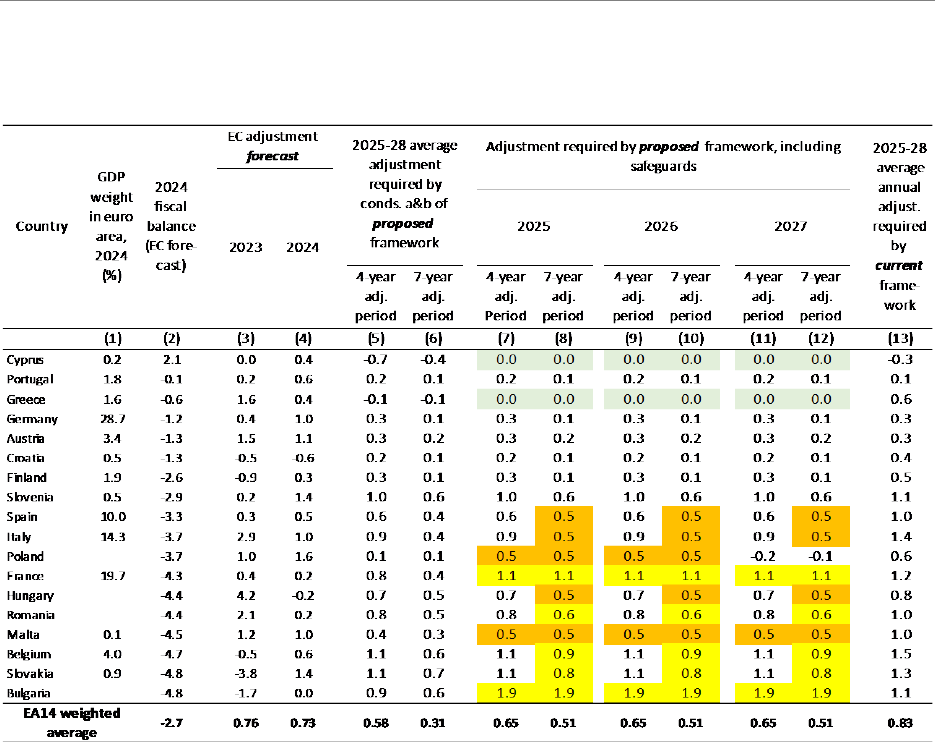
IPOL | Economic Governance and EMU Scrutiny Unit (EGOV)
18 PE 747.830
Table 1: Fiscal adjustment based on European Commission forecasts (2023-24), proposed framework
(2025-28), and current framework (2025-28)
(in structural primary balance terms, expressed in percent of GDP)
Source: authors’ calculations based on Darvas, Welslau and Zettelmeyer (2023), economic growth projections from the European
Commission’s May 2023 forecast, and market-based interest rate and inflation forecasts.
Note: Countries and years for which excessive deficit safeguard is binding are highlighted orange, countries for which the debt safeguard is
binding are highlighted yellow, and countries for which the net expenditure safeguard is binding in light green.
The last line of the table shows the aggregate implications for the euro area fiscal stance, based on the
14 euro-area countries included (88% of the euro area in GDP terms). This implies that the consolidation
forecast by the Commission for 2023 and 2024 would continue during 2025-28, albeit at a slightly
slower pace. The Commission’s DSA and the need to reduce the deficit below 3% imply a tightening
between 0.58% and 0.31% of GDP per year, depending on whether countries are given 4 or 7 years
respectively to adjust (columns 5 and 6). The application of the safeguards bumps this adjustment up
by a notch, to 0.65% and 0.51% percent of GDP, mostly on account of the much higher adjustment for
France (columns 7-12).
The question is whether this fiscal adjustment path would support the achievement of the ECB’s price
stability objective. Most private forecasts and all major official forecasts – by the ECB, the European
Commission, the IMF and the OECD – predict a return to the inflation target in the medium term.
However, these forecasts typically assume that the central bank will do whatever it takes to achieve its
inflation target and thus do not answer the question of whether fiscal policy could contribute either by
accelerating the process or lowering the output costs of disinflation. To take a stab at that question, it
is necessary to look at inflation forecasts together with forecasts for output and the fiscal stance.
The only institution that provides a set of consistent forecasts of these variables over the medium term
(until 2028) is the IMF in the World Economic Outlook. While these forecasts are somewhat dated (April
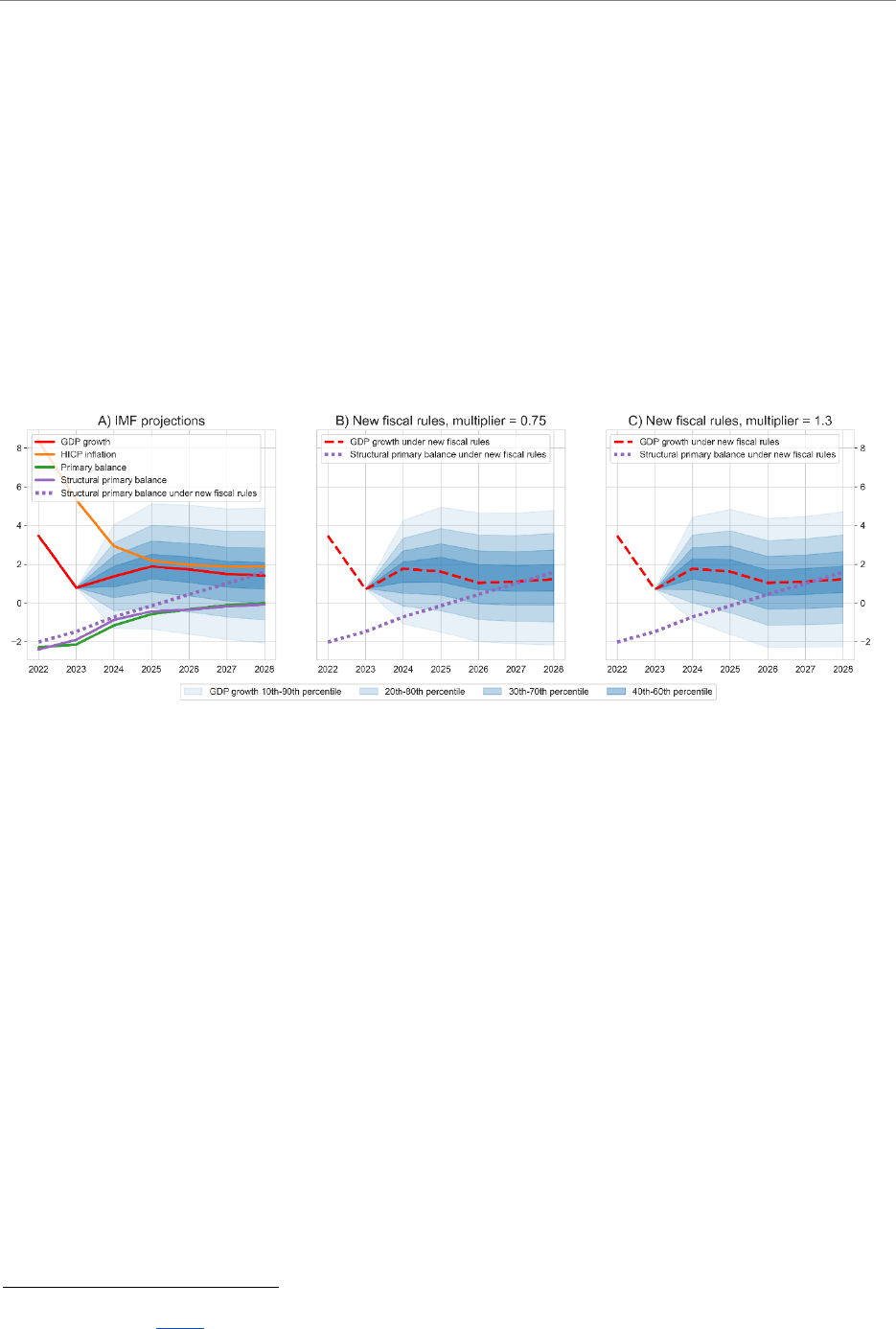
Achieving the right fiscal-monetary mix (in the context of the economic governance review)
PE 747.830 19
2023)
12
, it is worth asking what they imply if taken at face value. The IMF expects euro-area inflation to
return to very close to the 2% ECB target by 2025 and stay close to the target until the end of the
forecast horizon (Figure 1, Panel A). It also expects the euro area to avoid a recession; indeed, it projects
a recovery of growth by 2025. This said, there is high uncertainty around these projections, indicated
by the shaded confidence bands, which imply a recession probability of 25% in 2026.
13
Finally, as
regards fiscal adjustment, the IMF expects an adjustment similar to the European Commission in total
in 2023 and 2024, followed by much slower adjustment over the medium term, with the structural
primary balance gradually converging to zero after 2025. Panel A of Figure 1 also shows how fiscal
adjustment presented in Table 1 would differ from that projected by the IMF. Until 2025, the two fiscal
paths more or less coincide. After 2025, however, the fiscal path required by the proposed framework
is dramatically tighter (purple broken line).
Figure 1: IMF projections for the euro area, and adjusted growth projections corresponding
to the proposed new fiscal rules, 2022-2028
Source: IMF World Economic Outlook database and Bruegel calculations.
Note: Structural primary balance is our calculation using IMF data on primary balance and output gap, and the average euro-area budget
balance semi-elasticity to the output gap from Table I.3 (p. 41) of Mourre, G. et al. (2019). We calculated the euro-area average elasticity as a
weighted average of the elasticities of euro-area countries. We did not exclude possible one-off expenditure and revenue items when
calculating the structural balance. “Structural primary balance under new fiscal rules” correspond to European Commission May 2023
forecast for 2022-2024 and our calculations for 2025-2028 by averaging the annual adjustment requirement under the 4-year and under the
7-year horizons (since some countries might opt for a 4-year plan, others for a 7-year plan). In Panels B and C, “GDP growth under new fiscal
rules” is our calculation by adjusting the IMF GDP growth projections with the impact of the difference between the changes in IMF
structural primary balance estimate and the change in our “Structural primary balance under new fiscal rules” estimate, assuming either the
0.75 fiscal multiplier parameter that the Commission uses (Panel B), or a fiscal multiplier of 1.3 (Panel C). In line with the Commission, it is
assumed that the impact of fiscal consolidation on the output gap gradually diminishes in three years. Percentiles are calculated by us
based on IMF historical forecast errors.
Panels B and C of Figure 1 show how GDP forecasts would be affected by faster fiscal consolidation
under the proposed new fiscal rules, using either the (relatively low) fiscal multiplier assumptions of
the European Commission (Panel B), or a somewhat larger fiscal multiplier (see table note). The
consequence would be a somewhat lower output path than that projected by the IMF. At the same
time, the probability of a recession in 2026 rises from 25% in panel A to 30% in panel B and 34% in
panel C. These probabilities are somewhat smaller than the recession probabilities presented in the
most recent ECB forecast, based on ECB growth forecast errors, which are in the order 40% by end-2025
(see ECB, 2023a, Chart 1).
We see two main takeaways in this analysis.
12
The IMF published an Update to its World Economic Outlook in July 2023, which, however, only provides forecasts for 2023 and 2024.
13
Confidence bands were calculated using historical IMF growth forecast errors.

IPOL | Economic Governance and EMU Scrutiny Unit (EGOV)
20 PE 747.830
First, by any measure – whether one believes the European Commission or the IMF’s forecasts – the
time where monetary policy and fiscal policy were pushing in opposite directions is over. Fiscal and
monetary policy are now moving in tandem and expected to do so until 2025, by when both the ECB
and the IMF expects that euro-area inflation will return close to the ECB’s 2% target.
Second, if fiscal balances evolve in line with the proposed economic governance reform, monetary and
fiscal policy may well drift apart again from in a few years from now, but in opposite directions
compared to where they were in 2022. If inflation indeed falls back close to 2% by 2025, the ECB will
stop tightening and might even cut interest rates (either in 2025, or perhaps even earlier), while fiscal
policy would continue on a tightening path for several years. This will imply a significant demand drag
on the euro area economy. To the extent that it translates into a drop of inflation below 2 %, monetary
policy will ease, thereby supporting output and avoiding a recession. But if the preceding monetary
and fiscal tightening has already created weaker economic conditions than predicted in the IMF’s
baseline scenario, a recession may ensue. Recent signs of economic weakening in the EU, with
downward revision to growth in both 2023 and 2024 in the European Commission’s September 2023
forecast (European Commission 2023e) relative to its May forecast European Commission 2023d),
suggest that this risk is growing.
Hence the answer to the question of whether the proposed framework would support price stability
objectives over the horizon of its first application is as follows. In the short run, it would not make much
of a difference. But over the medium term, there is a risk that it would induce a fiscal stance that is too
tight from a conjunctural perspective, and requires the monetary authority to offset it. Not surprisingly,
this risk depends on the length of the adjustment period: as the seven-year adjustment period would
spread out fiscal adjustment over more years, and the fiscal drag on growth over the first four years
would be substantially less.
14
14
In addition, the total required adjustment might be lower as a result of the growth-inducing reforms that are required to qualify for the
three year extension to the adjustment period. For the reasons explained in footnote 10, this effect is not considered in the Table 1 estimates.

Achieving the right fiscal-monetary mix (in the context of the economic governance review)
PE 747.830 21
DOES THE PROPOSED FRAMEWORK OPTIMALLY TRADE-OFF
FISCAL SUSTAINABILITY AND FLEXIBILITY?
As argued in the introduction, fiscal frameworks should seek to ensure debt sustainability while also
giving policy makers flexibility to pursue other objectives. This is both in the general public interest and
in the interest of monetary policy makers, who may require the help of fiscal policy makers in meeting
their price stability objective
15
.
Importantly, however, there can be a trade-off between the two objectives. This could arise from the
fact that fiscal authorities may have incentives to overspend, in light of short election horizons, or
perhaps in light of the fact that the electorate itself does not fully internalise the welfare of future
generations. In this case, ensuring debt sustainability may require restricting the flexibility of the fiscal
authority. This is the standard argument for fiscal rules (see, for example, Alesina and Tabellini, 1990).
For similar reasons, governments may prefer current spending to investment spending, since the latter
only partly benefits current voters. Fiscal rules could attempt to correct this bias.
A monetary union with sovereign fiscal policy at the level of Member States complicates this trade-off,
in two respects.
On the one hand, it strengthens the argument for rules that constrain overly expansionary fiscal
policies. Overborrowing by members of a monetary union has stronger negative externalities for other
members than across countries that are integrated only through trade and financial relationships. This
is true not only because financial linkages are tighter in a monetary union, but because a messy default
and/or exit from the currency area can threaten the credibility of the currency union as a whole (the
July 2015 crisis in Greece is a case in point). As a result, fiscal crises will lead to pressure for a bailout
through financial assistance, and possibly pressure for debt monetisation, endangering price stability
in all currency union member countries (Darvas et al, 2018, Bénassy-Quéré et al, 2018, Gourinchas et
al, 2023).
On the other hand, membership in a currency union also strengthens the possibility of a positive
externality associated with expansionary fiscal policy. The central bank may need help in increasing
aggregate demand, as was the case in the euro area between 2013 and 2020, but national policy
makers may not internalise the impact of fiscal policy on the euro area as a whole. As sovereign
countries cannot be forced to incur debt beyond the level that can be justified to national citizens, this
problem can only be solved through a central fiscal capacity (CFC), which can adjust the euro area fiscal
stance to the collectively optimal level.
From the perspective of monetary-fiscal coordination, one obvious problem of the proposed fiscal
framework is the lack of such a capacity. Leaving aside this problem, the question is whether the
framework ensures debt sustainability at minimum cost to restricting the possibility of expansionary
national fiscal policy when this is needed for price (and output) stability reasons. An important corollary
of this requirement is that the framework should not generate rules or incentives that induce
procyclical fiscal contractions in response to a negative output shock.
To answer the question, we need to briefly take stock of the design features that attempt to ensuring
debt sustainability on the one hand while preserving flexibility on the other.
15
For example, in her 27 July 2023 monetary policy statement, President Lagarde stressed: ” As the energy crisis fades, governments should roll
back the related support measures promptly and in a concerted manner. This is essential to avoid driving up medium-term inflationary pressures,
which would otherwise call for a stronger monetary policy response.”
https:/1/www.ecb.europa.eu/press/pressconf/shared/pdf/ecb.ds230727~9e147b657d.en.pdf

IPOL | Economic Governance and EMU Scrutiny Unit (EGOV)
22 PE 747.830
To ensure debt sustainability, the framework relies on a plethora of commitment devices:
• The main ex ante commitment device is the medium-term fiscal structural plan, which results
in a net expenditure path. This must satisfy not only criterion (a), the debt sustainability
criterion per se, but also criterion (b), the deficit criterion, which is conceptually irrelevant for
debt sustainability, but required by the treaty, and may be effective in disciplining policy
makers in practice (Caselli and Wingender, 2021). Furthermore, the European Commission is
supposed to assess whether the plan also meets three additional safeguards described above
— designed to prevent “backloading”, achieve debt reduction by the end of the planning
horizon, and require a minimum speed of adjustment of 0.5%of GDP per year for countries
whose deficits exceed 3% — and base its recommendation to the Council on this assessment.
• Ex post, the framework envisages four devices (lines of defense, so to speak) to make sure that
fiscal adjustment happens as planned. First, the agreed net expenditure path must be written
into law in every country, resulting in binding medium-term net expenditure ceilings. Second,
if the country violates these ceilings, it might be subject to a disciplining procedure (the “debt-
based” excessive deficit procedure). Third, even if the country does not violate the ceilings, it
could be subject to higher-than planned minimum adjustment if the conditions of the “deficit
based” EDP apply, namely, if its deficit exceeds 3% when its planned adjustment is less than
0.5% of GDP
16
. Even if the net expenditure path was designed to prevent this, this could happen
ex post as a result of a bad shock (lower nominal output or higher interest rates). And fourth,
fines for excessive deficit would be imposed at an earlier stage, and initially in smaller amounts,
than in the current system.
The framework also embodies three elements that seek to preserve flexibility, promote reforms and
investment, and avoid procyclical fiscal adjustment:
• First, the possibility to extend the adjustment period by three years for countries that put
forward growth-enhancing public investment and reforms. From the perspective of the ECB,
this is desirable because it raises equilibrium interest rates (“r*”), making it less likely that the
economy will return to a regime in which monetary policy is constrained by the zero lower
bound on interest rates.
• Second, the fact that the main commitment device is a net expenditure path, not a deficit path.
Net expenditures exclude items that the fiscal authorities cannot control, including interest
spending, as well as the cyclical drivers of the deficit (revenue and cyclical expenditure
categories such as unemployment benefits). In principle, this means that if the country is hit by
a bad shock, it should not be required to tighten;
• Finally, two “escape clauses”: a general escape clause in which the Council “may adopt a
recommendation allowing Member States to deviate from their net expenditure path, in the
event of a severe economic downturn in the euro area or the Union as a whole, provided it does
not endanger fiscal sustainability”, and a “country-specific escape clause”, where it may do the
same “where exceptional circumstances outside the control of the Member State lead to a
major impact on the public finances of the Member State concerned, provided it does not
endanger fiscal sustainability.”
The question is whether the benefits of the restrictions introduced for the sake of ensuring debt
sustainability justify the costs that they impose on flexibility, and vice versa for the devices that are
16
See footnote 6 about the ambiguity of whether the minimum half percent adjustment requirement is a hard constraint or not.

Achieving the right fiscal-monetary mix (in the context of the economic governance review)
PE 747.830 23
there to protect flexibility. Drawing on the analysis of Darvas, Welslau and Zettelmeyer (2023) and the
results of the last section, we answer this question as follows.
Aside from the lack of a CFC, the main elements of the proposed framework are sound: asking countries
to develop a medium-term fiscal-structural plans consistent with debt sustainability, creating
incentives for reform and public investment, requiring them to write the plan into national law in the
form of a net expenditure path; requiring corrective measures if the plan is violated; and letting
countries off the hook in the event of a major downturn that cannot be addressed through automatic
stabilisers alone.
17
We also see a rationale for a (properly designed) “no backloading safeguard” that
constrains the net expenditure path beyond what would be required by debt sustainability analysis
alone. The reason is that debt sustainability analysis alone may not put enough structure on the
adjustment path, giving a pass to adjustment proposals that are not time-consistent in light of the
political process. We therefore agree with imposing a no-backloading condition, which rules out net
expenditure paths that seek to leave most adjustments to the last minute.
Second, given its central role, there is a case for reviewing the European Commission’s DSA
methodology, in a way that involves Member States rather than just the Commission alone. While the
methodology is generally both reasonable and rigorous, there is scope for improving it with relatively
little effort (see Darvas, Welslau and Zettelmeyer 2023 for details)
18
. Furthermore, MS are unlikely to
comply with the implications of the methodology for fiscal adjustment unless they understand it and
agree with it. To make the review as objective as possible, we recommend the establishment of an
independent expert group to conduct the technical review, seeking the views of Commission staff,
Members States, the ECB, the ESM, and the European Fiscal Board (EFB), and submitting a report to the
Council recommending changes. This DSA review will take some time, while the economic governance
review (EGR) should be adopted in the next few months; otherwise, the existing fiscal rules will be
reinstated in 2024. We, therefore, recommend approving the EGR as soon as possible with a clause
requiring the revision of the DSA methodology before the end of 2024, making 2024 a transition year,
and launching the full implementation of the new fiscal framework from the beginning of 2025, based
on the new DSA methodology.
Third, there are several design flaws with the proposed safeguards which should be addressed before
the proposal goes into effect.
i. As currently drafted, the no-backloading safeguard is almost empty, in the sense that it would
not prevent the most common forms of backloading. This is because it requires that “the fiscal
adjustment effort over the period of the national medium-term fiscal-structural plan is at least
proportional to the total effort over the entire adjustment period.” If the “period of the plan” is
four years, this formulation would only ensure that the average adjustment in the last three
years of a seven-year adjustment is not smaller than the average adjustment in the first four
years, but not prevent backloading within the four-year adjustment period, nor within the first
four years and last three years of the seven-year adjustment period.
ii. Both the debt safeguard and the excessive deficit safeguard impose significant additional
restrictions on fiscal policy that cannot be justified with debt sustainability objectives
17
We have (separately) been arguing for this type of architecture for some time. See Claeys, Darvas and Leandro (2016), Bénassy-Quéré et al
(2018), Darvas, Martin and Ragot (2018), Blanchard, Leandro and Zettelmeyer (2021), Arnold et al (2022).
18
Technical issues are related to the maturity structure of debt; the interpolation of inflation; not differentiating between the GDP deflator
and harmonised index of consumer prices (HICP); using euro-area inflation expectations for Bulgaria, Czechia, Denmark, and Sweden;
disregarding the sensitivity of interest rates to alternative debt paths; assuming no uncertainty during the adjustment period in the
stochastic analysis; assuming normal distribution of shocks in the stochastic analysis; and a number of other simplifying assumptions. There
are a number of other assumptions as well, which are reasonable, but could be re-examined.

IPOL | Economic Governance and EMU Scrutiny Unit (EGOV)
24 PE 747.830
(particularly if the no-backoading safeguard is fixed). These are particularly apparent in the case
of the seven-year adjustment period. These safeguards prevent the countries to whom they
apply from benefitting from the extension of the adjustment period, namely, to lower the
annual adjustment requirement in exchange for growth enhancing reform or investment. By
doing that, they undermine the intended purpose of the extension of the adjustment period.
The effects can be large. For example, the application of the debt safeguard raises the annual
adjustment requirement for France from 0.8% of GDP with four-year adjustment, or 0.4% of
GDP with seven-year adjustment, to 1.1% of GDP. The impact of the debt safeguard on
Bulgaria’s adjustment requirement is even larger, which is ironic since Bulgaria has one of the
lowest debt ratios in the euro area. The excessive deficit safeguard has smaller effects, but they
apply to more countries. Both safeguards should be abolished or fundamentally redesigned.
19
If the reason for inserting the safeguards was the lack of trust in the DSA by some Member
States, then a better solution would be the joint review of the DSA methodology by the
Commission and the Member States and codification of the methodology in the Code of
Conduct of the Stability and Growth Pact, as recommended in Darvas, Welslau and Zettelmeyer
(2023).
20
iii. Consistent with abolishing or redesigning the excessive deficit safeguard, the deficit-based
excessive deficit procedure requires a redesign, because it can induce procyclical adjustment.
Member States that are in compliance with the net expenditure path agreed with the Council
should not be required to undertake a higher adjustment in the face of a shock that puts their
deficit above 3%, so long as the agreed path continues to satisfy the DSA-based requirements
(condition (a)).
Finally, we would have liked to see a greater role of independent fiscal institutions in the process of
activating the escape clauses. If this process becomes political, it could seriously undermine the
discipline that the framework is meant to impart. The participation of independent fiscal institutions
could reduce that risk.
Note that these proposals cut both ways. The recommendations to review the Commission’s DSA
methodology has nothing to do with shifting the weights that the proposal assigns to discipline and
flexibility in one direction or the other; rather, it is about making the framework more efficient in the
sense of increasing its capacity to predict unsustainable debt. Among our three recommendations on
safeguards, the first would make the framework tougher (at an acceptable cost to flexibility) while the
two others would make it more flexible (at acceptable costs to its disciplining function). Finally, the
recommendation on involving fiscal councils is again about increasing the efficiency and the credibility
of the new framework, at no or acceptable cost to flexibility and its disciplining function.
19
A fundamental redesign would mean (1) defining the safeguards so they do not block an extension of the adjustment period from
translating into lower adjustment requirements (for example, by changing the language such that the debt safeguard applies to the
adjustment period, not the “planning horizon”; (2) introducing an exception for EU-endorsed public investments into the safeguards. In
addition, the debt safeguard should not apply to countries with debt below 60% of GDP.
20
See also Blanchard and Zettelmeyer (2023)

Achieving the right fiscal-monetary mix (in the context of the economic governance review)
PE 747.830 25
REEXAMINING THE TRANSMISSION PROTECTION INSTRUMENT
IN LIGHT OF THE PROPOSED FRAMEWORK
In July 2022, the ECB Governing Council approved the Transmission Protection Instrument (TPI), which
allows Eurosystem secondary market purchases of securities issued in jurisdictions experiencing a
deterioration in financing conditions not warranted by country-specific fundamentals, provided
certain criteria are fulfilled. The declared aim of the new tool is to “ensure that the monetary policy
stance is transmitted smoothly across all euro area countries”, a precondition for the ECB to deliver on
its price stability mandate.
Stripped from ECB terminology, the objective of the TPI is to maintain orderly market conditions in
sovereign debt markets without undermining fiscal discipline and without giving rise to transfers from
the monetary authority (as might arise if the ECB were to purchase sovereign bonds of an insolvent
country). To achieve this, the July 2022 ECB decision set four criteria for the eligibility to the TPI, as
follows
21
:
(1) compliance with the EU fiscal framework: not being subject to an excessive deficit procedure (EDP),
or not being assessed as having failed to take effective action in response to an EU Council
recommendation under Article 126(7) of the Treaty on the Functioning of the European Union
(TFEU);
(2) absence of severe macroeconomic imbalances: not being subject to an excessive imbalance
procedure (EIP) or not being assessed as having failed to take the recommended corrective action
related to a Council recommendation under Article 121(4) TFEU;
(3) fiscal sustainability: in ascertaining that the trajectory of public debt is sustainable, the Governing
Council will take into account, where available, the debt sustainability analyses by the European
Commission, the European Stability Mechanism, the International Monetary Fund and other
institutions, together with the ECB’s internal analysis;
(4) sound and sustainable macroeconomic policies: complying with the commitments submitted in the
recovery and resilience plans for the Recovery and Resilience Facility and with the European
Commission’s country-specific recommendations in the fiscal sphere under the European Semester.
These are necessary criteria for eligibility. When these criteria are fulfilled, the ECB will independently
decide whether to conduct TPI operations, by assessing whether “unwarranted, disorderly market
dynamics” arose, following a “comprehensive assessment of market and transmission indicators, an
evaluation of the eligibility criteria and a judgement that the activation of purchases under the TPI is
proportionate to the achievement of the ECB’s primary objective”.
All four eligibility criteria are related to the economic governance review. In this section, we focus on
the aspects most closely related to the reform of the fiscal framework, (1) and (3), and address two
questions. First, would the proposed framework pose any difficulties in applying the two conditions,
relative to the current framework? Second, does the proposed framework create opportunities for
improving the TPI? The answers are no, and yes, respectively.
21
Source: https://www.ecb.europa.eu/press/pr/date/2022/html/ecb.pr220721~973e6e7273.en.html

IPOL | Economic Governance and EMU Scrutiny Unit (EGOV)
26 PE 747.830
4.1. Would the proposed framework complicate the application of the
TPI?
The short answer is no. Under the proposed framework, condition (1) will continue to be determined
by the Council as before, while condition (3) could be evaluated by the ECB exactly as before, as all the
debt sustainability analysis of the institutions named will continue to be available. Indeed, the DSA of
the Commission may be publicly available with greater frequency than under the status quo (when it
is published once a year), as it plays a critical role in the excessive deficit procedure (see below). Hence
checking (1) and (3) will be no harder, as a result of the proposed fiscal governance reform, than it was
before.
To see how the assessment of condition (1) would work in practice, is it nonetheless worth summarising
how the proposed regulation envisages the opening of an EDP, and whether there is clarity on the
interpretation of “effective action” once a country is under an EDP.
According the proposed “Council regulation amending Regulation (EC) No 1467/97 on speeding up
and clarifying the implementation of the excessive deficit procedure” (EC 2023b), two circumstances
could lead to the launch of an EDP:
• The deficit-based EDP remains unchanged from the current framework. An excessive deficit
exists if the deficit exceeds the 3% reference value, unless the deviation is small and temporary
or caused by exceptional circumstances beyond the control of the government.
• The debt-based EDP is revised. For countries with public debt ratios above 60% of GDP,
deviations from the Council-endorsed net expenditure path will be evaluated. Within this
group, a differentiation is made for countries with “substantial public debt challenges”
22
and
the remaining countries. For the former, a deviation from the agreed net expenditure path will
by default lead to the opening of an EDP, while for the latter, other factors will be considered
too.
The new debt-based EDP condition can be assessed only after some years the new framework will have
entered into force, so at the possible start of the new framework in 2024, only the conditions for a
deficit-based EDP will be assessed. Table 1 reports European Commission deficit forecast for 2024 and
shows that ten EU countries, of which six are members of the euro area, are expected to have more
than 3% budget deficit in 2024. Among the euro-area countries that suffered high spreads during the
euro crisis in the early 2010s, Italy and Spain are in this group and thus will likely enter an EDP in 2024.
Once in an EDP, a country would remain eligible for the TPI if it takes “effective action” in response to
the Council recommendation. Per Article 126(8) of the TFEU, it is for the Council to establish whether
effective action has been taken. Under the new framework, (Article 3, paragraph 4 of EC 2023b), the
Council would ask the MS to “implement a corrective net expenditure path” that meets the following
criteria.
• It meets condition (a), i.e. “puts the debt ratio on a plausibly downward path or keep it at a
prudent level” as defined by the regulation replacing the preventive arm;
• It ensures that the average annual fiscal adjustment effort in the first three years is at least as
high as the average annual fiscal effort of the total adjustment period.
22
As explained in the most recent debt sustainability monitor (EC 2023c, p. 11), these are countries which based on the Commission’s debt
sustainability methodology, are assessed as having high fiscal sustainability risks over the medium term. In 2022, this group included Belgium,
Greece, Spain, France, Croatia, Italy, Hungary, Portugal and Slovakia.

Achieving the right fiscal-monetary mix (in the context of the economic governance review)
PE 747.830 27
• “For the years when the general government deficit is expected to exceed the reference value,
the corrective net expenditure path shall be consistent with a minimum annual adjustment of
at least 0.5% of GDP as a benchmark.”
Hence, implementation of the requested corrective net expenditure path would constitute effective
action.
23
In addition, an amendment to Article 8 of the regulation (EC 2023b) lays out the conditions under which
the Council would “abrogate” (end) the EDP, namely “where budgetary forecasts as provided by the
Commission indicate that the deficit has been brought durably below the reference value and, where
the excessive deficit procedure was opened on the basis of the debt criterion, the Member State
concerned respected the corrective net expenditure path set by the Council (…) over the previous 2
years and is projected to continue to do so in the current year on the basis of the Commission forecast.”
Our reading of the proposed regulation is hence that it defines the conditions for compliance with the
EU fiscal framework at least as clearly as the regulation that it replaces. The Council will continue to
decide on the existence of an excessive deficit, and on whether countries in and EDP are taking effective
action. And the criteria for doing so are well described in the regulation, creating predictability.
4.2. Does the proposed framework offer an opportunity for improving
the TPI?
There is an important asymmetry between conditions (1) and (3). In condition (1) (as well as as
conditions (2) and (4)), the ECB delegates the assessment of whether the condition is satisfied to the
Council and the Commission. In condition (3), however, the decision whether a country’s debt is
sustainable is not delegated. While the ECB Governing Council “takes into account” the DSA of the
European Commission (as well as that of the European Stability Mechanism, the International Monetary
Fund and others) as well as the ECB’s internal analysis, it reserves the right to decide any way it wants.
The question is whether there may a case for removing this asymmetry, in either direction. If the ECB
Governing Council gives itself discretionary power to decide on debt sustainability, might it also make
sense to give itself discretionary power to in deciding whether the country’s fiscal policy is appropriate?
Conversely, if the ECB delegates the assessment of all criteria but (3) to Council and Commission, might
it also makes sense to delegate the assessment of debt sustainability?
To begin with the first question, the potential attraction of placing some decision-making power
related to condition (1) into the hands of the ECB is that this might undo some of the less useful, ridigity-
inducing features of the proposed system, such as counterproductive safeguards. In principle, the ECB
might take a narrower view of both the inappropriate fiscal behavior and “effective action” than the
Council, namely, one that is focused only on adherence to a net expenditure path consistent with debt
sustainability (criterion a) while disregarding minimum adjustment of 0.5% when this is inappropriate
in the eyes of the ECB.
The problem of this approach, of course is that it would be highly confrontational. Furthermore, the
ECB’s official opinion on the proposed framework (ECB, 2023b) takes a kinder view of the proposed
safeguards than we have taken in this paper. Hence, the idea that the ECB might use the enormous
power of the TPI to in effect fix some of the problems of the proposed framework is a pipe dream. We
conclude that condition (1) should remain as currently drafted.
23
That is, it is a sufficient condition for effective action. It may not be a necessary condition, if the Council considers the implementation to be
close enough to the requested corrective path. The proposed regulations do not provide any guidance in this respect.

IPOL | Economic Governance and EMU Scrutiny Unit (EGOV)
28 PE 747.830
Consider now the second question, on whether condition (3) should be aligned with the remaining
conditions in the sense that, rather than taking a discretionary decision on debt sustainability based on
various inputs, it defers to the DSA of the Council and Commission, as implemented under the
proposed framework.
As argued by Claeys and Demertzis (2022), this could be attractive for two reasons. First, the TPI
potentially involves fiscal transfers across euro-area countries. In the absence of a genuine fiscal union,
a decision with large potential fiscal consequences should involve considerable deference to the fiscal
representatives of euro-area Member States, like the Eurogroup (the euro-area finance ministers from
the ECOFIN Council). Second, piggybacking on the Council’s/Commission’s DSA would avoid noise that
could destabilise the debt markets. Markets would know that countries whose debt is found
sustainable by the Commission/Council, and meet the remaining conditions (all of which are
observable), will have access to the TPI. By contrast, under the current system, there will always be
doubt whether the ECB Governing Council ultimately agrees with the Commission’s/Council’s DSA or
not.
From the perspective of July 2022, it is understandable why the ECB did not go this route. First, there
was no mechanism for the Council/Eurogroup to assess the fiscal sustainability of Member States
(except when financial assistance is requested from the European Stability Mechanism, but this is not
a condition for the TPI). The Commission’s DSA analysis did not have a prominent role in the EU
governance framework, and the Commission DSA results were not endorsed by the Council. Second,
the Commission’s methodology was relatively obscure, and – while reasonable – embodied some
doubtful features (see Darvas, Welslau and Zettelmeyer 2023 for details).
In light of the economic governance legislative proposal, these arguments may no longer apply. First,
the status of the DSA methodology has in effect been upgraded: its results will be endorsed by the
Council. Furthermore, in Darvas, Welslau, and Zettelmeyer (2023) and the previous section, we
recommended that there should be a review and approval of the Commission’s DSA methodology
jointly by the Commission and all Member States and that the technicalities of the DSA methodology
should be codified in a document approved by Member States, possibly in the Code of Conduct of the
SGP. The ECB should be given a chance to comment and contribute to the review at the technical level.
Assuming the future fiscal framework encompasses debt sustainability as a necessary condition for
compliance with the fiscal framework and the DSA methodology is collectively reviewed, we would
therefore recommend a revision of the TPI conditions to give greater deference to the future, Council-
endorsed DSA. Specifically, we see two options, the first of which would take an incremental step, and
while second one would be more radical.
The incremental approach would be to change the language of condition 3 in a way that creates the
expectation that the ECB would normally defer to the Council/Commission DSA, without delegating
the debt sustainability decision entirely. For example, condition 3 could read (our addition to the
existing text is in bold):
fiscal sustainability: in ascertaining that the trajectory of public debt is sustainable, the Governing
Council will normally adopt the conclusions of the Council-endorsed debt sustainability
analysis conducted in the context of the implementation of the EU fiscal framework. In
addition, it may take into account, where available, the debt sustainability analyses by the
European Stability Mechanism, the International Monetary Fund and other institutions, together
with the ECB’s internal analysis.
The radical approach would be to either delete condition (3) altogether – since debt sustainability as
per the Council-endorsed DSA is automatically satisfied when a MS complies with the fiscal framework

Achieving the right fiscal-monetary mix (in the context of the economic governance review)
PE 747.830 29
– or maintain condition (3) but link the debt sustainability assessment fully to the Council/Commission
DSA.
The two approaches have different pros and cons.
• The main advantage of the radical approach compared to the incremental one is that it
excludes the possibility of market turmoil linked to the possibility that the Commission/Council
DSA might be rejected by the ECB.
• Against that, there may be a risk associated with the radical approach, namely the possibility
that the Commission/DSA might actually get it wrong.
It is important to emphasise that the independence of the ECB would not be compromised if it
delegates the DSA finding to Council and Commission, since the final decision to activate the TPI
remains entirely in the discretion of the ECB (this decision does not just depend on the four eligibility
conditions, but on the assessment of whether market conditions are justified by fundamentals and
whether the activation of the TPI is proportionate to the achievement of the ECB’s primary objective,
which the ECB does not delegate).
24
Moreover, if a government introduces fiscal measures
unfavourable to fiscal sustainability after the Council endorsed the national fiscal plan and thereby risks
a deviation from the agreed fiscal path, the ECB will continue to have full discretion in assessing
whether the increased interest rate spread of this country is in line with fundamentals or caused by
“unwarranted, disorderly market dynamics”.
For the same reason, the ECB would not be “stuck” if it were to find flaw with the DSA of the
Commission/Council. While formally deferring to the Council/Commission (i.e. calling debt sustainable
when the Council/Commission does), it could decide not to activate the TPI on the grounds that
secondary market spreads are sufficiently close to fundamentals. This would likely create less market
turmoil than to conclude that, contrary to the views of Commission and Council, the public debt of a
country is not sustainable.
24
Furthermore, there are several precedents for the delegation of eligibility criteria that address credit risk by the ECB. Under the OMT, the
ECB implicitly delegates the debt sustainability assessment to the European Stability Mechanism (ESM). Under its normal collateral framework,
it delegates to private rating agencies.

IPOL | Economic Governance and EMU Scrutiny Unit (EGOV)
30 PE 747.830
CONCLUSION
This paper analysed how the interplay between monetary and fiscal policy might be affected by the
proposed reform to the EU’s fiscal governance framework, and whether the TPI should be redrafted in
this light. We conclude as follows.
First, from the perspective of its main features, the proposed framework is mostly good news for
the fiscal-monetary policy mix in the euro area. With one notable exception – the lack of a central
fiscal capacity – the basic design elements of the framework are helpful to monetary policy. These
include its focus on debt sustainability; the use of a net expenditure rule to avoid procyclical
adjustment in response to shocks, allowing some flexibility on the timing of adjustment, creating
incentives for growth inducing reforms and investment, and two escape clauses that provide fiscal
policy makers with flexibility to react to large shocks.
Second, the new framework embodies several design features that imply that it is some way off
from striking the optimal compromise between debt sustainability and flexibility.
We propose five amendments:
• The first would strengthen the discipline of the proposal at acceptable cost to flexibility: review
the drafting of the “no-backloading safeguard” to make it more meaningful (that is, give it
more teeth).
• We also offer two amendments that would increase flexibility at acceptable cost to the
framework’s discipline (particularly if our proposal on the no-backloading condition is taken):
(1) abolish or fundamentally review the drafting of the debt safeguard requiring debt to
decline within the planning horizon; (2) abolish or fundamentally review the excessive
deficit safeguard, as well as the definition of effective action under the revised excessive
deficit procedure. The latter should not require a minimum annual adjustment of countries
following a net expenditure path consistent with debt sustainability and the return to 3% by
the end of the adjustment period.
• Finally, we offer two amendments that would improve the effectiveness and efficiency of the
proposed system without necessarily changing the weights that it places on discipline and
flexibility. First, we argue for a review of the Commission’s DSA methodology, to be
conducted by an independent expert group based on inputs from the Commission,
Member States, ECB, ESM, and EFB, with the objective of fixing obvious weaknesses and
turning it into a methodology that is “owned” and can be implemented by all Member States
rather than just the Commission. Since the DSA methodology review will take some time, we
recommend making 2024 a transition year and launching the full implementation of the new
fiscal framework from the beginning of 2025. Second, we recommend involving independent
fiscal institutions (IFIs) in the decision whether to activate the escape clauses, hence
helping to de-politicise these decisions.
Third, we are concerned about the impact of the new framework on the medium-term fiscal
stance during its first application cycle. Given that many euro area countries are starting from high
debt and deficits, the framework will require a large, protracted fiscal tightening. While fiscal tightening
is welcome while inflation is too high, the main impact of the framework will come at a time when
inflation is already expected to be back at target (2025) and the economic cycle may well be much
weaker as a result of the lagged effects of the preceding monetary tightening as well as fiscal tightening
projected for 2023 and 2024. Once in effect, the new framework will require continued tightening in
most euro area member countries, albeit at a somewhat slower pace than both projected in 2023 and

Achieving the right fiscal-monetary mix (in the context of the economic governance review)
PE 747.830 31
2024 and required under the current framework. The medium term drag on demand, which should
persist at least until 2028, could complicate monetary policy from 2025 onward, potentially requiring a
return to very low policy rates.
Fourth, the adoption of the new framework represents an opportunity to simplify the eligibility
criteria of TPI. Under the proposal, debt sustainability will become a necessary condition for
compliance with the EU fiscal framework. Furthermore, a review and approval of the Commission’s DSA
methodology jointly by the Commission and Member States, in which the ECB is given the opportunity
to comment and give technical input, should increase the ECB’s confidence in the methodology used
to assess debt sustainability. Once this has happened, the ECB could either remove debt sustainability
as an eligibility condition that must be independently verified (as it is implied by compliance with the
fiscal framework) or delegate the debt sustainability assessment to the Council and Commission. This
would increase the predictability and hence effectiveness of the TPI by eliminating fears that the ECB
Governing Council may not agree with the Commission’s/Council’s assessment of debt sustainability.
Once the eligibility criteria are met, the ECB would independently decide on the activation of the TPI.

IPOL | Economic Governance and EMU Scrutiny Unit (EGOV)
32 PE 747.830
REFERENCES
• Arnold, Nathaniel G, Ravi Balakrishnan, Bergljot B Barkbu, Hamid R Davoodi, Andresa Lagerborg,
Waikei R Lam, Paulo A Medas, Julia Otten, Louise Rabier, Christiane Roehler, Asghar Shahmoradi,
Mariano Spector, Sebastian Weber, and Jeromin Zettelmeyer (2022) ’ Reforming the EU Fiscal
Framework: Strengthening the Fiscal Rules and Institutions’, Departmental Paper 2022/014,
International Monetary Fund,
https://www.imf.org/en/Publications/Departmental-Papers-Policy-
Papers/Issues/2022/08/31/Reforming-the-EU-Fiscal-Framework-Strengthening-the-Fiscal-Rules-
and-Institutions-The-EUs-518388
• Bénassy-Quéré, Agnes, Markus K. Brunnermeier, Henrik Enderlein, Emmanuel Fahri, Marcel
Fratzscher, Clemens Fuest, Pierre-Olivier Gourinchas, Philippe Martin, Jean Pisani-Ferry, Helene Rey,
Isabel Schnabel, Nicolas Véron, Beatrice Weder di Mauro and Jeromin Zettelmeyer (2018)
‘Reconciling Risk Sharing with Market Discipline: A Constructive Approach to Euro Area Reform’,
CEPR Policy Insight no 91,
https://cepr.org/publications/policy-insight-91-reconciling-risk-sharing-
market-discipline-constructive-approach
• Blanchard, Olivier, Alvaro Leandro, and Jeromin Zettelmeyer (2021) ’Redesigning EU fiscal rules:
from rules to standards’, Economic Policy 36(106), 195–236,
https://doi.org/10.1093/epolic/eiab003
• Blanchard, Olivier and Jeromin Zettelmeyer (2023) ‘Fixing Germany’s fixes of the European
Commission’s fiscal governance proposal’, 18 April, Bruegel blog,
https://www.bruegel.org/analysis/fixing-germanys-fixes-european-commissions-fiscal-
governance-proposal
• Claeys, Grégory and Maria Demertzis (2022) ‘A new European tool to deal with unjustified rising
spreads’, 20 June, Bruegel blog,
https://www.bruegel.org/blog-post/new-european-tool-deal-
unjustified-rising-spreads
• Claeys, Grégory, Zsolt Darvas and Alvaro Leandro (2016) ‘A proposal to revive the European Fiscal
Framework’, 29 March, Bruegel Policy Contribution 2016/07,
https://www.bruegel.org/policy-
brief/proposal-revive-european-fiscal-framework
• Darvas, Zsolt, Philippe Martin and Xavier Ragot (2018) ‘European fiscal rules require a major
overhaul’, Policy Contribution 2018/18, Bruegel, https://www.bruegel.org/policy-brief/european-
fiscal-rules-require-major-overhaul
• Darvas, Zsolt, Lennard Welslau, and Jeromin Zettelmeyer (2023) ‘A Quantitative Evaluation of the
European Commission´s Fiscal Governance Proposal’, Bruegel Policy Brief, forthcoming
• European Central Bank (2023a) ‘Eurosystem staff macroeconomic projections for the euro area,
June 2023’, European Central Bank: Frankfurt am Main,
https://www.ecb.europa.eu/pub/projections/html/ecb.projections202306_eurosystemstaff~6625
228e9f.en.html
• European Central Bank (2023b) ‘Opinion of the European Central Bank of 5 July 2023 on a proposal
for economic governance reform in the Union (CON/2023/20) 2023/C 290/03’, Offical Jurnal of the
European Union, C 290/17,
https://eur-lex.europa.eu/legal-
content/EN/TXT/?uri=CELEX%3A52023AB0020
• European Commission (2023a) ‘Proposal for a regulation of the European Parliament and of the
Council on the effective coordination of economic policies and multilateral budgetary surveillance

Achieving the right fiscal-monetary mix (in the context of the economic governance review)
PE 747.830 33
and repealing Council Regulation (EC) No 1466/97’, https://eur-lex.europa.eu/legal-
content/EN/TXT/?uri=CELEX%3A52023PC0240
• European Commission (2023b) ‘Proposal for a Council regulation amending Regulation (EC) No
1467/97 on speeding up and clarifying the implementation of the excessive deficit procedure’,
https://eur-lex.europa.eu/legal-content/EN/TXT/?uri=CELEX%3A52023PC0241
• European Commission (2023c) ‘Debt Sustainability Monitor 2022’, Instituional papers 199,
Directorate-General for Economic and Financial Affairs, European Commission,
https://economy-
finance.ec.europa.eu/publications/debt-sustainability-monitor-2022_en
• European Commission (2023d) ‘Europan Economic Forecast, Spring 2023’, Institutional Papers 200,
Directorate-General for Economic and Financial Affairs, European Commission,
https://economy-
finance.ec.europa.eu/system/files/2023-05/ip200_en_1.pdf
• European Commission (2023e) ‘Europan Economic Forecast, Summer 2023’, Institutional Papers
255, Directorate-General for Economic and Financial Affairs, European Commission,
https://economy-finance.ec.europa.eu/system/files/2023-09/ip255_en.pdf
• Gourinchas, Pierre-Olivier, Philippe Martin and Todd Messer (2023) ‘The Economics of Sovereign
Debt, Bailouts and the Eurozone Crisis’, Working Paper No. 2023/177, Internatioal Monetary Fund,
https://www.imf.org/en/Publications/WP/Issues/2023/08/25/The-Economics-of-Sovereign-Debt-
Bailouts-and-the-Eurozone-Crisis-534763
• Mourre, Gilles, Aurélien Poissonnier and Martin Lausegger (2019) ‘The Semi-Elasticities Underlying
the Cyclically-Adjusted Budget Balance: An Update and Further Analysis’, European Economy,
Discussion Paper No. 098, Directorate-General for Economic and Financial Affairs, European
Commission,
https://economy-finance.ec.europa.eu/publications/semi-elasticities-underlying-
cyclically-adjusted-budget-balance-update-and-further-analysis_en
• Pench, Lucio (2023) ‘Making sense of the European Commission’s fiscal governance reform plan’,
Policy Brief 17/23, Bruegel,
https://www.bruegel.org/policy-brief/making-sense-european-
commissions-fiscal-governance-reform-plan

IPOL | Economic Governance and EMU Scrutiny Unit (EGOV)
34 PE 747.830

Monetary-fiscal interaction:
achieving the right
monetary-fiscal policy mix
in the euro area
Kerstin BERNOTH
Sara DIETZ
Rosa LASTRA
Marie RULLIÈRE

IPOL | Economic Governance and EMU Scrutiny Unit (EGOV)
36 PE 747.830
Abstract
Achieving a balanced monetary-fiscal policy mix in the euro area
is crucial to ensure that monetary policy is able to fulfil its primary
price stability objective. This paper outlines, from an economic
and legal perspective, the interaction between monetary and
fiscal policy in light of the current monetary and fiscal stance and,
in particular, the “quasi-fiscal” effects of some unconventional
monetary policy measures. Since sustainable public finances are
a prerequisite for a price-stability-oriented single monetary
policy, the paper also analyses the EU economic governance
review proposals.
This document was provided by the Economic Governance and
EMU Scrutiny Unit at the request of the Committee on Economic
and Monetary Affairs (ECON) ahead of the Monetary Dialogue
with the ECB President on 25 September 2023.

Achieving the right fiscal-monetary mix (in the context of the economic governance review)
PE 747.830 37
CONTENTS
LIST OF ABBREVIATIONS 38
LIST OF FIGURES 39
EXECUTIVE SUMMARY 40
1. INTRODUCTION 41
2. THE JURISDICTIONAL DOMAIN OF MONETARY AND FISCAL POLICY 43
2.1. The price stability mandate of the ECB 43
2.2. Fiscal policies within the responsibility of the Member States 43
3. INTERACTIONS BETWEEN MONETARY AND FISCAL POLICY 45
3.1. Interdependencies and interaction of (conventional) monetary and fiscal policy 45
3.2. The current monetary and fiscal stance 46
4. ECB “QUASI-FISCAL” MEASURES 50
4.1. Legal analysis of ECB “quasi fiscal” measures 51
4.2. TPI and its role in preventing future fragmentation of sovereign bond markets 52
5. THE NEW EU ECONOMIC GOVERNANCE ARCHITECTURE 54
5.1. Legal foundations of the EU economic governance architecture 54
5.2. Proposal to reform the EU economic governance rules 55
6. IMPLICATIONS OF THE ECONOMIC GOVERNANCE REVIEW FOR MONETARY POLICY 57
7. CONCLUSION 59
REFERENCES 60

IPOL | Economic Governance and EMU Scrutiny Unit (EGOV)
38 PE 747.830
LIST OF ABBREVIATIONS
APP
Asset Purchase Programme
BIS
Bank for International Settlements
ECB
European Central Bank
ECJ
European Court of Justice
DSA
Debt Sustainability Analysis
ELA
Emergency Liquidity Assistance
EMU
Economic and Monetary Union
EP
European Parliament
ESCB
European System of Central Banks
EU
European Union
GDP
Gross Domestic Product
HICP
Harmonised Index of Consumer Prices
LOLR
Lender of Last Resort
MIP
Macroeconomic Imbalance Procedure
OMT
Outright Monetary Transactions
PEPP
Pandemic Emergency Purchase Programme
TLTRO
Targeted Longer-Term Refinancing Operations
TEU
Treaty on European Union
TFEU
Treaty on the Functioning of the European Union
TPI
Transmission Protection Instrument
TSCG
Treaty on Stability, Coordination and Governance in the Economic and Monetary
Union
USD
US Dollar
ZLB
Zero lower bound

Achieving the right fiscal-monetary mix (in the context of the economic governance review)
PE 747.830 39
LIST OF FIGURES
Figure 1: Government benchmarks, 10-year, yield 47
Figure 2: General gross debt in % of GDP 48
Figure 3: Introduction of quantitative easing from 2014 by the European Central Bank 51

IPOL | Economic Governance and EMU Scrutiny Unit (EGOV)
40 PE 747.830
EXECUTIVE SUMMARY
• While the jurisdictional domains of monetary and fiscal policy are separated – the former within
the exclusive competence of the European Union (with the European Central Bank (ECB) as the
institution entrusted with the conduct of the single monetary policy) and the latter within the
Member States' competences – monetary and fiscal policies are highly interdependent,
interacting in various ways.
• Though there have been tensions throughout the life of the Economic and Monetary Union (EMU),
monetary and fiscal policies have been broadly aligned and mutually supportive at key
episodes in its history. This was also the case during the COVID-19 pandemic.
• However, with the return of inflation in 2021, there is renewed and high level of tension in
the monetary-fiscal policy mix. While monetary policy is tightening, discretionary fiscal support
in the euro area to counter rising energy costs has been substantial in 2022 and remains significant
in 2023. Some of these measures have had a direct dampening effect on energy prices (e.g. indirect
tax cuts or price caps). However, once they expire, inflation is likely to rise again, which could
hamper the ECB's disinflationary efforts.
• Some of the ECB interventions, especially large-scale asset purchase programmes, have
relevant fiscal implications. These “quasi-fiscal” monetary policy measures are characterised by
the fact they materially impact on the fiscal accounts and/or affect other aspects of fiscal policy
such as tax, spending or financing.
• “Quasi-fiscal” monetary policy measures are problematic from a legal point of view since
they partly over-stretch the mandate of the ECB. This could also be the case of the announced, but
not yet activated, new sovereign bond purchase programme, the Transmission Protection
Instrument (TPI).
• T
he proposal for a new EU economic governance framework aims to strengthen national
ownership of fiscal rules. This is an important step to ensure that public finances in the euro area
are sound and do not have to be indirectly addressed by monetary policy measures.
• While the current reform proposal addresses many of the shortcomings identified, too much
discretion remains in the interpretation of the rules by both the European Commission and the
Member States. This might lessen the fiscal discipline and fiscal homogeneity necessary for a
price-stability oriented monetary policy
.
• In the current inflationary environment, a reduction in fiscal stimulus or more targeted fiscal
support could reduce inflationary pressures. This could allow for a more gradual and moderate
tightening of monetary policy, thereby reducing financial stability and fragmentation risks and
making the use of the controversial TPI less necessary for the ECB.
• The ECB should only resort to “quasi-fiscal” monetary policy measures in exceptional cases
,
s
uch as when the interest rate level has reached the zero lower bound or when there are
divergences in government bond yields between Member States resulting from market
speculation that jeopardise a single monetary policy.

Achieving the right fiscal-monetary mix (in the context of the economic governance review)
PE 747.830 41
1. INTRODUCTION
The Maastricht Treaty established a division of competences between monetary policy and fiscal policy,
with the former centralised and the latter decentralised. Notwithstanding the formal separation, the
Treaty envisaged some basic forms of coordination (positive integration) as well as some forms of
negative integration or prohibitions (with regard to monetary financing, excessive deficits, bail-out
policies and others).
25
Although there have been tensions throughout the life of the Economic and
Monetary Union (EMU), monetary and fiscal policies have been aligned during periods in its history.
This was the case during the COVID-19 pandemic. However, with the return of inflation in 2021, tension
in the monetary-fiscal policy mix reappeared. Monetary policy is tackling rising inflation (the primary
objective of the European Central Bank - ECB) by boldly raising interest rates to their highest level in 22
years and by phasing out the Asset Purchase Programme (APP). The ECB also announced a new bond
buying programme - the Transaction Protection Instrument (TPI) - which could be activated at any time
to counter unwarranted, disorderly bond market dynamics as we discussed in our earlier paper.
26
In
addition, there is the risk that sharply rising interest rates could trigger a systemic banking crisis, as the
recent turmoil in Switzerland and the US in the spring of 2023 vividly demonstrated.
Meanwhile, public debt levels in several euro area Member States remain very high. Debt reduction is
at the top of the agenda of euro area policymakers in order to create sufficient fiscal room for future
manoeuvring. However, the COVID-19 crisis, the energy price shock resulting from the war in Ukraine
and the rise in the cost of living have prompted euro area Member States to adopt supportive
discretionary fiscal measures.
27
Several member countries, such as France and Spain, have taken
measures that have had a direct dampening effect on energy price increases. However, once these
measures expire, inflation is likely to rise again in these countries, which could hamper the ECB's
disinflationary efforts.
The ECB cannot solve the current challenges and potential risks alone. Rather, in such an environment,
monetary and fiscal policy must work together in a coordinated manner.
28
The European Commission
is embarking on a reform of the economic governance framework in the EMU, including a more
country-specific approach within such a regime. The objectives of the proposals
29
are stronger national
ownership, simpler rules taking account of different fiscal challenges, facilitating reforms and
investments for EU priorities, and providing for effective enforcement.
30
This paper starts by briefly outlining the legal framework of EMU, which established the separation of
fiscal and monetary competences. Second, we examine the complex interaction between fiscal and
monetary policy in light of the current economic stance. Third, we discuss the “quasi-fiscal” implications
of the ECB's unconventional monetary policy measures, in particular its large-scale asset-purchase
programmes, also known as Quantitative Easing (QE). We go into more detail on their legal basis and
shed light on the Transaction Protection Instrument (TPI) announced in July 2022. Fourth, we consider
25
See Lastra (2015), pp. 293 ff.
26
See Bernoth et al. (2022).
27
For an overview, see Sgaravatti et al. (2021).
28
It should be noted that also financial supervision and macroprudential policy are important players to manage the challenges ahead.
But this is not subject of this paper.
29
These proposals would amend both (i) the preventive arm a new Stability and Growth Pact, (ii) the corrective arm to speed up and
clarify the implementation of the excessive deficit procedure and (iii) the Directive on the requirements for national budgetary
frameworks. See also footnote 6.
30
Proposal for a regulation of the European Parliament and of the Council on the effective coordination of economic policies and
multilateral budgetary surveillance and repealing Council Regulation (EC) No 1466/97, COM/2023/240 final (so called preventive arm
regulation); Proposal for a Council regulation amending Council Regulation (EC) No 1467/97 on speeding up and clarifying the
implementation of the excessive deficit procedure, COM/2023/241 final (so called corrective arm regulation); Proposal for a Council
directive amending Council Directive 2011/85/EU on requirements for budgetary frameworks of the Member states, COM/2023/242
final (so called budgetary frameworks directive).

IPOL | Economic Governance and EMU Scrutiny Unit (EGOV)
42 PE 747.830
the new proposals to reform the EU economic governance rules and their expected effect on monetary
policy. And finally we conclude.

Achieving the right fiscal-monetary mix (in the context of the economic governance review)
PE 747.830 43
2. THE JURISDICTIONAL DOMAIN OF MONETARY AND FISCAL
POLICY
The legal framework of EMU, as laid out in the European Treaties (Treaty on European Union (TEU) and
Treaty on the Functioning of the European Union (TFEU)), demarcates the mandate of the ECB and the
separation and different jurisdictional domains between monetary policy and fiscal policy.
2.1. The price stability mandate of the ECB
Monetary policy in the euro area is one and indivisible. It is governed by the Treaty framework, which
clearly establishes the primacy of price stability in the conduct of monetary policy.
31
As a contributory
task, the ECB should support financial stability.
32
Fiscal considerations within the broader scope of economic policies may not be targeted as such by
monetary policy, which ought to remain uninfluenced by the fiscal objectives of the individual Member
States. While fiscal policy is still decentralised, monetary policy is the exclusive competence of the ECB.
In order to protect the primacy of price stability in the conduct of monetary policy and to shield it from
political instruction (including fiscal policy considerations), the Treaty grants strong independence to
the ECB.
33
The Treaties remain silent on a definition or further explanation of what is meant by price stability. The
academic literature has discussed in-depth what was meant by the Treaty founders and resorted, inter
alia, to economic theory (of the time) and the Maastricht-criteria for accession to the euro area to
determine what precisely the term "price stability" entails. In this regard, price stability was interpreted
as aiming at an inflation of close to, but below 2% until 2021; in July 2021 the ECB amended this
interpretation as part of its monetary policy strategy review. On 8 July 2021, the ECB Governing Council
adopted a symmetric 2% inflation target over the medium term, thereby diverging from its previous
interpretation (ECB, 2021a).
2.2. Fiscal policies within the responsibility of the Member States
As stated above, while monetary policy is centralised at Union level and constitutes an exclusive
competence,
34
fiscal policies (as part of the economic policies) remain the competence of the Member
States. Hence, the jurisdictional domains of monetary and fiscal policy are separated in the Union legal
framework.
35
Thus, the monetary union and the ECB's monetary policy rests on, and interacts with,
heterogenous economies and fiscal policies of the 27 Member States.
TFEU provides for some coordination of economic policies and sets requirements regarding the fiscal
situation of the Member States to ensure a minimum level of economic convergence.
36
In practice,
however, the incompleteness of the EMU - also described as an asymmetry underlying the EMU with
centralised monetary policy at Union level and decentralised economic policy at Member State level -
31
Art. 127 (1) 1, 282 (2) TFEU and Article 2 of the Statute of the European System of Central Banks (ESCB Statute) lay out the ECB's primary
objective to maintain price stability. Only "[w]ithout prejudice to the objective of price stability, the ESCB shall support the general
economic policies in the Union with a view to contributing to the achievement of the objectives of the Union as laid down in Article 3 of
the Treaty on European Union" according to Art. 127 (1) 2 TFEU.
32
Art. 127 (5) TFEU.
33
Art. 130, 282 TFEU and other provisions.
34
Art. 3 (1) (c) TFEU.
35
See Lastra and Louis (2013), pp. 35 ff.
36
See in detail 5.1. of this paper and Lastra and Louis (2013), pp. 20 ff.

IPOL | Economic Governance and EMU Scrutiny Unit (EGOV)
44 PE 747.830
has been criticised as flawed since the beginning of the EMU.
37
The insufficient enforcement of the
existing ruleset is also the subject of considerable criticism.
38
37
See Hetges (2015), pp. 32 ff.; on the discussion see for example Seidel (2000), pp. 866 f.; Horn (2011), p. 1399; Siekmann (2013), marginal
notes 24 ff.; Lastra (2015), pp. 291 f.; Lastra and Louis (2013), pp. 4 ff.
38
See Degenhart (2013), pp. 88 ff.; Ohler (2019), pp. 13 ff.; Thiele (2013), pp. 3 ff. with further references; Konrad et al. (2010), pp. 143–171;
Antpöhler (2012), p. 355. In detail on the different forms of economic imbalances between Eurosystem members Smets (2012),
pp. 41 ff.; Lastra and Louis (2013), pp. 35 ff.

Achieving the right fiscal-monetary mix (in the context of the economic governance review)
PE 747.830 45
3. INTERACTIONS BETWEEN MONETARY AND FISCAL POLICY
While monetary and fiscal policies reside in different jurisdictional domains, they are highly
interdependent, interacting with each other (see Chapter 3.1.). These interactions should be ideally
mutually supportive and in line with the respective goals and mandate of monetary and fiscal policy.
However, the current monetary and fiscal stance results into a complex monetary-fiscal policy mix (see
Chapter 3.2.).
3.1. Interdependencies and interaction of (conventional) monetary and
fiscal policy
Monetary and fiscal policies use different instruments to influence the economy and achieve their
objectives. Monetary policy instruments can be broadly divided into conventional and unconventional
instruments. In this section we will briefly discuss the interaction of conventional monetary policy
instruments with fiscal policy. In Chapter 4, we focus instead on unconventional monetary policy
instruments and their interaction with fiscal policy, which is why they are also referred to as “quasi-
fiscal policy measures”.
The main conventional monetary policy instrument is the steering of short-term interest rates. By
adjusting interest rates, central banks aim to influence borrowing costs spending and investment
decisions of households and firms, and, ultimately, the price level and inflation, the ECB's primary
objective.
Fiscal policy involves government decisions on taxation and government spending. Through these
instruments, governments influence the level of demand and supply in the economy and allocate
resources to different sectors with the aim to stabilise the business cycle and redistribute income and
wealth. the business cycle and redistribute income and wealth.
Since both monetary and fiscal policies affect the real economy, they inevitably interact. For example,
if the central bank adjusts interest rates to cool or stimulate the economy in order to achieve its price
stability objective, this will also have an impact on the government's debt servicing costs, thusly
affecting fiscal sustainability and the room for manoeuvring. Conversely, the level of government
borrowing affects the demand for credit and, hence, the level of interest rates, thus interacting with the
main instrument of monetary policy. Moreover, public investment and consumption affects aggregate
demand and, therefore, ultimately also the price level. In this way, monetary and fiscal policies can
support or disrupt each other in stabilising the economy and pursuing price stability.
In times of economic contraction and low inflation, coordination of monetary and fiscal policy is not
too difficult. Monetary policy could be accommodating by keeping interest rates low to avoid
burdening governments with high debt servicing costs. At the same time, governments could take
advantage of cheap financing and use fiscal stimulus measures, such as tax cuts and increased
government spending, to boost the economy.
39
However, it is more difficult to coordinate fiscal and monetary policy in times of economic contractions
when inflation is high, as is currently the case. An inflation-targeting central bank, as the ECB, must
tighten monetary policy by raising interest rates and phasing out asset purchase programmes. These
measures raise the cost of servicing government debt, thus discouraging the issuance of new
government debt. Moreover, government deficits increase as maturing debt has to be rolled over. At
39
Several studies show that the effectiveness of fiscal stimulus is also dependent on the monetary policy stance. For instance, the fiscal
multiplier turns out to be higher when monetary policy is accommodative or when interest rates have hit the zero lower bound (Klein
and Winkler, 2021).

IPOL | Economic Governance and EMU Scrutiny Unit (EGOV)
46 PE 747.830
the same time, government spending rises as automatic stabilisers operate. If the fiscal room for
manoeuvring is already constrained by high public debt levels, as it is the case in several euro area
Member States, governments may be prevented from further supporting monetary policy through the
use of expansionary fiscal measures. In case financial markets cast serious doubts on the solvency of
governments, governments may even resort to pro-cyclical fiscal policy by cutting government
spending, which would counteract an expansionary monetary policy. Thus, fiscal policy would be
constrained by monetary policy. The awareness that interest rate hikes worsen the debt sustainability
of governments could also lead central banks to be reluctant to raise interest rates further or to do so
by less than necessary - a situation referred to as “fiscal dominance”. In this case, monetary policy would
be constrained by fiscal policy.
When an economy is affected by an economic downturn or an inflation shock in only some sectors, as
was the case with the pandemic and during the current energy crisis, effective monetary and fiscal
policy coordination is particularly important. Monetary policy instruments can be viewed as relatively
blunt tools that affect the economy as a whole, including the general price level. In case of transitory
and sectoral shocks, fiscal policy is better suited to stimulate and support specific sectors and to
support the most affected households and firms (Woodford, 2022). In this case, monetary policy may
best support fiscal policy by keeping general inflation expectations low through a high degree of
credibility.
Thus, these examples illustrate the need for sound and solid public finances and sufficient fiscal room
to manoeuvre in order to ensure effective monetary and fiscal policy coordination and the use of
counter-cyclical fiscal measures as a stabilisation instrument. The EU legal framework does not provide
intensive ex-ante or ad-hoc coordination of monetary and fiscal decision making (see Dall’Orto et al.,
2020; Manzke, 2015). Rather, the Treaties only allow for limited coordination and cooperation (and the
forms of positive and negative integration mentioned in the introduction).
40
This inter-institutional
cooperation is based on rights of participation, rights to be consulted, and democratic accountability
duties
41
. In addition, the ECB has a consultative role.
42
These forms of coordination institutionalise the
exchange of information necessary to conduct monetary and fiscal policies based on a profound
understanding of each other (see e.g. Bodea and Huemer, 2010; Bini Smaghi and Casini, 2002; von
Hagen and Mundschenk, 2002; Beukers, 2013). The Bank for International Settlements (BIS) Annual
Report 2023 considers “the perennial but elusive search for consistency between fiscal and monetary
policy” and talks about the need for a “region of stability”: “the region that maps the constellation of
the two policies that foster sustainable macroeconomic and financial stability, keeping the inevitable
tensions between the policies manageable.”
3.2. The current monetary and fiscal stance
For more than a year and a half now, inflation in the euro area has been well above the ECB's inflation
target. Accordingly, monetary policy in the euro area has switched to a clear restrictive course. The
interest rates on the deposit facility, the main refinancing operations and on the marginal lending
facility have been gradually increased to 4.00%, 4.50% and 4.75% respectively, and quantitative
tightening has been initiated. Despite the current decline in headline inflation, the core inflation rate
remains stably too high and does not yet show any downward tendencies. Therefore, the ECB will
probably remain on a restrictive course for quite some time. There is the risk that sharply rising interest
40
See No. 12 Resolution of the European Council of 13 December 1997 on economic policy coordination in stage 3 of EMU and on Treaty
Articles 109 and 109b of the EC Treaty, OJ C 35, 2.2.1998, pp. 1–4; see also ECB (2003), pp. 37 ff.; Beukers (2013), p. 1582.
41
Art. 284 TFEU.
42
Art. 282 (5), Art. 127 (4) TFEU and Art. 4 ESCB-Statute.
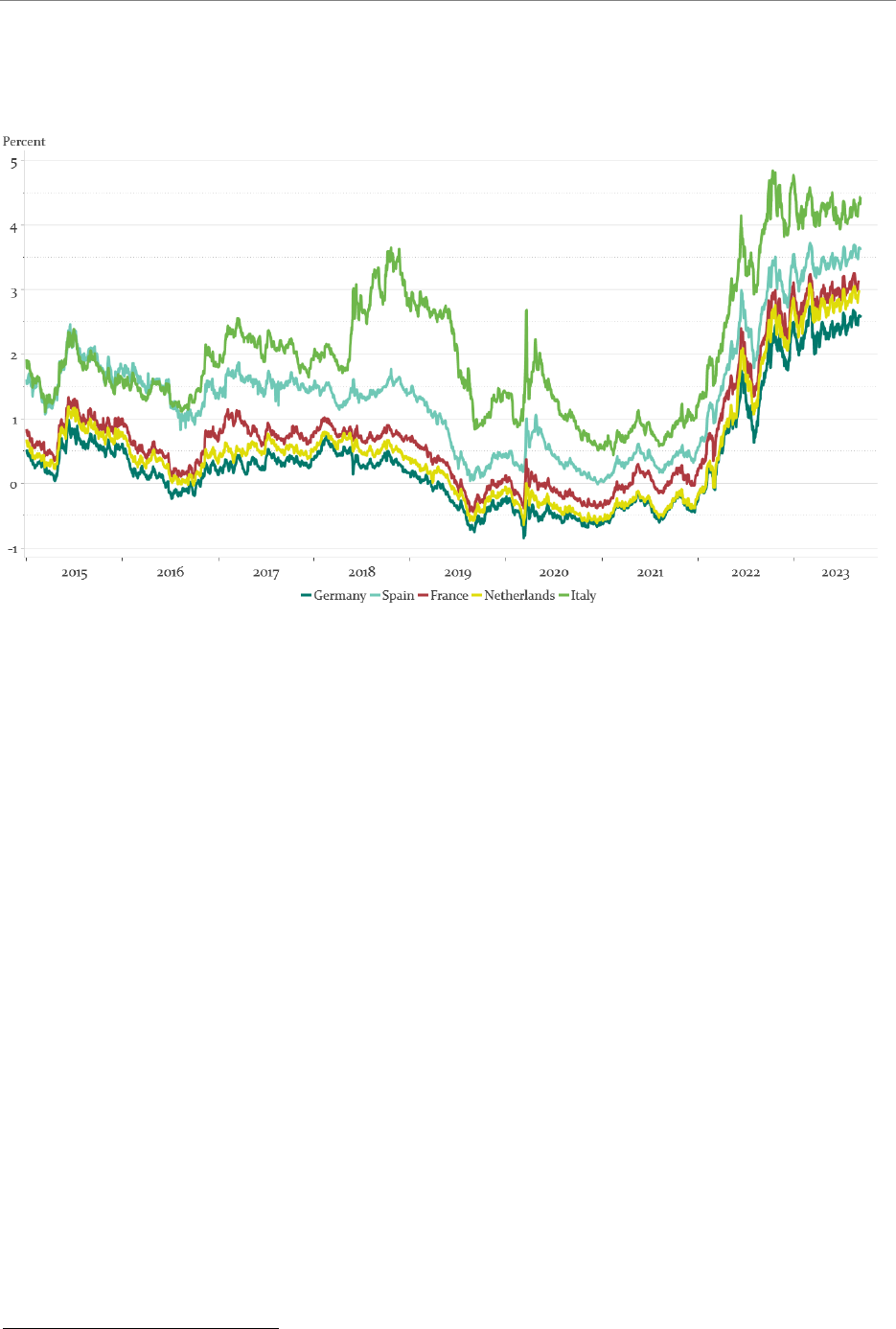
Achieving the right fiscal-monetary mix (in the context of the economic governance review)
PE 747.830 47
rates could trigger a systemic banking crisis, as the turmoil in Switzerland and the US demonstrated in
the spring of 2023.
Figure 1: Government benchmarks, 10-year, yield
Source: Eurostat.
Note: Germany, France, Italy, Spain, Netherlands are represented as the largest economies in the euro area, as measured
by their 2021 GDP in US-dollars.
It is important to consider that this monetary tightening has very different regional effects, as interest
rates and risk premiums react differently due to the very heterogeneous public debt levels; they
typically rise more strongly and non-linearly in the highly indebted countries (Bernoth, 2012). Between
2020 and 2021, ten-year nominal government bond yields reached historic lows and were even
negative in the Netherlands and Germany. At the beginning of 2022, even before the ECB's first interest
rate hike in July 2022, yields in the main euro area economies rose sharply at the same time, reflecting
market expectations of ECB intervention (Figure 1). At the end of August 2023, bond yields in individual
countries ranged from 2.48% (Germany) to 4.13% (Italy), remaining relatively stable since the end of
2022. Although long-term government bond yield spreads widened slightly compared to Germany at
the beginning of 2022, risk premiums currently appear to have little impact on bond yields. This is
mainly due to the announcement of the TPI in July 2022. As a result of these rate hikes, the interest-
related costs of public debt servicing have risen since the sharp increase in the key interest rate.
Moreover, the extraordinary fiscal measures implemented by governments to cushion the economic
effects of the COVID-19 crisis have led to a sharp increase in public deficits and a record level of
sovereign debt in most euro area Member States in 2020.
43
Thus, the public debt in the euro area
reached 97.2% of gross domestic product (GDP) in 2020 before decreasing slightly to 91.5% in 2022.
While all euro area countries saw a rebound in their public debt in 2020, recent developments are
highlighting growing debt disparities within the euro area (Figure 2). Where Estonia's debt-to-GDP
ratio reached just 18.4% in 2022 (up by around 10 percentage points since 2019), Greece's now stands
at 171.3% (down by more than 9 percentage points since 2019). In total, in 2022, only eight countries
43
Only Germany, Ireland, Latvia, Malta, Netherlands, Austria, and Slovenia did not reach an historic high in their debt-to-GDP ratio in 2020.
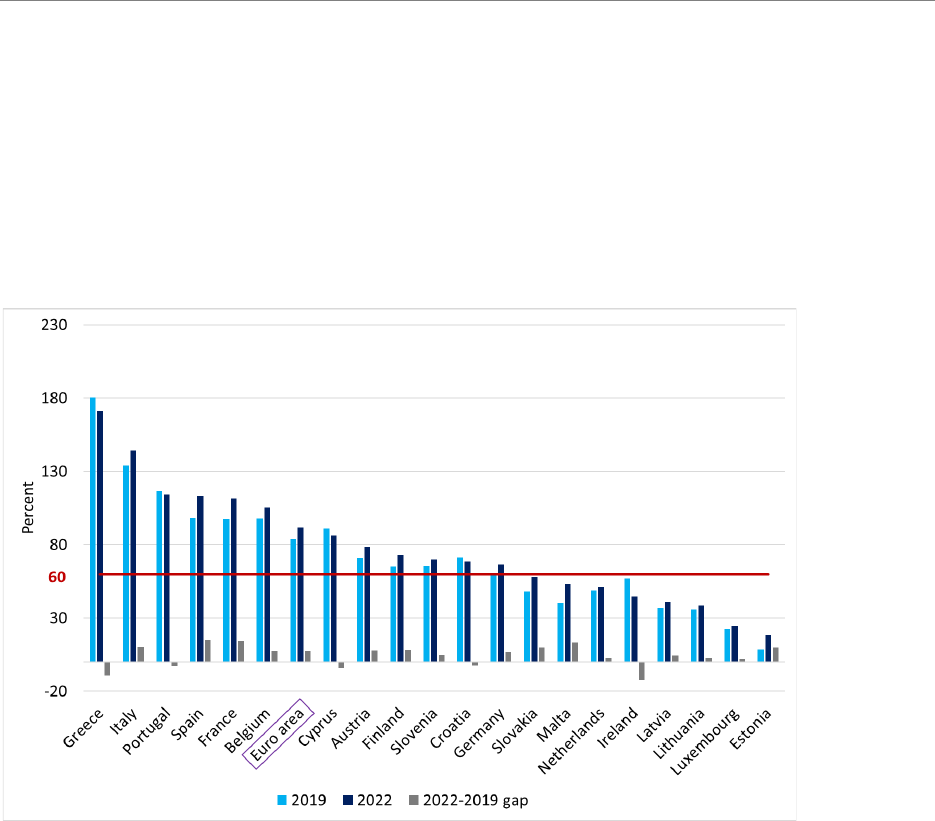
IPOL | Economic Governance and EMU Scrutiny Unit (EGOV)
48 PE 747.830
have public debt ratios below 60% and five countries have reduced their debt ratios compared with
2019 despite the significant economic impact of the COVID-19 crisis (Croatia, Cyprus, Greece, Ireland,
and Portugal). The Debt Sustainability Monitor 2022 (European Commission, 2023b), which gives an
insight into fiscal sustainability risk encountered by EU Member States, estimated the fiscal risk to be
overall low in the short-term, before becoming high or medium for most countries in the medium- and
long-term. Especially in an environment of higher inflation, this situation poses the risk of “fiscal
dominance” emerging, compromising the ability of single monetary policy to adequately fulfil its
primary price stability objective.
Figure 2: General gross debt in % of GDP
Source: Eurostat.
Note:
The horizontal line of 60% of GDP indicates the reference value for government debt as specified in the Maastricht
Treaty.
To strengthen the efficiency of tightening monetary policy and to avoid adding upward inflationary
pressures, the euro area fiscal stance has becoming more restrictive since 2023, although there are
significant disparities between countries, as highlighted in the Eurogroup statement of 13 July 2023,
on the fiscal stance for the euro area for 2024 (European Council, 2023). While the emergency fiscal
response measures adopted during the COVID-19 pandemic have already largely expired, falling
energy prices should allow euro area governments to progressively phase out the support measures
implemented to counteract the economic effects of the war in Ukraine (especially high energy costs,
supply chain disruptions).
The upcoming contractionary fiscal impulse in the euro area is warranted to ensure a gradual decline
in deficits and high public debt over time. Both remain well above their pre-pandemic levels, while
rising interest rates will – although only progressively – weigh on the cost of servicing public debts.
Thus, the fiscal strategy of Member States should restore fiscal buffers to secure debt sustainability.
At the same time, fiscal policy measures aimed at increasing economic growth over the medium term
by boosting the supply side of the economy are being implemented in most euro area countries. These
fiscal policies are supported in part by private and public funds but also through the NextGenerationEU
programme, via its core element: the Recovery and Resilience Facility. With this temporary instrument,

Achieving the right fiscal-monetary mix (in the context of the economic governance review)
PE 747.830 49
the European Union is providing financial support to Member States to foster investments in ecological
and digital transformation over the 2021-2026 period.
44
The relation between fiscal policy and inflation is not straightforward. Indeed, the impact of fiscal
measures on inflation depends on various factors, notably the type and the size of the fiscal impulse
(change in government spending or tax rates, discretionary fiscal policies - targeted or not, side effect
on government deficit, demand- or supply-side measures), specific national features (level of debt,
position in the business cycle), the global economic and geopolitical context, and the monetary policy
stance.
45
Some of the temporary discretionary fiscal measures taken in the euro area at the beginning
of the war in Ukraine to cushion rising energy costs, such as indirect tax cuts or price caps, are estimated
to have contributed to reducing inflationary pressures in 2022 and 2023, although the effect is
mitigated by the discontinuation in 2022 of the subsidies to households and businesses intended to
counter the impact of the health crisis (Bankowski, 2023). However, these direct energy support
measures should increase inflation in 2024 and 2025 as most of them expire in 2023. In addition, direct
measures to support household income adopted by several euro area governments, such as public
sector wage rises, indexation of social benefits to inflation, and cash transfers, will weigh on inflation
with some delay as they are gradually transmitted to households' nominal disposable income and,
therefore, increase aggregate demand.
46
Although the implementation of the structural supply-side
reforms at the EU level has a stimulating effect on the economy by increasing public expenditure, the
overall impact on inflation in the euro area is likely to be limited in the medium term.
47
However, given
the complexity and size of the fiscal measures adopted, the ECB needs to closely monitor their impact
on inflation and take them into account in its decision-making.
44
See Bönke and al. (2023), pp. 296-297 for more details on the NextGenerationEU programme.
45
See Checherita-Westphal and al. (2023), pp. 15 ff.; See ECB (2021), box 6 entitled “Fiscal policy and inflation in the euro area: a VAR-
based analysis”; See IMF (2023), Chapter 2.
46
See ECB (2023), box 9 entitled “Update on euro area fiscal policy responses to the energy crisis and high inflation”.
47
See Bankowski (2022), pp. 33 ff.

IPOL | Economic Governance and EMU Scrutiny Unit (EGOV)
50 PE 747.830
4. ECB “QUASI-FISCAL” MEASURES
The interaction between monetary and fiscal policies is particularly relevant in the discussion of the
ECB's unconventional monetary policy measures, primarily the large-scale asset purchases also called
Quantitative Easing (QE) given their “quasi-fiscal” effects. A central bank activity can be considered to
have a “quasi-fiscal” component or effect if it has a significant impact on the government accounts
and/or affects other aspects of fiscal policy (taxes, spending, financing), either immediately or in the
future. This includes, for example, activities that result in financial losses for the central bank, which
ultimately must be borne by governments in the form of lower dividends or loss compensation. Central
bank activities can also impact fiscal policy if they affect the allocation of resources in the economy and
create distortions, or if they change the structure of government debt or the market for government
securities, thereby reducing the effectiveness of government debt management (Hooley et al., 2023).
During the Great Financial Crisis and the COVID-19 pandemic, the ECB applied a number of
unconventional monetary policy tools to address deflationary tendencies. This involved an
unprecedented expansion of central bank assets with quasi-fiscal characteristics:
• In 2010, the Securities Markets Programme (SMP), replaced by the Outright Monetary
Transactions (OMT) in 2012, was introduced to ease credit conditions by purchasing bonds on
the secondary market.
• The Targeted Longer-Term Refinancing Operations (TLTRO) announced in 2014 (TLTRO I), 2016
(TLRTO II) and 2019 (TLTRO III) provided banks with extended funding opportunities at
favourable conditions linked to the granting of loans to non-financial corporations and
households.
• Since October 2014, massive asset purchase programmes (APPs) have increased the size of the
ECB's balance sheet (Figure 2). In 2020, the ECB implemented another round of quantitative
easing with the Pandemic Emergency Purchase Programme (PEPP) to counter the effects of the
COVID-19 crisis.
48
On the whole, the unconventional measures were effective at stabilising financial and economic
conditions, easing financial market stress, and, thereby, also smoothing monetary policy transmission
(Cour-Thimann, 2013; Beckmann, 2020; BIS, 2019).
Combined with negative interest rates, large APPs
lowered both interest rates and the cost of borrowing, stimulated bank lending to businesses and
households, and encouraged consumption and economic activity (though the unintended effects of
APPs require further study). The real economy has also been supported through the exchange rate
channel, as currency depreciation induced by the expansion of the monetary base has improved the
competitiveness of businesses and fostered export recovery. In total, unconventional monetary
policies from 2014 boosted annual GDP growth in the euro area by 0.6 pp. and inflation by 0.4 pp., on
average, over the period 2015-2020 (Altavilla, 2021).
49
However, ECB unconventional monetary policy measures have increased financial risks on the
Eurosystem’s balance sheet (which has expanded significantly with QE), that may result in financial
losses for the ECB and the national central banks and, ultimately, the Member States’ governments and
taxpayers. Moreover, these monetary policy measures have relevant distributional effects which are
traditionally limited to, and characteristic of, fiscal policy (Dossche at al., 2021; Becker at al., 2015;
European Parliament, 2015).
Yet, the ECB has complete operational autonomy in the implementation
48
See the European Central Bank website for more details on the different monetary policy instruments.
https://www.ecb.europa.eu/mopo/implement/html/index.en.html
49
See Beckmann and al. (2020), pp. 14-15, for an overview of the range of estimated effects of unconventional monetary policy on GDP
growth and inflation in the euro area from various studies.

Achieving the right fiscal-monetary mix (in the context of the economic governance review)
PE 747.830 51
of unconventional monetary policies and there is no involvement of the fiscal authority in their design
and implementation. Thus, in order to minimise these effects, unconventional monetary policy
instruments should only be used for limited periods of time.
Figure 3: Introduction of quantitative easing from 2014 by the European Central Bank
Source: European Central Bank.
Note: The euro area government bond yield benchmarks are calculated on the basis of national bond yields weighted by
outstanding amounts of government debt in each maturity bucket.
4.1. Legal analysis of ECB “quasi fiscal” measures
From a legal point of view, “quasi-fiscal” monetary policy measures are problematic in terms of: (a)
competence, (b) principles underlaying the monetary policy legal framework, and (c) financial and
institutional independence.
First, monetary policy measures are characterised by their primary objective to maintain price stability.
However, the fiscal condition/state of Member States (economic and financial imbalances and
sovereign debt ratios) influence the transmission of monetary policy measures. This notwithstanding,

IPOL | Economic Governance and EMU Scrutiny Unit (EGOV)
52 PE 747.830
the ECB's price stability mandate does not provide the ECB with a competence to address disruptions
of monetary policy transmission that are rooted in the fiscal and economic situation of Member States
and which rest within their jurisdictional domain. While any economic and financial imbalances as well
as sovereign debt ratios inevitably affect monetary policy transmission, the ECB is not competent to
address any causes that directly or indirectly impede its price stability mandate. These causes partly
relate to issues that are firmly rooted in the fiscal and economic situations and within the competence
of the Member States. The ECB only has a secondary or contributory competence to support the
economic policies of the Member States, i.e. the ECB can only support the policies pursued by other
actors and institutions.
50
Second, while distributional effects of monetary policy measures are inherent to any policy measure,
for example, traditional interest rate policy, selective measures that directly privilege specific market
participants, certain Member States, or certain financial or non-financial institutions, are generally not
foreseen within the EU monetary policy framework. Such measures with highly distributional effects
are only allowed in very narrowly defined cases that rely on monetary reasons and not on economic,
social, or other preferences.
The EU monetary policy framework also rests on the principle that the ECB may only conduct monetary
policy operations with solvent counterparties and on the basis of adequate collateral. Even in crisis
situations, when national central banks act as lender of last resort (LOLR), it is a basic principle that they
can only lend money to credit institutions that are solvent, but experience liquidity problems and only
against sufficient collateral. These preconditions respond to two purposes: (i) to distinguish monetary
policy measures from fiscal measures, since it is the task and the competence of fiscal authorities to
inject capital into insolvent institutions, resulting in direct distribution of resources; and (ii) to safeguard
the ECB from incurring losses, which is important with regard to the ECB's financial and institutional
independence (see also Rogoff, 2021).
The third aspect to consider is that the independence of the ECB cannot be compromised by fiscal and
financial considerations. In a situation of so called “fiscal dominance” and/or “financial dominance”, the
ECB might depart from a monetary policy strategy that might be adequate in terms of price stability.
4.2. TPI and its role in preventing future fragmentation of sovereign
bond markets
In reaction to the fragmentation of the sovereign bond markets in the euro area, the ECB Governing
Council announced its new anti-fragmentation tool, named the Transmission Protection Instrument
(TPI) on 21 July 2022. The TPI aims to ease potential bond market fragmentation with secondary market
purchases of securities issued in jurisdictions experiencing a deterioration in financing conditions not
warranted by country-specific fundamentals. According to the press release, the TPI aims to support
the effective transmission of monetary policy in the case of "unwarranted, disorderly market dynamics
that pose a serious threat to the transmission of monetary policy across the euro area" by selective
sovereign bond purchases (ECB, 2022).
The TPI faces some legal and economic challenges with regard to its conformity with the ECB mandate
and its monetary policy competence, which we analysed in depth in a previous paper.
51
While the aim
of TPI – ensuring an “effective transmission of monetary policy” – is no doubt a necessary prerequisite
in the pursuit of a price stability-oriented monetary policy, this alone does not suffice to prove that the
50
Art.127 (1) 2 TFEU states: “Without prejudice to the objective of price stability, the ESCB shall support the general economic policies in
the Union (…)”.
51
See in detail Bernoth et al. (2022).

Achieving the right fiscal-monetary mix (in the context of the economic governance review)
PE 747.830 53
measure falls within the ECB's price stability mandate. Currently, with surging inflation, the ECB is trying
to curb surging inflation by increasing interest rates. This puts a heightened burden of justification on
the ECB to explain how further asset purchases – an expansionary monetary policy – would fit within
the overall monetary policy stance of fighting inflation, should TPI be activated. It is only if market
failures are identified as the cause for the financial fragmentation of sovereign bond yield spreads that
the ECB allowed to take such selective and targeted measures to address these causes.
Fiscal support for highly-indebted Member States that struggle with higher, yet justified, risk premia is
not a task for the ECB and not within the monetary policy domain. It rather falls within the fiscal domain
and within the remit of the competence of the Member States according to the respective democratic
processes in place. Such a decision should be subject to political and public scrutiny. As the ECB stated
with regard to the TPI, the deterioration in financing conditions potentially hampering monetary policy
transmission, which TPI might be able to address, may "not [be] warranted by country-specific
fundamentals" (ECB, 2022). This is in line with the European Court of Justice (ECJ)'s ruling on OMT,
where it made clear that "the programme in question cannot be implemented in a way which would
bring about a harmonisation of the interest rates applied to the government bonds of the Member
States of the euro area regardless of the differences arising from their macroeconomic or budgetary
situation."
52
Moreover, activation of the TPI requires sound and sustainable budgetary and economic policies, as
stated in the eligibility criteria explained in the press release (ECB, 2022). However, as outlined also in
Bernoth et al. (2022), the institutional structure of the ECB is not well suited to assessing these criteria.
The monitoring of compliance with fiscal rules and the ultimate discretionary decision on whether a
Member State sufficiently fulfils the requirements of sound and sustainable fiscal and economic
policies may expose the ECB to political pressure and threaten its independence. The decision as to
whether the ECB should carry out such an assessment itself or whether this should be the responsibility
of external bodies (e.g. the European Stabilisation Mechanism and the International Monetary Fund)
therefore remains an important question to be clarified.
The ECB has not yet disclosed the method, benchmarks and criteria it will use to assess, whether bond
yield developments are “not warranted by country-specific fundamentals”. The provisions on how the
Governing Council will use the listed eligibility criteria as input to its decision-making process are very
non-specific and non-transparent and therefore allow for a certain degree of discretion.
The potential quasi-fiscal components of TPI and the corresponding legal challenges also become
apparent when considering the balance sheet implications. TPI interventions, if activated, would lead
to a further increase in the size of the Eurosystem's balance sheet if they are not sterilised by the sale of
other assets. If the Member State were not able to pay back its debt, the central bank would incur losses
on its balance sheet.
52
ECJ, Judgment of the Court of 16 June 2015, Case C-62/14, Gauweiler et al., ECLI:EU:C:2015:400, para. 113

IPOL | Economic Governance and EMU Scrutiny Unit (EGOV)
54 PE 747.830
5. THE NEW EU ECONOMIC GOVERNANCE ARCHITECTURE
Sustainable public finances are considered a prerequisite for a single monetary policy in the euro area
to be able to focus on its primary mandate of price stability, as well as for monetary and fiscal policy to
mutually support each other in their stabilisation function. An adequate governance structure in the
EU should create these conditions.
5.1. Legal foundations of the EU economic governance architecture
The EU economic governance framework, as laid out in the Treaties, provides a system of institutions
and procedures to coordinate economic policies of the Member States (see Art. 120f. TFEU) and aims
to monitor, prevent, and correct problematic economic trends that could weaken national economies
or negatively affect other EU countries. This framework has evolved over time, being and been refined
and reinforced.
53
The legal framework relies on the TFEU (Art. 120ff., 126 TFEU)
54
, the Stability and Growth Pact
55
(see
below), the European Semester (an annual cycle of economic, fiscal, employment and social policy
coordination) and the so-called six-pack and two-pack legislative reforms (additional secondary
legislation to strengthen the Stability and Growth Pact).
56
The European Commission monitors the
economic development in the euro area in order to detect potential problems and risks for economic
stability and competitiveness. To do this, it conducts regular assessments and forecasts, while also
producing an Annual Sustainable Growth Survey and the Alert Mechanism Report.
Prevention is a key pillar within EU economic governance as it aims to address economic problems
early on and prevent spill-over effects to other Member States. The Stability and Growth Pact (SGP)
plays an important role within the EU's prevention mechanism and requires the Member States to
pursue sound national fiscal policies by setting budgetary targets. The Macroeconomic Imbalance
Procedure (MIP), introduced in 2011 as part of the so called "six-pack" reform of the economic
governance, foresees, in the case of excessive imbalances in the economies of a Member State, that
said Member State is subject to enhanced monitoring and might even face sanctions. In addition, the
Treaty on Stability, Coordination and Governance (TSCG or the ‘fiscal compact’) sets standards for fiscal
policies by limiting the size of the structural deficit that a government may incur to 0.5% of GDP per
year and requires the establishment of automatic policies to correct significant transgressions.
57
Correction of economic imbalances and enforcement of the existing ruleset with the Excessive Deficit
Procedure (EDP) and the Excessive Imbalance Procedure (EIP) are a crucial part within the EU economic
governance framework.
58
Under EDP, if a national budget deficit exceeds 3% of GDP or if it fails to
reduce its excessive debts (i.e. is still above 60% of GDP), the Member State must commit to targets to
bring its excessive deficit or debt back down. The EU can also impose sanctions, such as fines that can
reach 0.2% of their GDP, if a Member State persistently fails to take adequate action.
Similarly, under the EIP of the EU’s MIP, a Member State experiencing excessive imbalances can be
required to submit Corrective Action Plans to address its situation and might likewise face fines if they
fail to sufficiently impose corrective measures.
53
See Lastra and Louis (2013), pp. 35 ff.
54
See Lastra (2015), pp. 293 ff.
55
See Lastra (2015), pp. 301 ff.; Lastra and Louis (2013), pp. 55 ff. with further references.
56
See Lastra and Louis (2013), pp. 66 ff., 144.
57
See Lastra and Louis (2013), pp. 144 ff.
58
See Lastra (2015), pp. 293, 298 ff., see also 231 ff.

Achieving the right fiscal-monetary mix (in the context of the economic governance review)
PE 747.830 55
5.2. Proposal to reform the EU economic governance rules
The EU fiscal framework has been criticised for being too rigid on the one hand and for not promoting
sufficient convergence on the other, with the result that several EU Member States lack the fiscal
capacity to ensure effective coordination in times of economic downturn. In response to the
inadequacies and complexities of the current economic governance architecture, the Commission in
April this year presented its new package of proposals to reform the EU’s economic governance rules.
The proposed new economic governance architecture aims to strengthen public debt sustainability
while promoting progress towards a green, digital, inclusive and resilient economy and making the EU
more competitive.
59
The cornerstones of the proposal are stronger national ownership, simpler rules
taking into account different fiscal challenges, facilitating reforms and investments for EU common
priorities, and providing for effective enforcement.
The EU economic governance reform consists of three legislative proposals: (i) a proposal to create a
new regime for the SGP with regard to its preventive aspects (the so called preventive arm regulation)
60
,
(ii) a proposal to strengthen the corrective elements of the SGP (the so called corrective arm
regulation)
61
and (iii) amendments regarding the requirements for the budgetary frameworks of the
Member States.
62
In particular, the proposal on the preventive arm allows Member States to set their multi-annual net
expenditure path on the basis of reform and investment commitments that they would detail in their
medium-term fiscal-structural plan. For Member States whose government debt is above the 60% of
GDP reference value or whose government deficit is above the 3% of GDP reference value, the
Commission would propose “technical trajectory for net expenditure covering a minimum adjustment
period of 4 years of the national medium-term fiscal-structural plan, and its possible extension by a
maximum of 3 years […]”. as guidance for the multi-annual trajectory for net expenditure
63
with a view
of maintaining debt levels on a downward path. The extension of fiscal adjustment by a maximum of
3 years would allow for a more gradual adjustment path if countries undertake reforms and
investments commitments in line with EU priorities.
The proposal responds to the long-standing criticism that the current fiscal surveillance indicators are
based on numerical variables that are very difficult to measure in real time, in particular, the structural
balance and potential output variables. This has resulted in the fiscal policy being often pro-cyclical
when it should have been counter-cyclical according to the information available to policy makers in
real time (Bernoth, 2015). Steering on the expenditure side is more transparent and less susceptible to
manipulation (Anderson and Minarik, 2006). Moreover, focusing on a medium-term approach rather
than year-to-year monitoring gives governments more flexibility to respond to unforeseen events and
cyclical fluctuations in public expenditure.
59
Proposal for a regulation of the European Parliament and of the Council on the effective coordination of economic policies and
multilateral budgetary surveillance and repealing Council Regulation (EC) No 1466/97, COM/2023/240 final; Proposal for a Council
regulation amending Council Regulation (EC) No 1467/97 on speeding up and clarifying the implementation of the excessive deficit
procedure, COM/2023/241 final; proposal for a Council directive amending Council Directive 2011/85/EU on requirements for
budgetary frameworks of the Member states, COM/2023/242 final.
60
Proposal for a regulation of the European Parliament and of the Council on the effective coordination of economic policies and
multilateral budgetary surveillance and repealing Council Regulation (EC) No 1466/97, COM/2023/240 final (so called preventive arm
regulation).
61
Proposal for a Council regulation amending Council Regulation (EC) No 1467/97 on speeding up and clarifying the implementation of
the excessive deficit procedure, COM/2023/241 final (so called corrective arm regulation).
62
Proposal for a Council directive amending Council Directive 2011/85/EU on requirements for budgetary frameworks of the Member
states, COM/2023/242 final (so called budgetary frameworks directive).
63
Proposal for a regulation of the European Parliament and of the Council on the effective coordination of economic policies and
multilateral budgetary surveillance and repealing Council Regulation (EC) No 1466/97, COM/2023/240 final, Art. 5.

IPOL | Economic Governance and EMU Scrutiny Unit (EGOV)
56 PE 747.830
Moreover, the new proposal foresees that independent national financial institutions should be given
a stronger role in monitoring the implementation by Member States of their national medium-term
fiscal-structural plans.
64
The proposals allow Member States to have more control over the design of their medium-term plans,
but also foresee a more stringent enforcement regime to ensure Member States deliver on the
commitments undertaken in their medium-term fiscal-structural plans. The excessive deficit procedure
for breaches of the 60% of GDP reference value is strengthened. For a Member State facing substantial
public debt problems, the degree of debt challenge will be considered a relevant factor for the
initiation of an excessive deficit procedure upon departure from the agreed net expenditure path.
65
64
Proposal for a regulation of the European Parliament and of the Council on the effective coordination of economic policies and
multilateral budgetary surveillance and repealing Council Regulation (EC) No 1466/97, COM/2023/240 final, Art. 22.
65
Proposal for a Council regulation amending Council Regulation (EC) No 1467/97 on speeding up and clarifying the implementation of
the excessive deficit procedure, COM/2023/241 final (so called corrective arm regulation).

Achieving the right fiscal-monetary mix (in the context of the economic governance review)
PE 747.830 57
6. IMPLICATIONS OF THE ECONOMIC GOVERNANCE REVIEW FOR
MONETARY POLICY
The economic governance review bears overall positive implications for the ECB's price-stability-
oriented monetary policy from an economic and legal perspective, as expressed in an official Opinion
by the ECB of 5 July 2023.
66
The proposed review establishes rules that monitor and restrict, where
necessary, fiscal deficits and helps to ensure that Member State's fiscal and economic situations can, at
least to a certain degree, converge, thus representing a precondition for a single monetary policy.
Likewise, it is important that national ownership of the framework, by setting national medium-term
fiscal structural plans, is strengthened to avoid situations where – due to a lack of fiscal capacity at the
Union level – the ECB might be de facto forced to address fiscal and economic imbalances in Member
States by means of monetary policy measures, which are outside of its mandate.
In general, rules that help delineate the responsibility of the ECB for ensuring price stability on the one
hand and the responsibility of the Member States for their fiscal and economic situation on the other
are essential for ensuring that monetary policy measures do not have “quasi-fiscal” effects of such a
scale and manner that they actually substitute fiscal measures. Therefore, the Governing Council's
decision to phase out unconventional monetary policy measures of a “quasi-fiscal” nature is welcome
and will help to reduce risks and increase transparency. It will protect the Eurosystem from interest rate
risks on large holdings of securities as policy normalises and will help reduce distortionary effects on
public and private sector assets. This will also reduce reputational risk for the ECB. However, it is worth
noting that the recent process of quantitative tightening has been very gradual and will continue for
several years to avoid market disruption. The ECB therefore faces a difficult trade-off.
This delineation and the avoidance of the wrong type of monetary-fiscal policy mix is not only
important to ensure that the ECB stays within its mandate, as laid down in Art. 127 TFEU, but also to
ensure that the ECB keeps its institutional and financial independence. Economic and fiscal measures
must be taken by the competent and democratically accountable institutions and actors, as they bear
an important social dimension. The existing forms of coordination between the ECB and economic and
fiscal policy makers are important to ensure an adequate level of information and better understanding
between both policy fields.
The current reform of the EU governance framework provides an opportunity to address the
shortcomings that have emerged over the past decades, leading to a situation where optimal
coordination of fiscal and monetary policies has been hampered. A well-functioning EU governance
framework that leads to effective fiscal consolidation and gradual debt reduction in the years ahead,
especially in the highly indebted countries, facilitates the ECB's monetary policy in several respects. In
the current high-inflation environment, a reduction in fiscal stimulus or fiscal support targeted at only
individual sectors in need reduces inflationary pressures (Beyer et al., 2023). This would allow for a more
gradual and moderate monetary tightening, thereby reducing financial stability risks posed by a rapid
and widespread increase in interest rates. Furthermore, fragmentation risks of European bond yields
(and spreads) would be mitigated, making the use of the controversial TPI less necessary for the ECB.
A closer look, however, shows that the current reform proposal, while eliminating many of the
identified shortcomings (see sub-chapter 4.2), still lacks transparency and leaves too much room for
discretion, which may once again open the door to clientelism and endless discussions. For instance,
the proposal says that “The national medium-term fiscal-structural plan shall ensure the fiscal
66
Opinion of the European Central Bank of 5 July 2023 on a proposal for economic governance reform in the Union (CON/2023/20), OJ C
290, 18.8.2023, pp. 17–25.

IPOL | Economic Governance and EMU Scrutiny Unit (EGOV)
58 PE 747.830
adjustment necessary to put or keep public debt on a plausibly downward path by the end of the
adjustment period at the latest, or remain at prudent levels, and to bring and maintain the government
deficit below the 3% of GDP reference value over the medium term “
67
How exactly is the "plausible
downward path" defined and how long is the "medium term"?
Moreover, the governments' medium-term fiscal-structural plans, and also the Commission's fiscal
trajectories, are based on medium-term projections of public debt. While the proposal says that the
Commission must disclose the underlying framework for these projections and its results, there is
always a degree of discretion in the assumptions underlying a projection model and its design. The
proposal states that "when Member States use assumptions in their medium-term fiscal-structural plan
that differ from the Commission’s standard medium-term debt projection framework, they should
explain and duly justify the differences in a transparent manner and based on sound economic
arguments. In particular, the debt projections at unchanged policy to be included in the plan should
be consistent and comparable with the Commission projections."
68
But no one can say with certainty
which model is the right one, and the question is why the Commission does not impose one from the
outset to avoid discussion.
In contrast to the previous governance structure, which was mainly based on negotiations between
Member States, the new proposal places more emphasis on negotiations between the European
Commission and each individual Member State. Whether this vertical structure will improve
compliance, however, is an open question. As Fuest (2023) argues, if countries do not want to comply
with the European Commission's requirements, it will be easy for them to argue, for example, that the
Commission is a technocratic institution with less democratic legitimacy than their national
parliaments.
There is still time to remedy these deficiencies in the coming months, and this should be used to put
EMU on a more stable position in the long term, able to exploit the synergistic effects between
monetary and fiscal policy.
67
See Proposal for a regulation of the European Parliament and of the Council on the effective coordination of economic policies and
multilateral budgetary surveillance and repealing Council Regulation (EC) No 1466/97, COM/2023/240 final, Art. 6 and 12.
68
Proposal for a regulation of the European Parliament and of the Council on the effective coordination of economic policies and
multilateral budgetary surveillance and repealing Council Regulation (EC) No 1466/97, COM/2023/240 final, p. 14.

Achieving the right fiscal-monetary mix (in the context of the economic governance review)
PE 747.830 59
7. CONCLUSION
The EU Treaties establish a formal separation of competences between a centralised monetary policy
and decentralised fiscal policies. Despite their different jurisdictional domains, fiscal and monetary
policy are highly interdependent. While this close interaction has led to tensions in the past, monetary
and fiscal policy have been largely aligned and mutually supportive during the COVID-19 crisis.
Since 2021 with the return of inflation, tensions are again visible in the monetary-fiscal policy mix.
Indeed, while the ECB started tightening monetary policy in 2022, with the aim of bringing inflation
down to close to 2% in the medium term, most Member States have adopted supportive fiscal
measures designed to reduce the impact of rising energy costs on households and businesses. This
massive fiscal support is expected to lead to inflationary pressures over the next two years (Bankowski,
2023), partly as a result of the withdrawal of fiscal measures with direct dampening effect on energy
prices as indirect tax cuts, but also due to the lagged upward effect on inflation of household income
support measures. On the other hand, the “quasi-fiscal” monetary measures implemented by the ECB
in recent years, especially the large-scale asset purchase programmes, including the announced, but
not yet activated, TPI, have, by definition, a significant impact on the government accounts and/or
affect other aspects of fiscal policy (taxes, spending, financing), either directly or in the future. “Quasi-
fiscal” monetary policy measures are also problematic from a legal point of view since they partly over-
stretch the mandate of the ECB.
The Commission has presented a proposal to reform the EU economic governance framework. The
proposed new framework aims to ensure greater national ownership and simpler rules that account
for the different fiscal challenges, thereby facilitating reforms and investment for EU priorities. While
the proposal addresses many of shortcomings identified, too much discretion is still left to the
Commission and Members States in interpreting the rules.
In the coming years, it will be crucial to re-establish better coordination between monetary and fiscal
policy. This requires sound public finances to provide sufficient fiscal room for manoeuvring. Moreover,
the ECB should only resort to “quasi-fiscal” monetary policy measures in exceptional cases, such as
when the interest rate level has reached the zero lower bound or when there are divergences in
government bond yields between Member States resulting from market excesses that jeopardise a
single monetary policy. The current reduction in the balance sheet of the Eurosystem through the
gradual phasing out of the bond purchase programmes and the TLTROs is therefore to be welcomed.

IPOL | Economic Governance and EMU Scrutiny Unit (EGOV)
60 PE 747.830
REFERENCES
• Altavilla, C., Lemke, W., Linzert, T., Tapking, J. and von Landesberger, J. (2021). “Assessing the
efficacy, efficiency and potential side effects of the ECB’s monetary policy instruments”. Occasional
Paper Series No. 278. https://www.ecb.europa.eu/pub/pdf/scpops/ecb.op278~a1ca90a789.en.pdf
• Anderson, B. and Minarik J.J. (2006). ”Design Choices for Fiscal Policy Rules”, OECD Journal on
Budgeting 5(4): 159-208. https://www.oecd.org/gov/budgeting/43479409.pdf
• Antpöhler, C. (2012). “Emergenz der europäischen Wirtschaftsregierung – Das Six Pack als Zeichen
supranationaler Leistungsfähigkeit“. Zeitschrift für ausländisches öffentliches Recht und Völkerrecht,
Vol.72(2), pp.353–393.
• Bankowski, K., Bouabdallah, O., Domingues Semeano, J., Dorrucci, E., Freier, M., Jacquinot, P.,
Modery, W., Rodríguez-Vives, M., Valenta, V. and Zorell, N. (2022). “The economic impact of Next
Generation EU: a euro area perspective”. ECB Occasional Paper Series No. 279.
https://www.ecb.europa.eu/pub/pdf/scpops/ecb.op291~18b5f6e6a4.en.pdf
• Bankowski, K., Bouabdallah, O., Checherita-Westphal, C., Freier, M., Jacquinot P. and Muggenthaler,
P. (2023). „Fiscal Policy and high inflation”. ECB Economic Bulletin, Issue 2 - Article.
https://www.ecb.europa.eu/pub/pdf/ecbu/eb202302.en.pdf
• Beckmann, J., Fiedler, S., Gern, K.-J., Kooths, S., Quast, J. and Wolters, M. (2020). “The ECB’s Asset
Purchase Programmes: Effectiveness, Risks, Alternatives”. Monetary Dialogue Papers.
https://www.europarl.europa.eu/cmsdata/211391/2_KIEL%20final.pdf
• Bernoth, K., Dietz, S., Ider, G. and Lastra, R. (2022). “The ECB’s Transmission Protection Instrument: a
legal & economic analysis”. Study for the Committee on Economic and Monetary Affairs, Policy
Department for Economic, Scientific and Qualify of Life Policies, European Parliament, Luxemburg.
https://www.europarl.europa.eu/cmsdata/253891/QA-07-22-986-EN-N.pdf
• Bernoth, K., Hughes Hallett, A. and Lewis, J. (2015). “The cyclicality of automatic and discretionary
fiscal policy: What can real time data tell us?” Macroeconomic Dynamics, 2015, Volume 19(1), pp.
221-243.
• Bernoth, K., von Hagen, J. and Schuknecht, L. (2012). „Sovereign risk premia in the European
government bond market”. Journal of International Money and Finance, 2012, Volume 31(5), pp.
975-995.
• Beukers, T. (2013). “The new ECB and its relationship with the Eurozone Member States: between
central bank independence and central bank intervention”. Common Market Law Review, Vol.50(6),
pp.1579–1620.
• Beyer, R., Duttagupta, R., Fotiou, A., Honjo, K., Horton, M., Jakab, Z., Linde, J., Nguyen, V., Portillo, R.,
Suphaphiphat, N, and Zeng, L. (2023). “Shared Problem, Shared Solution: Benefits from Fiscal-
Monetary Interactions in the Euro Area”, IMF Working Paper WP/23/149.
https://ideas.repec.org/p/imf/imfwpa/2023-149.html
• Bini Smaghi and L., Casini, C. (2002). “Monetary and Fiscal Policy Co-operation: Institutions and
Procedures in EMU”. Journal of Common Market Studies, Vol.38(3), pp.375–391.
• Bank of International Settlements (2019). “Unconventional monetary policy tools: a cross-country
analysis”. Committee on the Global Financial System Papers No. 63.
https://www.bis.org/publ/cgfs63.pdf

Achieving the right fiscal-monetary mix (in the context of the economic governance review)
PE 747.830 61
• BIS (2023). Bank for International Settlements Annual Economic Report 2023,
https://www.bis.org/publ/arpdf/ar2023e.pdf
• Bodea, C. and Huemer, S. (2010). “Dancing together at arm’s length? – the interaction of central
banks with governments in the G7”. ECB Occasional Paper Series No. 120.
https://www.ecb.europa.eu/pub/pdf/scpops/ecbocp120.pdf
• Bönke, T. and al. (2023). “DIW-Konjunkturprognose: Deutsche Wirtschaft kämpft sich aus der
Winterrezession“. DIW Wochenbericht No. 24.
https://www.diw.de/de/diw_01.c.875334.de/publikationen/wochenberichte/2023_24_2/diw-
konjunkturprognose__deutsche_wirtschaft_kaempft_sich_aus_der_winterrezession.html"
• Checherita-Westphal, C., Leiner-Killinger, N. and Schildmann, T. (2023). “Euro area inflation
differentials: the role of fiscal policies revisited”. Working Paper Series No. 2774.
https://www.ecb.europa.eu/pub/pdf/scpwps/ecb.wp2774~aef6347c1e.en.pdf
• Clayes, G. and al. (2015). “ECB Quantitative Easing (QE): What are the Side Effects ?”. Monetary
Dialogue Papers.
https://www.europarl.europa.eu/cmsdata/105464/IPOL_IDA(2015)587287_EN.pdf
• Cour-Thimann, P. and Winkler, B. (2013). “The ECB’s non-standard monetary policy measures: the
role of institutional factors and financial structure”. ECB working paper Series No. 1528.
https://www.ecb.europa.eu/pub/pdf/scpwps/ecbwp1528.pdf
• D. Bordo, M. and D. Levy, M. (2020). “Do enlarged fiscal deficits cause inflation: the historical record”.
NBER Working Paper No. 28195. https://www.nber.org/papers/w28195
• Dall’Orto Mas, R., Vonessen, B.,Fehlker, C. and Arnold, K. (2020). “The case for central bank
independence. A review of key issues in the international debate”. ECB Occasional Paper Series
No. 248. https://www.ecb.europa.eu/pub/pdf/scpops/ecb.op248~28bebb193a.en.pdf
• Degenhart, C. (2013). “Missachtung rechtlicher Vorgaben bei der Umsetzung der Währungsunion“,
in: Möllers/Zeitler (Ed.), “ Europa als Rechtsgemeinschaft – Währungsunion und Schuldenkrise“,
Mohr Siebeck, pp.85–100.
• Dossche, M., Slačálek, J. and Wolswijk, G. (2021). “Monetary policy and inequality”. ECB Economic
Bulletin Series, Issue 2 – Article 1. https://www.ecb.europa.eu/pub/pdf/ecbu/eb202102.en.pdf
• European Central Bank (2003). “The relationship between monetary policy and fiscal policies in the
euro area”. Monthly Bulletin February 2003.
https://www.ecb.europa.eu/pub/pdf/mobu/mb200302en.pdf
• European Central Bank (2021a). “ECB’s governing council approves its new monetary policy
strategy”. Press Release.
https://www.ecb.europa.eu/press/pr/date/2021/html/ecb.pr210708~dc78cc4b0d.en.html
• European Central Bank (2021b). “Monetary-fiscal policy interactions in the euro area”, box entitled
“Fiscal policy and inflation in the euro area: a VAR-based analysis”. Occasional Paper Series No. 273.
https://www.ecb.europa.eu/pub/pdf/scpops/ecb.op273~fae24ce432.en.pdf
• European Central Bank (2022). “The Transmission Protection Instrument”. Press release.
https://www.ecb.europa.eu/press/pr/date/2022/html/ecb.pr220721~973e6e7273.en.html
• European Central Bank (2023). “Economic, financial and monetary developments”. ECB Economic
Bulletin Series, Issue 2. https://www.ecb.europa.eu/pub/pdf/ecbu/eb202302.en.pdf

IPOL | Economic Governance and EMU Scrutiny Unit (EGOV)
62 PE 747.830
• European Commission (2023a). “Economic Governance Review. Building an economic governance
framework fit for the challenges ahead”.
https://economy-finance.ec.europa.eu/economic-and-
fiscal-governance/economic-governance-review_en
• European Commission (2023b). “Debt Sustainability Monitor 2022”. European Economy Institutional
Paper 199.
https://economy-finance.ec.europa.eu/publications/debt-sustainability-monitor-
2022_en
• European Council (2023). “Eurogroup statement on the euro area fiscal stance for 2024”. Press
release.
https://www.consilium.europa.eu/en/press/press-releases/2023/07/13/eurogroup-
statement-on-the-euro-area-fiscal-stance-for-2024/
• Fuest, C. (2023). “The Reform of the EU Economic Governance Framework, Market Discipline and
the Role of the ECB”. EconPol Forum 24 (4), 05-10.
• von Hagen, J. and Mundschenk, S. (2002). „Fiscal and Monetary Policy Coordination in EMU”.
Central Bank of Chile Working Papers No.194.
https://www.bcentral.cl/documents/33528/133326/DTBC_194.pdf
• Hetges, S. (2015). “Die Konstruktionsfehler der Europäischen Währungsunion: Aktuelles
Krisenmanagement und Reformbedarf“. Igel Verlag.
• Hooley, J., Khan, A., Lattie, C., Mak, I., Salazar, N., Sayegh, A. and Stella, P. (2023). "Quasi-Fiscal
Implications of Central Bank Crisis Interventions", IMF Working Paper, WP/23/114, p. 7
• Horn, N. (2011). “Die Reform der Europäischen Währungsunion und die Zukunft des Euro“, Neue
Juristische Wochenschrift, Vol.64(20), pp.1398 – 1404.
• International Monetary Fund (2023). “Fiscal Monitor: On the path to policy normalization”.
https://www.imf.org/en/Publications/FM/Issues/2023/04/03/fiscal-monitor-april-2023
• Klein, M. and Winkler, R. (2021). “The government spending multiplier at the zero lower bound:
International evidence from historical data”. Journal of Applied Econometrics, 36(6), pp. 744–759.
https://doi.org/10.1002/jae.2835
• Konrad, K., Otte, M., Belke, A., Hefeker, C., Kämmerer, J., Beck, H. and Wentzel, D. (2010).
“Schuldenkrise in der Europäischen Union”. Wirtschaftsdienst, Vol.90(3), pp.143–171.
• Lastra, R. (2015). “International Financial and Monetary Law”. Oxford University Press.
• Lastra, R. and Louis, J. (2013). “European Economic and Monetary Union: History, Trends and
Prospects”. Yearbook of European Law, Vol.32(1), pp.1–150.
file:///C:/Users/asus/Downloads/SSRN-
id2244764-3.pdf
• Manzke, B. (2015). “Exkurs: Die Wechselwirkungen zwischen Geld- und Finanzpolitik“, in:
Gatzer/Schweisfurth (Ed.), “Öffentliche Finanzwirtschaft in der Staatspraxis“, Schriften zur
öffentlichen Verwaltung und öffentlichen Wirtschaft, Vol.231, pp. 135–154.
• Ohler, C. (2019). “Integration durch Recht und ihre Grenzen: das Beispiel der Währungsunion“, in:
Baums/Remsperger/Sachs/Wieland/Siekmann (Ed.), “ Zentralbanken, Währungsunion und stabiles
Finanzsystem: Festschrift für Helmut Siekmann“, Duncker und Humblot, pp.3–18.
• Rogoff, K. (2021). “Risks to Central Bank Independence”, in: Pastén/Reis (Ed.), “Independence,
Credibility and Communication of Central Banking”, Central Bank of Chile, Series on Central Banking,
Analysis and Economic Policies, Vol.28, pp.27–54.

Achieving the right fiscal-monetary mix (in the context of the economic governance review)
PE 747.830 63
https://repositoriodigital.bcentral.cl/xmlui/bitstream/handle/20.500.12580/6142/Cap%c3%adtulo
_03_vol.28.pdf?sequence=1&isAllowed=y
• Sgaravatti, G., Tagliapietra, S., Trasi, C. and Zachmann, G. (2021). “National policies to shield
consumers from rising energy prices", Bruegel Datasets, first published 4 November 2021, available
at https://www.bruegel.org/dataset/national-policies-shield-consumers-rising-energy-prices.
• Seidel, M. (2000). “Konstitutionelle Schwächen der Währungsunion“, Europarecht, Vol.35(6),
pp.861–878.
• Siekmann, H. (2013). “Art.119 AEUV”, in: Siekmann (Ed), „Kommentar zur Europäischen
Währungsunion“. Mohr Siebeck.
• Smets, F. (2012). “Imbalances In The Euro Area and the ECB’s Response”, in: Allen/Carletti/Simonelli
(Ed.), “Governance for the Eurozone: integration or disintegration?”, FIC Press, pp.41–60.
• Thiele, A. (2013). “Das Mandat der EZB und die Krise des Euro“. Mohr Siebeck.
• Woodford, M. (2022). "Effective Demand Failures and the Limits of Monetary Stabilization Policy".
American Economic Review 112 (5), pp. 1475-1521.
https://www.aeaweb.org/articles?id=10.1257/aer.20201529

IPOL | Economic Governance and EMU Scrutiny Unit (EGOV)
64 PE 747.830

Big central banks and big
public debts: The next
challenges
Charles WYPLOSZ

IPOL | Economic Governance and EMU Scrutiny Unit (EGOV)
66 PE 747.830
Abstract
Like most advanced economies, the euro area emerges from a
series of historical shocks with larger public debts, a sizeable
increase in the already large balance sheets of the Eurosystem
central banks, and intensified links between fiscal and monetary
policies. The governments and the ECB must now undo what
they did. Corrective action must not wait, if only because other
shocks may again unexpectedly occur. The paper also presents a
procedure to cut public debts.
This document was provided by the Economic Governance and
EMU Scrutiny Unit at the request of the Committee on Economic
and Monetary Affairs (ECON) ahead of the Monetary Dialogue
with the ECB President on 25 September 2023.

Achieving the right fiscal-monetary mix (in the context of the economic governance review)
PE 747.830 67
CONTENTS
LIST OF ABBREVIATIONS 68
LIST OF FIGURES 69
LIST OF TABLES 69
EXECUTIVE SUMMARY 70
INTRODUCTION 71
MACROECONOMIC POLICIES IN THE SHORTER RUN 72
2.1. What went wrong at central banks? 72
2.2. The fight against inflation 73
2.3. Fiscal policies 74
2.4. Interactions between monetary and fiscal policies 76
NEW MONETARY POLICIES 78
3.1. Quantitative easing: when it makes sense and when it does not 78
3.2. Fiscal implications of quantitative easing 78
3.3. Policy implications 80
THE EURO AREA IS SPECIAL 81
4.1. The public debt issue 81
4.2. The conventional strategy 82
4.3. How to reduce public debts 83
4.3.1. The idea 83
4.3.2. How to replace Treasury bonds with central bank bonds 85
4.3.3. Objections and answers 85
CONCLUSIONS 87
REFERENCES 88

IPOL | Economic Governance and EMU Scrutiny Unit (EGOV)
68 PE 747.830
LIST OF ABBREVIATIONS
APP
Asset purchase programme
ECB
European Central Bank
EU
European Union
EMU
Economic and Monetary Union
GDP
Gross domestic product
HICP
Harmonised index of consumer prices
PEPP
Pandemic emergency purchase programme
QE
Quantitative easing
QT
Quantitative tightening
TPI
Transmission protection instrument
UK
United Kingdom
US
United States

Achieving the right fiscal-monetary mix (in the context of the economic governance review)
PE 747.830 69
LIST OF FIGURES
Figure 1: Headline inflation rates 72
Figure 2: Central bank balance sheets (% of GDP) 74
Figure 3: Cyclically adjusted primary budget balances (% of GDP) 75
Figure 4: Inflation and the cyclically adjusted primary budget balances (% of GDP) 75
Figure 5: Public debts (% of GDP) 81
Figure 6: Central bank holdings of central government debts – end 2022 (% of total debt) 84
LIST OF TABLES
Table 1: Primary surpluses in the OECD area (1960-2023) 83

IPOL | Economic Governance and EMU Scrutiny Unit (EGOV)
70 PE 747.830
EXECUTIVE SUMMARY
• Like most advanced economies, the euro area emerges from a series of historical shocks with larger
public debts, a sizeable increase in the already large balance sheets of the Eurosystem central
banks, and intensified links between fiscal and monetary policies. The governments and the ECB
must now undo what they did as they dealt with the shocks.
• As most other central banks, the ECB has failed to manage inflation twice since 2009. First
inflation was too low, now it is too high. The main reason is that central banks did not recognise
the lack of accuracy of their forecasts and of their estimates of the neutral interest rate.
• Inflation targeting remains the right strategy, but its implementation must be amended. This
includes the use of quantitative easing (QE) and quantitative tightening (QT), and the acceptance
that inflation forecasts can become unreliable. This calls for a revision of the monetary policy
strategy, which the ECB has announced for 2025.
• Sustained use of QE over many years has not delivered on its macroeconomic objectives.
Liquidity injections stabilise financial markets when they are hit by crisis and can be used pre-
emptively. This is does justify sustained QE, which amplifies the quasi-fiscal aspects of monetary
policy and strongly affects the behaviour of financial institutions.
• QT must be implemented without delay once financial stability has been restored. Delaying
QT for fear of financial instability is a case of both fiscal and financial dominance. If financial
instability returns during QT, temporary liquidity injections can be used without abandoning QT.
• The interactions between monetary and fiscal policy are well established but have been
overlooked. In particular, the inflationary impact of strongly expansionary fiscal policies has
contributed to the inflation surge of 2021. In general, the respective responsibilities of
governments and central banks must be clarified and central banks ought to recognise the quasi-
fiscal aspects of monetary policy as they reformulate their strategies.
• The remuneration of commercial bank deposits at central banks is a legacy of sustained QE.
Central banks have not signalled whether they intend to retain the abundance of liquidity as a
permanent feature of the interbank markets or whether to re-establish the previous regime of
scarcity. At stake are transfers of income to commercial banks, which ought to be a fiscal decision.
• Large public debts are a source of fragility. The conventional strategy is to pare debts down
through sustained primary budget surpluses. The experience shows that governments are most
unlikely to deliver and that, in any case, it will take decades to achieve the required debt reductions.
• Within the euro area, the existence of very large public debts hampers the transmission of
monetary policy and represent a serious threat. The conventional strategy must be rethought
accordingly.
• Public debts can be reduced by keeping forever the holdings of Treasury bonds on the books
of central banks. This calls for changing how central banks intervene on the interbank markets.
Instead of using Treasury bonds, the central banks can trade in their own bond instruments. This
process is not inflationary and does not entail inter-country transfers. The independent Eurosystem
can guarantee that this procedure is not abused by member governments.

Achieving the right fiscal-monetary mix (in the context of the economic governance review)
PE 747.830 71
INTRODUCTION
This paper deals with two specific developments. First, central banks have become too large, in many
ways. They have expanded their mission. Beyond price stability, they have accepted to protect financial
instability, not just in response to crises but also in preventing potential volatility. To that effects they
have experimented with new tools. They have kept their interest rates ‘low for long’, including setting
their policy rates at negative levels. They have massively expanded their balance sheets, abandoning
the previous tradition of enforcing monetary scarcity. They have also intervened in support of banks
and public debts on an unprecedented scale. Second, governments too have become larger. They have
extended subsidies to households and firms as never before in peace time. They have intervened in
specific markets to manage scarcities. Like the central banks, they have accepted many new
responsibilities, including to deal with climate change and to insulate the labour markets from
economic shocks. To that effect, they have used tools like imposing lockdowns, supporting work from
home or not working at all while remaining employed. As a result, they have allowed their public debts
to rise further, reaching levels that are a source of fragility in numerous countries.
Central banks have started to normalise their policies. They have raised their policy interest rates and
started to shrink their balance sheets. In so doing, they exert pressure on highly indebted governments,
which they previously financed indirectly through low interest rates and quantitative easing (QE). Most
governments have started to cut their budget deficits, which had remained large for long, possibly
feeding the inflation surge that started in 2021. The planned reduction of budget deficits may help
central banks as they seek to bring inflation rates back to target, but it makes monetary policy more
difficult to fine tune. These two-way influences raise a number of difficult issues. In most countries,
governments and central banks may cooperate in this kind of situation. Within the Economic and
Monetary Union (EMU), cooperation is difficult because the European Central Bank (ECB) cannot make
arrangements with the governments of 20 member states and also because economic conditions differ
among the member countries (Beetsma et al, 2001; de Grauwe and Yi, 2015).
The next section focuses on the short run in the advanced economies. The next couple of years will be
defined by the fight against inflation and subsequent reduction of the big central bank balance sheets.
While central banks naturally stand at the front, fiscal policies must be adjusted. Governments must
stop feeding price pressure and they need to sustain efforts at stopping the debt build-up in an
unfavourable environment where major new needs have emerged. Looking at the longer run, Section
3 argues that the monetary policy strategy need to be amended. Inflation targeting remains a valid
bedrock, but its implementation has to be corrected. QE has been heralded as a new instrument that
operates as a substitute for interest rates when they reach their lower bounds. It has not worked that
way. QE is an important tool to quell bouts of financial stability, which means that it should not be used
for years on end. Quantitative tightening (QT), the undoing of QE, is necessary, but fraught with risks.
A key risk is its impact on government budgets. Section 4 focuses on challenges specific to the euro
area. The differences in national public debts distort the transmission of monetary policy and, once
again, threaten the financial stability of the monetary union. Large debts are most unlikely to be
significantly reduced in the coming years. This is an issue that is studiously ignored by policymakers.
The paper offers suggestions to tackle that issue.
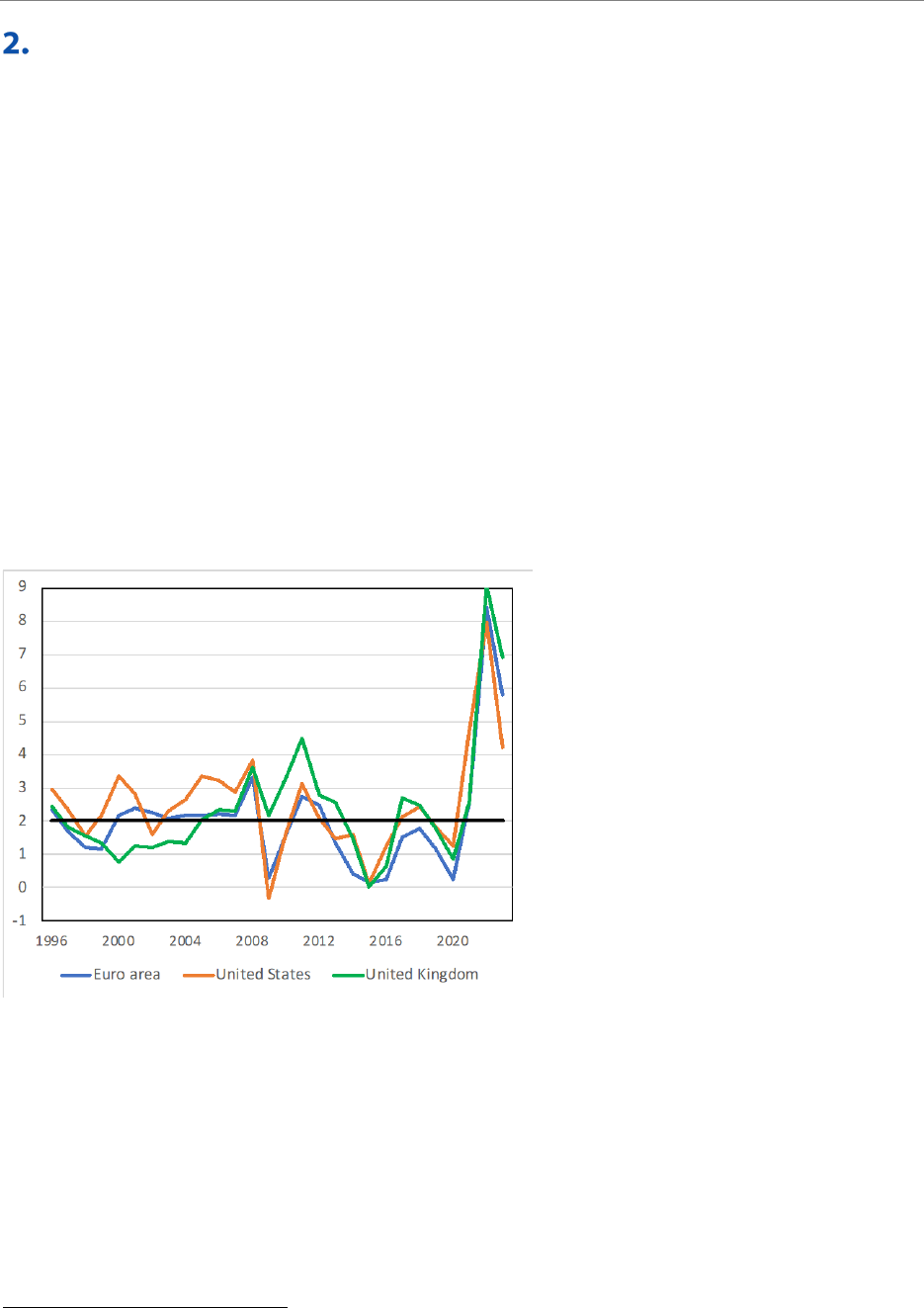
IPOL | Economic Governance and EMU Scrutiny Unit (EGOV)
72 PE 747.830
MACROECONOMIC POLICIES IN THE SHORTER RUN
2.1. What went wrong at central banks?
In most advanced economies, central banks have good reasons to feel under pressure. They have
become very large but failed to bring inflation up when it was too low. They further failed to detect the
inflation surge when it took off, so they were late to react. Their reaction was standard in the face of
non-standard shocks. Of course, inflation is coming down, but central banks are now different from
what they used to be before the global financial crisis, and they need to adapt or revert.
Up until the global financial crisis, most central banks had adopted the inflation targeting strategy. In
a nutshell, the strategy calls for adjusting the policy interest rate whenever inflation expectations
diverge from the target. For a while, it worked well, but not after 2008 when, as Figure 1 shows, inflation
dipped below target. When interest rates hit the lower bound, QE was invented. A large literature has
tried to explain this ‘inflation puzzle’, producing a long list of potential reasons (e.g. demographic
change, a flat or non-linear Phillips curve, technological change, a very low equilibrium interest rate,
globalisation, and more).
69
Much the same happened when the pandemic hit and, this time, inflation
surged. This second failure, on top of the first one, represents a serious challenge.
Figure 1: Headline inflation rates (% per year)
Source: OECD.
A natural conclusion would seem to be that we lack a proper understanding of the inflation
phenomenon. A number of commentators have rushed to this conclusion. Adherents of the monetarist
tradition see the inflation surge as a consequence of QE during the pandemic (Issing, 2021). But this
does not explain why QE did not create inflation in 2010s. Others have proclaimed the Phillips curve to
be not just flatter or nonlinear,
70
or even dead (Cochrane, 2019), but this is not confirmed by a large
amount of empirical work. As recently argued by Bernanke and Blanchard (2023), a textbook summary
of macroeconomic theory provides a convincing explanation of the events of the last quarter century.
69
Some of the many surveys are Ciccarelli and Osbat (2017), Sánchez and Kim (2018) and Yellen (2019).
70
If the Phillips curve is flat, economic conditions (the output or the unemployment gaps) do not affect inflation. If it is nonlinear, the effects
of economic conditions become stronger as the gap becomes smaller.

Achieving the right fiscal-monetary mix (in the context of the economic governance review)
PE 747.830 73
Central banks have failed for two main technical reasons.
71
First, their forecasts have not been accurate.
The dynamic stochastic general equilibrium (DSGE) models, which capture the current conventional
wisdom, are unable to account for both the impairment of financial markets that followed the 2008
crisis and for the pattern of household savings triggered by the lockdowns enforced during the
pandemic (Cochrane, 2023). Second, as explained by Gros and Shamsfakhr (2022), these models require
their users to make the crucial assumption of what inflation will be in the medium term? They have
assumed that, by then, inflation would have returned to its target level, which amounted to decide that
the surge would be temporary. They quoted widespread support from private forecasts of
professionals, whose views were shaped by those of the central banks themselves. However, Coibion
et al. (2020) have shown that households and firms, which bargain over wages and set prices
accordingly, hold very different expectations from those of professionals. The inflation targeting is not
to be blamed.
2.2. The fight against inflation
As they realised that their forecasts were seriously misleading because of high uncertainty and
changed circumstances, central banks have suspended forward guidance, the practice of signalling
their intentions over the coming couple of years in order to shape expectations. The shift to rely on
observed/incoming data to make policy decisions undermines inflation targeting, even though
inflation targeting based on misleading forecasts is even worse. Given that monetary policy affects
actual inflation with a long and variable delay, this shift all but guarantees that the anti-inflation stance
will last for too long.
The immediate costs will include a period of below-target inflation and of longer than needed slow
growth, possibly negative growth, along with rising unemployment. Central banks are fully conscious
of this consequence and rightfully argue that it is better to err in this direction than to allow inflation
to remain too high. About a year and a half after policy started to tighten, headline inflation is
unsurprisingly declining and the tightening cycle is visibly coming to its end.
That does not mean that central banks should declare victory. They still face the challenge of coming
to terms with the reasons why they failed to achieve their targets since 2008. In the near term, they
stand to face three main issues:
• They will eventually have to cut their interest rates. Until recently, the conventional wisdom
was that the neutral interest rate – the rate at which monetary policy is neither expansionary
not contractionary – is about 2 to 3% when inflation is at its 2% target. Like much of the pre-
existing conventional wisdom, there is surprisingly little support for this assertion.
• In addition, if inflation undershoots its target, central banks may have to go below the neutral
rate. That means that there is considerable uncertainty on how far down, and how fast, central
banks will have to bring their interest rates. A debate will soon emerge, fed by this uncertainty
and by the fiscal considerations presented in Section 2.3.
Most central banks have started to reduce the size of their balance sheets (quantitative tightening,
QT). As Figure 2 shows, QT is proceeding relatively slowly. If, as they argued during the QE period,
varying the size of balance sheets has a significant effect on inflation, we could have expected them
to combine interest rate increases and QT, perhaps raising the interest rates more slowly and
proceeding faster with QT, as explained in Wyplosz (2023a). The doctrine on QE and QT needs to be
clarified.
71
President Lagarde has recognised these shortcoming in her speech at the Jackson Hole Symposium on 25 August 2023.
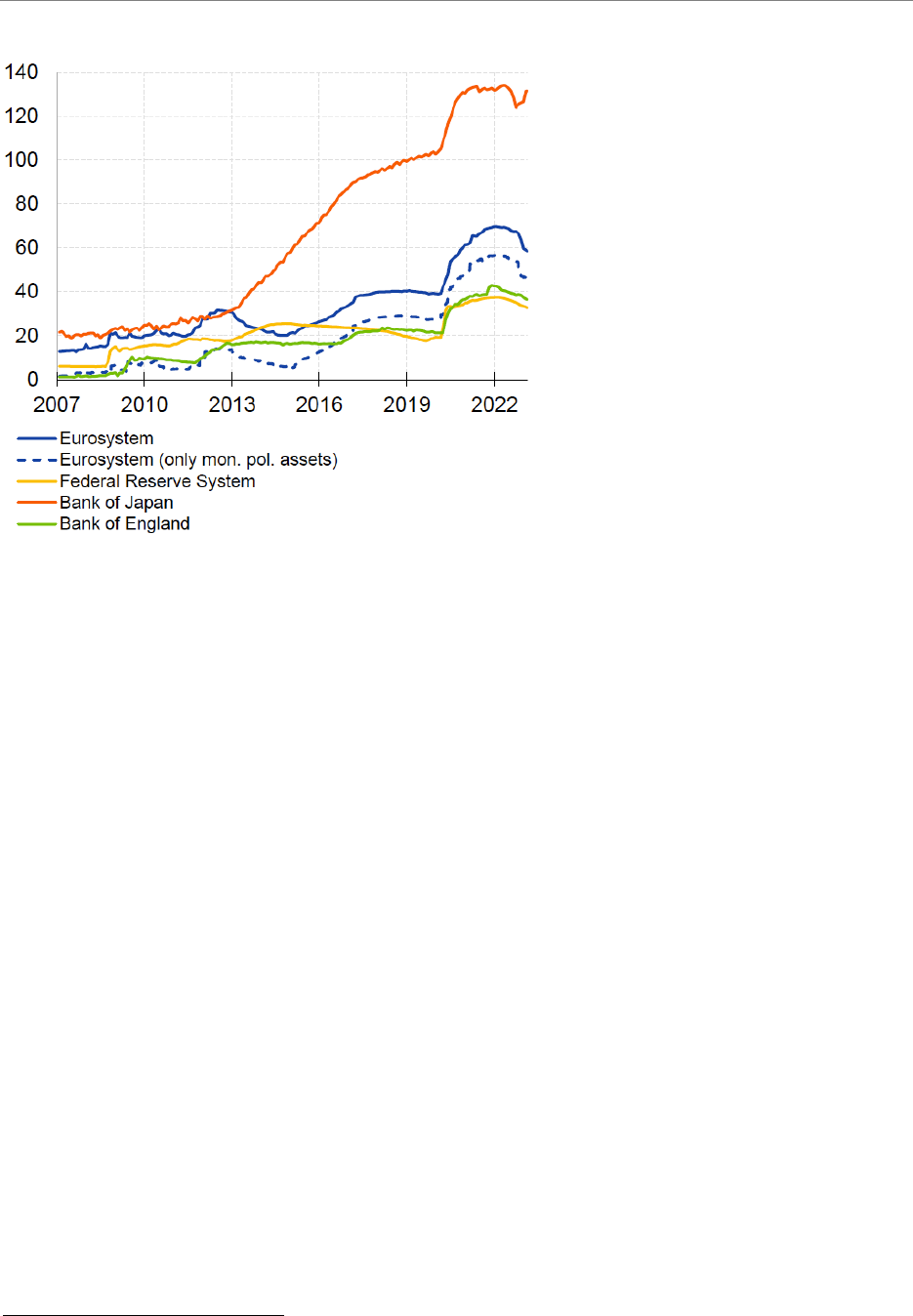
IPOL | Economic Governance and EMU Scrutiny Unit (EGOV)
74 PE 747.830
Figure 2: Central bank balance sheets (% of GDP)
Source: Schnabel (2023).
One possibility is that central banks are concerned with financial (in)stability at a time when rising
interest rates risks stressing banks and financial institutions. Some relevant events have occurred in the
UK, the US and Switzerland but they could be dealt with modest and temporary reversals of QT.
Another concern is that QT involves selling public debt instruments, which makes it more difficult for
government to finance budget deficits and to serve debt. The delicate relationship between monetary
and fiscal policies is examined in Section 2.4 below.
2.3. Fiscal policies
Fiscal policy expansions have been historically strong throughout most of the advanced economies
since 2019, and they are slowly being reversed. This is clearly visible in Figure 3, which displays the
cyclically-adjusted primary budget balances of large OECD countries and the euro area.
72
The figure
compares the average balance over the pre-Covid period with what happened in the following years.
Although the retrenchment in 2022 and 2023 is large, all the balances are expected by the OECD to
remain in deficit in 2023. There were good reasons for all countries to adopt emergency measures,
although the deficits would have been contained had the measures been carefully targeted toward
the intended beneficiaries. Moreover, when growth strongly resumed after the lockdowns, the
deficits remained large as governments were anxious not to undercut the budding recovery. Yet, the
recovery was brisk, largely because non-targeted subsidies led households to accumulate large
savings that started to be spent once lockdowns ended and the pandemic became less severe.
72
The purpose of the cyclical adjustment is to measure the discretionary actions of governments since it nets out the automatic effects of
cyclical fluctuations and pre-committed interest payments on the existing debt.

Achieving the right fiscal-monetary mix (in the context of the economic governance review)
PE 747.830 75
Figure 3: Cyclically adjusted primary budget balances (% of GDP)
Source: Economic Outlook, OECD.
The role of fiscal policies in contributing to the inflation surge is not always acknowledged, even
though the ECB has repeatedly voiced concern. A good measure of the effect of fiscal policy on the
macroeconomy – aggregate demand and, subsequently, inflation – is the change in the cyclically
adjusted primary deficit. This change represents how much the government voluntarily adds to, or
subtracts from aggregate demand. For each year from 2017 to 2023, Figure 4 plots inflation against the
change in the cyclically adjusted primary deficit, lagged by one year to account for the delayed impact.
Because fiscal policy is but one of the sources of inflation, the link is not tight, yet it is present. More
formal evidence can be found in Bankowski et al. (2023) for the euro area and in Demirel and Wilson
(2023) in the US.
Figure 4: Inflation and the cyclically adjusted primary budget balances (% of GDP)
Source: Economic Outlook, OECD.
Note: The budget measure corresponds to the previous year.

IPOL | Economic Governance and EMU Scrutiny Unit (EGOV)
76 PE 747.830
2.4. Interactions between monetary and fiscal policies
In principle, the separation of tasks between governments and central banks is clear. Central banks are
in charge of inflation. Dealing with the impact of the pandemic and subsequent shocks on households
and firms is the responsibility of governments. Together governments and central banks are
responsible for financial stability. However, these macroeconomic policies are interdependent, a fact
that has long been recognised. It is surprising, therefore, that this interdependence has not been taken
into account to a greater extent by both central banks and governments.
Fiscal expansions were enacted in 2020 during the acute phase of the pandemic. As Figure 3 shows,
the cyclically adjusted primary budgets were pushed into large deficits, with changes ranging from 6%
to 11% of gross domestic product (GDP). The impact on GDP growth was bound to be sizeable, even
though the lockdowns and other health policy measures worked in the opposite direction. With
hindsight, we now know that GDP growth rebounded forcefully in 2020-21, which contributed to the
inflation surge. At the time, there were debates about the impact of the Covid shock, which reduced
both demand and supply, with an uncertain overall effect. Uncertainty also concerned the duration of
the shock and, therefore, the timing and vigour of the eventual recovery. As previously noted, most, if
not all forecasting models were unable to clarify the situation and most central banks did not try to
counteract the impact of the unusually large fiscal expansions.
Clearly, the central banks were facing considerable uncertainty. In such a situation, however, risks must
be balanced. And indeed, there were several risks:
• A clear concern, which central banks shared with governments, was not to undermine the
recovery once the pandemic became less threatening. By early 2021, however, vaccines
became widely available in the advanced countries and the importance of newly-accumulated
household savings suggested the possibility of a strong recovery (Wyplosz, 2021). That, alone,
should have alerted central banks to the need of keeping inflation at the top of their list of
priorities.
• There were widespread fears of lasting “scarring effects” from the pandemic, due to
withdrawals of labour market participations and shifts in consumer behaviours. These effects
could harm the recovery, but since they would mostly contributed to a decline in potential
GDP, they could be inflationary. Dealing with scars and changing behaviour was a responsibility
of governments while central banks had to deal with the inflationary impact.
• Financial stability was another concern. Central banks had learned to quickly inject large
amounts of liquidity. Until the end of 2022, though, there was no sign of instability and they
kept QE going. Then, they gradually stopped QE and started to shrink the amount of liquidity,
which may lead to instability.
• Without a better understanding of why inflation had been too low, central banks in the
developed economies were worried of missing a chance of escaping the liquidity trap.
Indeed, several central bankers suggested that they were willing to overshoot the inflation target as a
way of exiting the too-low inflation period. Thus, it was a calculated risk, but did it consider the
inflationary impact of highly expansionary fiscal policies? No such risk was mentioned as late as
November 2021, when the ECB stated that:
“To support the recovery, ambitious, targeted and coordinated fiscal policy should continue to
complement monetary policy.” (Economic Bulletin 7/2021, ECB, p.3.)
while noting that:
“Inflation is expected to rise further this autumn, but to decline next year. The current increase in
inflation is expected to be largely temporary, mainly reflecting the strong increase in oil prices since
around the middle of last year, the reversal of the temporary VAT reduction in Germany, delayed

Achieving the right fiscal-monetary mix (in the context of the economic governance review)
PE 747.830 77
summer sales in 2020 and cost pressures that stem from temporary shortages of materials and
equipment. In the course of 2022 these factors should ease or will fall out of the year-on-year inflation
calculation. Underlying inflation pressures have edged up. As the economy recovers further, and
supported by the Governing Council’s monetary policy measures, underlying inflation is expected to
rise over the medium term.” (Economic Bulletin 7/2021, ECB, p.4.)
Note that the inflationary impact of fiscal expansions is not mentioned. It is only after it started to raise
the policy rates that the ECB stated in August 2022 that:
“Economic activity continues to benefit from the reopening of the economy, a strong labour market
and fiscal policy support. […] Fiscal policy is helping to cushion the impact of the war in Ukraine for
those bearing the brunt of higher energy prices. Temporary and targeted measures should be tailored
so as to limit the risk of fuelling inflationary pressures. Fiscal policies in all countries should aim at
preserving debt sustainability.” (Economic Bulletin 5/2022, ECB, p.3.)
The coordination between monetary and fiscal policies Is traditionally difficult to organise because the
agendas of central banks and governments are rarely aligned. Since 2020, however, the objectives of
both authorities were the same. Both acted forcefully, as if they were alone, and they often failed to
recognise that many of the required actions were of a fiscal policy nature. In the euro area, the existence
of 19 governments
73
made coordination even more difficult.
73
Croatia only joined the euro area in 2023.

IPOL | Economic Governance and EMU Scrutiny Unit (EGOV)
78 PE 747.830
NEW MONETARY POLICIES
3.1. Quantitative easing: when it makes sense and when it does not
QE was introduced as a response to having reached the effective lower bound of the key policy interest
rates. Having lost their standard instrument to conduct expansionary policies, central banks hoped that
cash injections would be a substitute instrument. QE worked in two ways. First, on the credit supply
side, it was thought that abundant liquidity would lead to increases in bank lending through a
relaxation of credit conditions at unchanged interest rates. The assumption was that commercial banks
would be eager to find lucrative uses for their abundant deposits at central banks. Second, on the credit
demand side, it was believed that, by absorbing large amounts of public debts at varied maturities, QE
would lower the whole yield curve, thereby encouraging more borrowings by the private sector. Credit
conditions were relaxed and the yield curves became flatter, indeed, but the demand for credit did not
rise enough to generate sufficient growth to raise inflation, the ultimate objective of QE. In the event,
banks found new ways of using their abundant liquidities in other ways than by supplying more credit.
Acharya and Rajan (2022) and Rajan (2023) argue that QE had made some financial institutions
“liquidity dependent”, so that continuing QE during a quiet period may have planted the seeds of
future difficulties:
• Injecting liquidity serves another purpose. It stabilises financial markets during a crisis.
However, if the outcome of QE is to create “liquidity dependence”, the liquidity injections are
not achieving their aim of increasing the resilience of banks.
• Before QE, commercial bank reserves were close to the minimum that they wished – or needed
– to hold. The scarcity of reserves made it possible for central banks to not remunerate bank
deposits. When bank deposits exceed what is desired, central banks must offer remuneration,
close to the policy interest rate in order to pin the interbank interest rate at the policy rate
chosen by the central bank. Section 3.2 examines the quasi-fiscal implication of QE.
• QT is challenging. After successive waves of QE, liquidity is excessive and must be reduced.
However, this process can destabilise banks and other financial institutions. They not only
stand to gradually face tighter availability of liquidity but they may become seriously
constrained inasmuch as they had become “liquidity dependent”. The larger QE has been, the
further QT has to proceed, and the more difficult it becomes.
• Public debts are under pressure. As central banks hold a significant portion of public debts, QT
competes with new debt issuance, be it to finance ongoing budget deficits or to roll over
maturing debt instruments (next section).
The upshot is that the ability of QE to affect aggregate demand is very much in doubt and that liquidity
injections are a powerful tool to deal with financial stability during a crisis. Long lasting QE is largely
useless, and potentially detrimental. “Brief QE” in the form of pre-emptive or emergency liquidity
injections is a key instrument.
3.2. Fiscal implications of quantitative easing
Monetary policy is supposed to be neutral in the sense that it affects only the nominal economy (all
variables expressed in value) not the real economy (all variables expressed in volumes). In practice, this
is not the case, at least in the shorter run when prices and wages are not flexible. For instance, raising
the interest rate does not reduce inflation quickly. It first reduces private spending, it also typically
results in an exchange rate appreciation that reduces exports. The resulting lower aggregate demand
is meant to influence price and wage setters as they contemplate weakening sales and higher

Achieving the right fiscal-monetary mix (in the context of the economic governance review)
PE 747.830 79
unemployment. These real effects, however, are expected to gradually disappear as inflation declines
and central banks stop pulling the brakes. Over a business cycle, real interest rates, relative prices and
real wages usually settle back to their long-run trends.
During a liquidity crisis, central banks act as lender of last resort. The well-established practice stands
to encourage financial institutions to take excessive risks if they are certain to receive help in case of a
crisis. This moral hazard is taken seriously by central banks which customarily state that liquidity
injections are a possibility, not a commitment. Financial regulation is also designed to make these
events rare and costly for institutions when they receive support. However, when it is not a particular
institution that becomes illiquid but the whole market, the central bank has no choice but intervene.
These interventions, which can be seen as one-off QEs, distort financial markets but their fiscal
implications are minimal because, by design, they are rare and temporary, and can be reversed once
financial stability is restored. Furthermore, governments can and often do intervene along central
banks with their own subsidies.
Sustained QE, on the other hand, is not neutral. It creates lasting and disturbing links with fiscal policy,
as explained in Hooley et al. (2023).
The most notable effects are:
• By acquiring large amounts of long-term assets, central banks flatten the yield curve, as
previously mentioned. By reducing term premia, this is a distorting subsidy and therefore an
action that belongs to the fiscal authorities. It encourages long-term risk-taking.
• At the same time, the returns from private assets have become significantly higher than the
returns from public debts. This has been explained by investors’ heightened search for safe
assets. By providing investors with large amounts of liquidity through purchases of public
debts, central banks support the safety of the debts and make it possible for
governments to borrow at a discount (Reis, 2021).
• QE typically involves purchases of public debts. In the euro area, the ECB holds some 30% of
outstanding debts (see Figure 6 below). This lightens the borrowing and debt burdens.
Everything else remaining equal, it encourages deficit spending. While help from central banks
to governments may be welcome at times – in 2020-21, the ECB indirectly financed almost all
the member states’ deficits – it should be strictly limited to exceptional situations. QT is a
condition for avoiding fiscal dominance.
• In some countries, as in the euro area, the central bank may also purchase private assets,
typically those that are highly rated. This is another source of distortion. It typically
favours large firms from the industrial sector, with no obvious justification.
• In the euro area, QE benefits more the countries with large public debts. The ECB argues
that it is needed to prevent the kind of segmentation that was observed during the debt crisis
over 2010-2012 and thus to maintain the transmission of monetary policy throughout the
whole area. Special programmes such the Pandemic Emergency Purchase Programme (PEEP)
and Transmission Protection Instrument (TPI) reinforce this aspect. Here again, these
distortions may be highly desirable in specific situations, but QT should undo them when the
need is no longer justified.
• QE reduces the maturity of debts of the overall public sector. Combining balance sheets of
the central bank and the government into an overall public sector balance sheet, QE can be
seen as replacing some long-term debt instruments with very short-term liabilities of the
central bank. Under normal conditions, it is the responsibility of the fiscal authorities to
determine the maturity structure of their debts.

IPOL | Economic Governance and EMU Scrutiny Unit (EGOV)
80 PE 747.830
•
The abundance of liquidity forces central banks to offer interest on bank deposits, as
already noted. Relative to the previous situation, this amounts to transfers to banks.
Whether bank deposits should be remunerated or not is controversial but, in the end, decisions
on transfers should belong to the fiscal authorities, if only because they receive the central bank
profits and therefore end up bearing the costs of interest payments to banks.
• Central banks take on board risky assets, including public debts, all of which are not safe.
While central banks are uniquely apt at absorbing risk (since they can always create money as
needed to guarantee debt service), this is another distortion. Furthermore, if risks materialise
and central banks create money to absorb them, this opens up the risk of inflation, which is
their key responsibility.
3.3. Policy implications
The main message is that the distortionary effects of classic monetary policy wash out over a cycle as
the effects from periods of tightening are compensated by the opposite effects from periods of
loosening. Occasional liquidity injections are not neutral but the effects are limited, while sustained QE
creates a large number of distortions and takes over significant fiscal characteristics. QE of past years
has also left central banks with large balance sheets. Barring any new major shock – a hope more than
a presumption – it is time to envisage the next steps. Two of them, making central banks and public
debts smaller, deserve more attention than they currently attract.
As noted above, prompt QT is the necessary counterpart to emergency QE. According to Figure 2 , QT
is proceeding quite slowly, however.
One reason is the fear that it could usher in financial instability, but QT does not prevent occasional
injections of liquidity when needed.
74
Another reason is financial dominance. Financial institutions
have adapted to the abundance of liquidity and shares are currently highly valued, although the rapid
rise in interest rates have a depressing effect on share prices. In addition, since banks receive interest
on their central bank deposits, the abundant liquidity can be seen as a subsidy to the whole financial
sector, which naturally wishes that liquidity remains abundant. Governments also benefit from
compressed yield curves, a case of fiscal dominance. All these explicit or implicit subsidies are difficult
to withdraw, especially when they have been in place for a long time.
However, the certainty of QT is crucial to minimise the quasi-fiscal aspects of QE presented in Section
3.2. QT should not be an option to be exercised whenever it seems convenient. This concerns both the
timing and the quantitative objective. Most central banks have now announced a QT schedule in the
form of monthly withdrawals of liquidity over periods of several months. This is an important
commitment, but it leaves out two essential questions: what is the destination, and when can we
expect the destination to be reached? In particular, will the monetary regime remain characterised by
excess liquidity and, therefore, will bank deposits continue to be remunerated at the policy rate? In
order to minimise the risk of instability, financial markets need to know the answers to these questions
ahead of time to make adequate preparations. These are difficult questions, and central banks may not
be able to provide definitive answers. Yet, before the inflation surge, several of them have formulated
monetary policy strategies that now need to be updated. These issues clearly belong to the formulation
of the next monetary policy strategy.
74
Indeed, occasional and temporary liquidity injections merely slow down the trend of liquidity absorption.
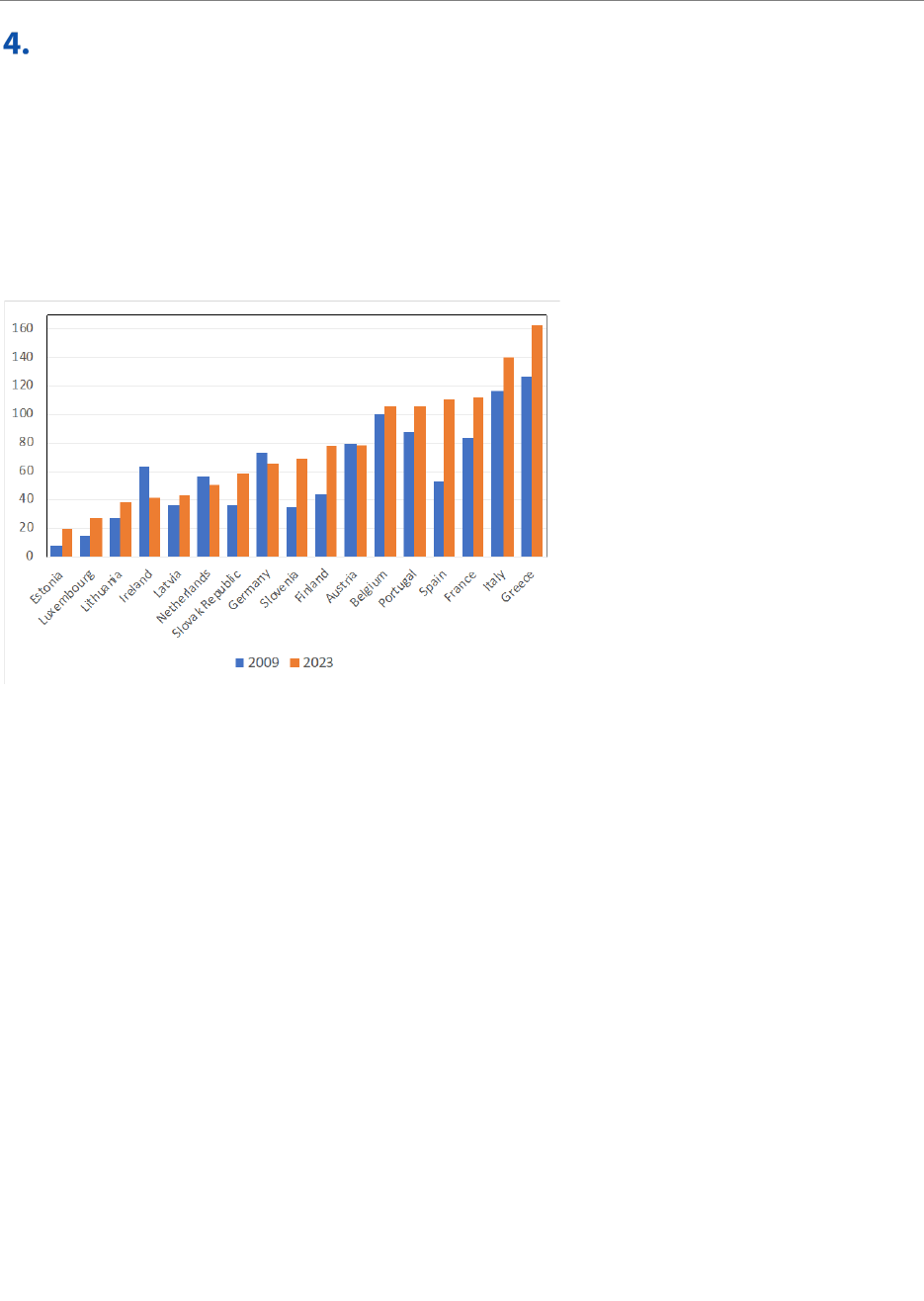
Achieving the right fiscal-monetary mix (in the context of the economic governance review)
PE 747.830 81
THE EURO AREA IS SPECIAL
4.1. The public debt issue
As can be seen from Figure 5, the gross public debts of several euro area member governments are
large, exceeding 100% of GDP in six cases, higher than before the sovereign debt crisis. The debt ratio
has declined in only four countries (Ireland, the Netherlands, Germany and Austria), even though
interest rates have been close or below zero during much of the intervening period.
Figure 5: Public debts (% of GDP)
Source: Economic Outlook, OECD.
The debt increases are partly explained by the shocks of the 2020s, when the general escape clause of
the Stability and Growth Pact was activated. However, an effective debt discipline framework would
have led to debt reductions during the good years 2012-19, thus making room for the exceptional
deficits warranted by the recent shocks. This is what happened in the four countries where debts are
lower than in 2009 and in the countries where debts are less than 60% of GDP. These are countries
where debt discipline is practiced, quite independently of the Stability and Growth Pact.
The existence of large differences in public debts directly affects monetary policy. Interest rates on
public debts tend to reflect indebtedness, which affect private borrowing rates. As a result, the single
policy rate set by the ECB does not result in similar borrowing rates across the euro area. Put differently,
the transmission of monetary policy is not uniform across member countries. At worst, as it has been
the case during the debt crisis, suspicions of debt sustainability can lead to very high interest rates for
both the sovereign and the private sector.
This, in turn, translates in divergent national views about the conduct of monetary policy. In the current
si
tuation of rapid increases of the policy rates, some governments have started to complain, while
others may find that stronger action is needed. Thus, the Italian Prime Minister has warned the ECB
against further interest rate increases (Financial Times, 28 June 2023), as did Ministers from Portugal
and Spain (Le Monde, 4 July 2023). In response, the President of the Bundesbank declared that “the
image of nearing the interest rate peak is actually wrong” (Speech at the Frankfurt Euro Finance
Summit, 3 July 2023).

IPOL | Economic Governance and EMU Scrutiny Unit (EGOV)
82 PE 747.830
4.2. The conventional strategy
Can something be done to directly deal with the public debt situation? The conventional answer is that
sustained primary budget surpluses is the way to bring public debts down and this is the raison d’être
of the Stability and Growth Pact. Unfortunately, this logic is most unlikely to deliver significant debt
reductions. In a recent survey of the historical evidence, Arslanalp and Eichengreen (2023) make two
points:
• Reducing debts through primary surpluses takes considerable times. The evolution of public
debts depends on two factors: 1) the primary budget balance; 2) the difference between the
interest rate and growth, often referred to as r-g. There is considerable uncertainty about the
long-run values of r and g, let alone the sign of r-g. For the sake of illustration, assume that r-
g=0. With primary surpluses continuously at 5% of GDP, bringing the debt from 100% of GDP
to 60% would take 8 years. For surpluses at 3% of GDP it would take 14 years, and it would take
40 years for surpluses of 1%.
• The experience of the last half-century is that sustained, large primary surpluses are very rarely
observed. In modern advanced economies, government budgets are large and include a
welfare state with many entitlements, which create political conditions not conducive to the
conventional strategy.
Table 1 tallies the evolution of primary surpluses over more than eighty years in OECD countries. No
country exhibits an average surplus exceeding 1% of GDP, with two exceptions: Denmark (barely) and
Norway, which is an outlier because of its large income for North Sea gas. Surpluses in excess of 3% or
5% of GDP are very rare. Surpluses in excess of 1% would need to be sustained over decades to seriously
cut debts in highly indebted countries. The last column indicates the largest spans of consecutive
surpluses above 1%. In several cases, they extend over long periods, but never for twenty years or more,
except for Norway and for Belgium.
75
This evidence confirms the conclusion of Arslanalp and Eichengreen (2023) that large debts are here to
stay. For the euro area, it means a continuing fragility of some public debts, with an underlying risk of
crisis. It also means that the ECB will continue to face contradictory constraints and a challenging policy
transmission process. Slow growth may also characterise countries whose governments are fiscally
constrained. It may also harm progress on climate change, on health policies, on defence and
investment in technological research and development.
The mistaken belief that sustained fiscal retrenchment is the solution means that there is no intention
to directly tackle the debt problem. This is the responsibility of governments, not the ECB. But it directly
affects the ECB in many ways, as previously explained. The following section sketches an explicit
procedure to cut public debts.
75
Belgium maintained a surplus in excess of 1% for 21 years, from 1987 to 2008. During that time, its debt went from 142% to 103% of GDP.
Today it stands at 105%.

Achieving the right fiscal-monetary mix (in the context of the economic governance review)
PE 747.830 83
Table 1: Primary surpluses in the OECD area (1960-2023)
Source: Economic Outlook, OECD.
Note: Sample periods vary across countries. The central and east European countries are excluded.
4.3. How to reduce public debts
76
4.3.1. The idea
The national central banks of the Eurosystem currently hold a significant share of their respective
central government debts. According to Figure 6, the share is usually ranges between 25% and 30% of
total debt. Debt service on these shares is zero for the consolidated public sector since interest
payments by governments to central banks are returned to governments as profits. In addition, the
debt held by central banks is removed from the financial markets, which reduces their exposure to
market instability and makes the debts safer. “Effective debts”, therefore, are generally 70%-75% of the
corresponding gross debt numbers shown in Figure 5. For example, Italy’s “effective public debt” is
109% of GDP instead of 141%.
The problem is that there is no guarantee that the national central banks will keep forever existing
debts on their books, which implies that the concept of “effective debt” as defined above is misguiding,
76
This is an updated version of the plan presented in Pâris and Wyplosz (2014).
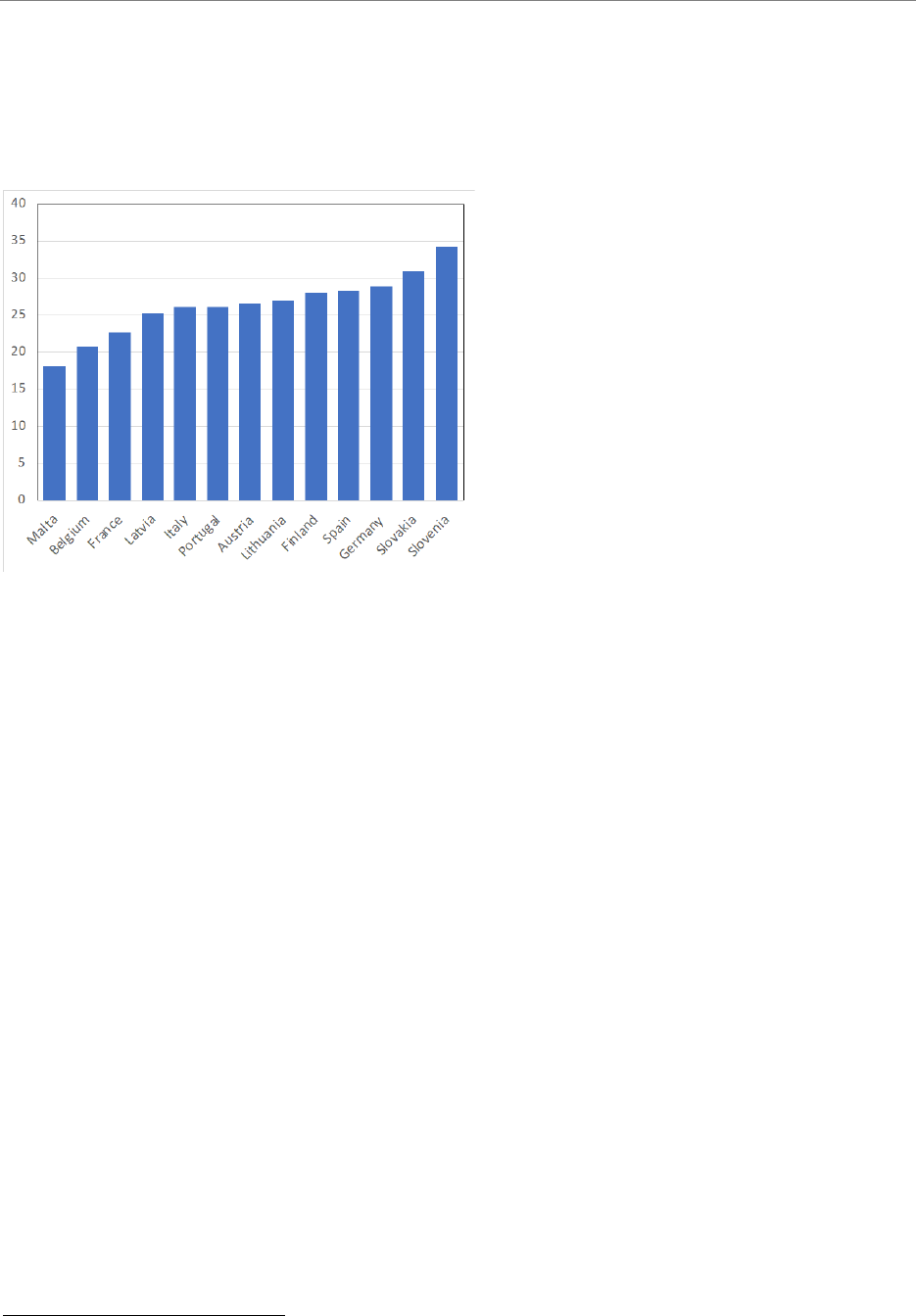
IPOL | Economic Governance and EMU Scrutiny Unit (EGOV)
84 PE 747.830
but so is the commonly used concept of actual debt, which ignores the economic effect of holdings of
Treasury bonds
77
by central banks. Behind this confusing situation lies uncertainty about the evolution
of future holdings. QT will certainly reduce debt holdings by central banks, but we do not know how
far it will proceed. Removing this uncertainty may provide a solution of the large debt problem.
Figure 6: Central bank holdings of central government debts – end 2022 (% of total debt)
Source: ECB.
Note: Data for some countries are not available. Not reported countries with very low numbers (Croatia, Cyprus).
If the Eurosystem central banks were to keep the existing amounts of debts on their books forever, this
would be equivalent to a debt restructuring, whereby the correct measure of indebtedness would be
the “efficient debt”. How this can be done requires looking into how central banks routinely manage
the money supply through the interbank market.
For decades, central banks have created money by taking on board (through outright purchases or
repurchase agreements) public debt instruments.
78
The main reason for using this instrument is that
Treasury bonds are deemed safe. Under this assumption, central banks do not take any risk. In so doing,
the central banks indirectly finance a fraction of the budget but, until QE, in most countries, the
fractions were small. Effective debts were close to actual debts, and the fiscal impact of standard
monetary policymaking was irrelevant.
The link between liquidity provision by central banks and public debt financing can be avoided. As
central banks provide liquidity to commercial banks (by increasing bank deposits), they must be paid
in return. The standard procedure is for the commercial banks to cede Treasury bonds. In other words,
the central banks purchase Treasury bonds. The procedure can be changed, however. Instead of
purchasing Treasury bond, central banks could buy back their previously issued own bonds held by the
commercial banks. Central bank bonds are at least as safe as public debts, both are liabilities of the
overall public sector. Were central banks to adopt this procedure, they could conduct routine monetary
policy operations while keeping the existing public debts on their balance sheets. Promising to keep
existing holdings of Treasury bonds forever would effectively reduce the public debts of governments,
replacing them with central bank debts. It would not change the level of indebtedness of the
77
This paper does not get into the differences between bonds and bills, using instead the generic term bonds.
78
The ECB also acquires private assets, which raises another set of questions that go beyond the purpose of this paper.

Achieving the right fiscal-monetary mix (in the context of the economic governance review)
PE 747.830 85
consolidated public sector, only its composition, with no impact on the money supply. The interbank
market would use central bank bonds as it presently uses Treasury bonds.
4.3.2. How to replace Treasury bonds with central bank bonds
The problem is that, currently, commercial banks do not hold central bank bonds, which they would
need to hold in sufficient quantity to trade with central banks on the interbank markets. Somehow, the
pump must be primed. Two procedures are possible:
• First, the central bank could buy from commercial banks more Treasury bonds in exchange for
newly issued central bank bonds. This would not affect commercial bank deposits. In order to
separate the procedure from monetary policy through the impact on the yield curve, the
central bank bonds should be of equal maturity as the Treasury bonds that are being swapped.
• Second, the central bank could take advantage of QT, which aims at reducing bank reserves.
This could be achieved by issuing central bank bonds to be paid for by commercial banks with
reserves, without affecting their holdings of treasury bonds.
An objection to the first procedure is that it would increase debt holdings by central banks, which may
be considered as too large. This is a policy choice, which must be agreed upon by the central bank and
its government. An objection to the second procedure is that, for the interest rate on the interbank
market to be equal to the policy rate, central bank bonds will have to serve the same interest as they
offer on bank deposits. Consequently, the banks will consider their deposits and the central bank bonds
as equivalent, just different forms of reserves, and QT will not achieve its aim. A solution is for the newly
issued central bank bonds to have longer maturities than the deposits which are redeemable on
demand. In the end, a combination of both procedures can achieve the desired amount of implicit debt
write-off.
4.3.3. Objections and answers
Neutralising a part of existing public debts by placing them on the books of the central banks is bound
to generate a number of objections. Furthermore, the specifics of the new procedure must be
examined in detail. Some of these questions are dealt with as follows.
a. An inflationary financing of budget deficits?
When a central bank absorbs public debts, it amounts to an ex-post financing of past deficit and the
monetary financing of deficits is normally thought of as a source of inflation. The link is more subtle.
The constant expansion of the money supply to pay for deficits is certainly inflationary because the
reserves of the commercial banks rise, which allows them to keep lending and thus support ever more
demand. In the present case, it is a one-off operation that does not increase bank deposits. If needed,
the existing excessive deposits can be reduced through QT, with central banks issuing their own bonds.
b. Deposits and bonds
Both commercial bank deposits and central bank bonds are liabilities of the central bank and, as already
explained, they must be remunerated at the same rate as the policy interest rate. If they are seen by the
commercial banks as equivalent financial instruments, which constitute their reserves, open market
operations where one instrument is swapped against the other would have no effect at all. As noted
above, the central bank bonds could be of longer maturity than the deposits. Another solution would
be that the required reserve requirements, which cap the lending capacity of banks, exclude central
bank bonds from being counted as reserves.

IPOL | Economic Governance and EMU Scrutiny Unit (EGOV)
86 PE 747.830
c.
Inter-country transfers
Within the monetary union, low-debt countries sternly oppose any procedure that could imply
transfers to high-debt countries. This is not an issue here since monetary policies are carried out by
national central banks, which hold Treasury bonds issued by their own governments. Replacing
national Treasury debt with national central bank debt would occur exclusively at the national level,
thus preventing any transfer between countries.
d. Moral hazard
If it is easy for a central bank to reduce the “effective debt” of the government, it would seem to create
a major source of moral hazard. Since both Treasury and central bank bonds are a liability of the
consolidated government, there is indeed a risk that some governments will keep running budget
deficits and raise their debts, with the procedure being repeated again and again. This calls for solid
safeguards, which already exist. Within the euro area, national central banks operate under the control
of the ECB. For that reason, their interbank interventions are carried out on behalf of the ECB and they
cannot monetise the debt unless they are instructed to. The ECB will have the authority to determine
the size of the initial debt write-downs and any other increase of national Treasury bond holding by
the national central banks. It is worth recalling that the Treaty on the Functioning of the European
Union requires that the ECB and all national central banks be independent, which forbids them from
taking orders from governments.

Achieving the right fiscal-monetary mix (in the context of the economic governance review)
PE 747.830 87
CONCLUSIONS
The euro area emerges from a series of historical shocks with 1) much larger public debts, 2) increased
central bank balance sheets of the Eurosystem central banks, and 3) intensified links between fiscal and
monetary policies. While the actions that led to this situation are justified by the urgent needs to deal
with the shocks, their legacy is a source of undesirable economic and political distortions. The
governments and the ECB must now work toward facing these consequences. Public debts must be
reduced where they are dangerously large – as seen in
Figure 5 - and the ECB must promptly reverse
QE. Moving in this direction will go a long way toward minimising the quasi-fiscal implications of
monetary policy. Corrective action must not wait, if only because other shocks may again unexpectedly
occur.
The need to shrink central bank balance sheets is well understood and indeed QT is underway.
However, the strategy has not been spelled out in detail and the speed is not well adapted to a deep
retrenchment. Monetary policy has shifted from bank reserves being intentionally kept scarce to
abundant. Beyond consequences on the functioning of the financial system and, perhaps, the
overvaluation of various assets, abundant bank reserves must now be remunerated, which is a quasi-
fiscal issue. Is this new modus operandi destined to be permanent or does the ECB, and other major
central banks, intend to return to reserves scarcity? The answer to this question should determine the
speed of QT, which currently seems to be calibrated by fears of financial instability.
Much of the QE of the 2010s had not been significantly undone by the time the new shocks of the 2020s
hit. Similarly, the already large levels of indebtedness of some governments have not been reduced
generally by the time they had to be raised again. The idea that fiscal discipline, prompted by the
Stability and Growth Pact, will bring the large debts down to safe level assumes that the process can
be spread out over a very long time, to be measured in decades. Time, however, is a constraint that
need to be recognised. The European authorities, the ECB and national governments, must find a way
of quickly cutting public debts down. This paper suggests changing the time-honoured monetary
policy practice of dealing on the interbank markets with Treasury bonds. Instead, national banks can
issue their own debt instruments and keep the public debt that they currently hold on their balance
sheets for ever. In this way, the amounts of public debts held by the private sector can be reduced
significantly.

IPOL | Economic Governance and EMU Scrutiny Unit (EGOV)
88 PE 747.830
REFERENCES
• Acharya, V. and Rajan, G. (2022). “Liquidity, liquidity everywhere, not a drop to use – Why flooding
banks with central bank reserves may not expand liquidity”, Discussion Paper 16907, CEPR.
https://cepr.org/publications/dp16907?check_logged_in=1
• Arslanalp, S. and B. Eichengreen. (2023). “Living with High Public Debt”, paper presented at the
Jackson Hole Symposium,
https://www.kansascityfed.org/Jackson%20Hole/documents/9749/JH_Paper_Eichengreen.pdf
• Bankowski, K., Bouabdallah, O, Checherita-Westphal, C., Freier, M., Jacquinot, P. and Muggenthaler,
P. (2023). “Fiscal policy and high inflation”. Economic Bulletin 2/2023, ECB,
https://www.ecb.europa.eu/pub/economic-
bulletin/articles/2023/html/ecb.ebart202302_01~2bd46eff8f.en.html
• Beetsma, R., Debrun, X. and Klaassen, F. (2001) “Is Fiscal Policy Coordination in EMU Desirable?”,
Working Paper 01/178, IMF. https://www.imf.org/-/media/Websites/IMF/imported-full-text-
pdf/external/pubs/ft/wp/2001/_wp01178.ashx
• Bernanke, B. and Blanchard, O. J. (2023) “What caused the U.S. pandemic era inflation”,
Huntchinson Center,
https://www.brookings.edu/wp-content/uploads/2023/06/WP86-Bernanke-
Blanchard_6.13.23-1.pdf
• Ciccarelli, M. and Osbat, C. (2017). “Low inflation in the euro area, causes and consequences”,
Occasional Paper 181, ECB, https://www.ecb.europa.eu/pub/pdf/scpops/ecbop181.en.pdf
• Coibion, O., Gorodnichenko, Y., Kumar, Saten and Pedemonte, M. (2020). “Inflation expectations
as a policy tool?”. Journal of International Economics 124.
https://www.sciencedirect.com/science/article/pii/S0022199620300167?via%3Dihub
• Cochrane, J. (2019). “The Phillips curve is still dead”, The Grumpy Economist,
https://johnhcochrane.blogspot.com/2019/06/the-phillips-curve-is-still-dead.html
• Cochrane, J. (2023). “Interest rates and inflation part 3: Theory”. The Grumpy Economist,
https://johnhcochrane.blogspot.com/2023/08/interest-rates-and-inflation-part-3.html
• De Grauwe, P. and Ji Y. (2015). “Correcting for the Eurozone Design Failures: the Role of the ECB”.
Journal of European Integration 37(7): 739-754 https://doi.org/10.1080/07036337.2015.1079370
• Demirel, U. D, and Wilson, M. (2023). “Effects of Fiscal Policy on Inflation: Implications of Supply
Disruptions and Economic Slack”. Working Paper 2023-05, Congressional Budget Office.
• Gros, D. and Shamsfakhr, F. (2022) “Too little too late: ECB’s normalisation path was model- rather
than data-driven”, SUERF Policy Brief 370.
https://www.suerf.org/suerf-policy-brief/48909/too-little-
too-late-ecbs-normalisation-path-was-model-rather-than-data-driven
• Hooley, J., Khan, A., Lattie, C., Mak, I., Salazar, N., Sayegh, A. and Stella, P. (2023). “Quasi-Fiscal
Implications of Central Bank Crisis Interventions”, IMF Working Paper, WP/23/114.
https://www.imf.org/en/Publications/WP/Issues/2023/06/02/Quasi-Fiscal-Implications-of-Central-
Bank-Crisis-Interventions-Case-Studies-534079
• Issing, O. (2021). “The return of inflation?”, Project Syndicate, https://www.project-
syndicate.org/commentary/inflation-risks-money-supply-demographics-deglobalization-by-
otmar-issing-2021-07?barrier=accesspaylog
• Pâris , P and Wyplosz (2014). “PADRE: Politically Acceptable Debt Restructuring in the Eurozone”.
Geneva Report on the World Economy, Special No3, CEPR and ICMB.
https://cepr.org/voxeu/columns/padre-plan-politically-acceptable-debt-restructuring-

Achieving the right fiscal-monetary mix (in the context of the economic governance review)
PE 747.830 89
eurozone#:~:text=The%20PADRE%20plan%20specifies%20that,sliding%20again%20into%20fisc
al%20indiscipline.
• Rajan, R. (2023). “For central banks, less is more”. Finance and Development,
https://www.imf.org/en/Publications/fandd/issues/2023/03/Central-Banks-less-is-more-
raghuram-rajan
• Reis, R. (2021) “The Constraint on Public Debt When r < g But g < m”, Discussion Paper 15950, CEPR.
https://www.r2rsquared.com/research.html
• Sánchez, J. M. and Kim, H- S. (2018) “Why is inflation so low?”. Federal Reserve Bank of Saint Louis,
https://www.stlouisfed.org/publications/regional-economist/first-quarter-2018/why-inflation-so-
low
• Schnabel, I. (2023) “Back to normal? Balance sheet size and interest rate control”, ECB,
https://www.ecb.europa.eu/press/key/date/2023/html/ecb.sp230327_1~fe4adb3e9b.en.html
• Wyplosz, C. (2021). “The challenging cliff-hedge”. Monetary Dialogue Papers, European Parliament.
https://www.europarl.europa.eu/cmsdata/230561/WYPLOSZ_formatted.pdf
• Wyplosz, C. (2023a). “Now is the time for quantitative tightening”. Monetary Dialogue Papers,
European Parliament. https://www
.europarl.europa.eu/cmsdata/266492/Final_Wyplosz.pdf
• Wyplosz, C. (2023b). “The unending saga of the stability pact”. Finanz und Wirtschaft, 3 July 2023.
https://www.fuw.ch/the-unending-saga-of-the-stability-pact-762787416529
• Yellen, J. (2019) “Why the answer to the inflation puzzle matters”. Brookings Institution,
https://www.brookings.edu/articles/former-fed-chair-janet-yellen-on-why-the-answer-to-the-
inflation-puzzle-matters/

IPOL | Economic Governance and EMU Scrutiny Unit (EGOV)
90 PE 747.830

An effective policy mix for
the EU’s post-pandemic
challenges
Paolo CANOFARI
Giovanni Di BARTOLOMEO
Marcello MESSORI

IPOL | Economic Governance and EMU Scrutiny Unit (EGOV)
92 PE 747.830
Abstract
The geopolitical and economic shocks, due to the Covid-19
pandemic and the war in Ukraine, represent a structural shift for
the European Union (EU) economy. The euro area needs to deal
with an ongoing inflation process and the EU needs to radically
transform its production model to avoid a lasting decline. An
expansionary centralised fiscal capacity, grounded on the
production of public goods, and a related common industrial
policy are required to allow for this structural change. In the
meantime, it is necessary to bring the excessive inflation process
under control. These two contrasting problems create a policy
dilemma. A restrictive monetary policy backed by national fiscal
actions and a temporary central fiscal initiative are inadequate to
overcome this dilemma. Hence, we propose an innovative policy
mix to address the problem.
This document was provided by the Economic Governance and
EMU Scrutiny Unit at the request of the Committee on Economic
and Monetary Affairs (ECON) ahead of the Monetary Dialogue
with the ECB President on 25 September 2023.

Achieving the right fiscal-monetary mix (in the context of the economic governance review)
PE 747.830 93
CONTENTS
LIST OF ABBREVIATIONS 94
LIST OF FIGURES 95
EXECUTIVE SUMMARY 96
1. INTRODUCTION 97
2. RECENT EVOLUTION OF THE EU POLICY MIX 99
3. ONE DISEASE AND TWO REMEDIES: A SIMPLE GRAPHICAL ILLUSTRATION 103
4. THE FISCAL NEEDS: SHOULD THE EU WAIT FOR ITS TRANSITION? 108
4.1. Towards a new EU production model 108
4.2. The role of European public goods 109
4.3. The policy mix and social cohesion 111
5. CONCLUSION 114
REFERENCES 115

IPOL | Economic Governance and EMU Scrutiny Unit (EGOV)
94 PE 747.830
LIST OF ABBREVIATIONS
APPs
CFC
Asset Purchase Programmes
Central Fiscal Capacity
ECB
EPGs
European Central Bank
European Public Goods
EU
European Union
GDP
NATO
NGEU
NRRPs
RRF
SGP
USSR
Gross domestic product
North Atlantic Treaty Organization
Next Generation EU
National Recovery and Resilience Plans
Recovery and Resilience Facility
Stability and Growth Pact
Union of Soviet Socialist Republics

IPOL | Economic Governance and EMU Scrutiny Unit (EGOV)
96 PE 747.830
EXECUTIVE SUMMARY
• The impact of the recent geopolitical and economic shocks implies a structural shift for the
European Union (EU). The euro area must deal with an ongoing inflation process and the EU
should transform its production process to improve convergence within the area and strengthen
its international role.
• European institutions must therefore solve two problems that, at first sight, have contrasting policy
implications: an expansionary centralised fiscal policy grounded on European public goods
(EPGs), and a common industrial policy to achieve a structural change; and a restrictive monetary
policy backed by appropriate national fiscal actions to bring the excessive inflation process
under control. This leads to a policy dilemma that requires a solution.
• A conventional monetary strategy views excessive inflation rates as the primary short-term
problem. As a result, restrictive monetary and national fiscal policies are currently needed,
whereas an expansionary centralised fiscal capacity would tend to interfere with this restrictive
policy stance. Hence, the centralised fiscal policy should be deferred to a medium to long-term
horizon when inflation rate is stabilised at its 2% target.
• The solution for the policy dilemma cannot be the overcoming of the excessive inflation, first, and
then the implementation of structural changes. Addressing excessive inflation is essential, but the
EU should not delay modernising its production model while waiting for inflation to stabilise.
Prompt modernisation policies are essential due to the changing global landscape and the EU’s
consequent high risk of becoming a follower in the transition.
• To identify a better solution, we suggest an innovative strategy to manage the policy mix that
does not mainly rely on monetary policy. The main features of this innovative strategy emerge
from a comparison with the conventional policy strategy, illustrated above.
• An innovative strategy does not deny that centralised fiscal policies can have an undesired short-
term inflationary impact. However, it stresses the costs of postponing structural changes. Hence, it
suggests a policy mix based on moderately restrictive monetary and national fiscal policies
and an expansionary centralised fiscal capacity focused on the production of EPGs to increase
the supply side more than the demand side.
• This innovative policy mix would decrease the recession risk and would allow the EU to reshape its
production model; moreover, it would overcome the excessive inflation rates even if at the cost of
postponing the inflation adjustment required to hit the European Central Bank’s (ECB) target. This
short-term cost can be more than compensated by the positive ‘real’ outcomes.
• This policy mix can be effectively implemented within a supportive economic governance
framework. Hence, the interplay between this policy mix, the role of the ECB, and fiscal regulatory
reform should not be underestimated.

Achieving the right fiscal-monetary mix (in the context of the economic governance review)
PE 747.830 97
INTRODUCTION
The era of great moderation has long ended, ushering in a period of repeated shocks and profound
changes in which economic areas unable to positively react are at risk of losing their positions in the
international markets. This risk specifically applies to the European Union (EU), which suffered a second
long recession (2011-2013) after the international financial crisis (‘double dip’), recorded a moderate
recovery in the period 2014-2018, and was severely hit by the pandemic shock (2020-2021) after having
entered a phase of stagnation (2018-2019). Unlike the pro-cyclical response to the 2007-2009 crisis, the
EU’s economic policy reaction to the pandemic shock was effective and allowed its member states to
overcome the worst depression of the last two centuries in just a few quarters. However, the
bottlenecks on the supply side, due to the persistent post-pandemic breaks in the global value chains,
and the geopolitical and economic shocks triggered by the Russian invasion of Ukraine have
determined structural shifts, bringing the EU to a crossroads. The EU must address the economic and
social consequences of the ongoing excessive inflation and stagnation by implementing a long-term
transformation. The change of its considerable but mature production model is at stake (see Buti and
Messori, 2023). This change is necessary for the EU’s economic and social system to avoid the decline
of its role in the international markets and for the EU member states to avoid increasing divergences
among them.
This structural challenge implies that the EU policymakers are facing a dilemma in the short term. On
the one hand, if the European Central Bank (ECB) takes full responsibility for bringing the excessive
inflation rate under control in the euro area, freezing aggregate demand through restrictive monetary
policies backed by national fiscal restrictions will be unavoidable.
79
On the other hand, to cope with the
needed structural changes, it is urgent to implement fiscal policies that support innovations and the
restructuring of the EU production model. The apparent conflict between the battle against inflation
and the supply of new monetary resources for an economic transformation cannot be solved by
postponing the modernisation of the EU economic model and waiting for the stabilisation of inflation
rates to the 2% target. In a progressing world, the choice to wait would imply that the EU economy is
transitioning from a leading to a follower position. Hence, designing a policy mix apt to meet the EU
specificities becomes necessary. This policy mix should be able to combine a gradual but effective
reduction of excessive inflation, on the one hand, and an economically innovative and ‘green’ transition
based on an expansionary central fiscal capacity (CFC) and a new European industrial policy, on the
other hand.
Our paper aims to clarify the complexity of this policy mix, showing that it can be effective to combine
fiscal and monetary policies characterised by different stances. Specifically, the reduction of excessive
inflation rates in the euro area can be harmonised with financial support to innovations and
restructuring of production activities, if two conditions are met. First, it is necessary that the CFC has a
more significant expansionary impact on aggregate supply than on aggregate demand. Second,
monetary policy should become moderately restrictive, and the national fiscal policies gradually adjust
their main imbalances. The implementation of this policy mix represents, however, a challenge.
The ECB is concerned that the combined stances of the fiscal policies hinder the effectiveness of
monetary policy in curbing excessive inflation in the euro area because of their possible expansionary
79
These national fiscal restrictions are not only aimed at supporting the monetary policy stance but, at least in the EU countries with high
public debt, they are also imposed by the phase-out of the previous safety net for the allocation of public bonds in the financial markets. This
safety net was, in fact, based on the ECB’s asset purchase programmes (APPs).

IPOL | Economic Governance and EMU Scrutiny Unit (EGOV)
98 PE 747.830
effects on aggregate demand.
80
This position is understandable, but it is partial because it neglects the
origins of the current euro area inflation process: a negative supply shock due to bottlenecks in the
availability of raw materials and other crucial inputs of production. A restrictive monetary policy that is
left alone can control this inflation process through its standard action: a reduction in aggregate
demand to match the constrained aggregate supply. This impact has an unpleasant side-effect in the
EU, that is it dramatically increases the probability of a recession. Conversely, as recently stressed by
Draghi (2023) and recognised by ECB President Christine Lagarde herself (2023b), an expansionary CFC
acting on the supply side more than on the demand side should supplement and partly replace the
monetary policy’s restrictive measures, thus mitigating the recession risks. In the meantime, such a
European fiscal policy should support innovative changes in the EU production model.
Lagarde’s original concerns should not be overlooked. However, if it is recognised that policy
coordination does not require uniform policy stances, it will follow that a compelling policy mix can
utilise different tools in different ways to achieve multiple objectives. In the case under examination,
an expansionary CFC and the related new EU industrial policy can promote innovation, green
transition, and labour productivity; moreover, these policies can help restrictive monetary and national
fiscal policies to contrast excessive inflation rates and make national public debts sustainable. Hence,
a heterogeneous policy mix can reduce economic instability and enhance sustainable long-term
development.
The rest of the paper elaborates on the last statements. Section 2 examines the shifts in the EU’s recent
policy mix. Section 3 provides a concise theoretical outline of our approach. Section 4 focuses on the
policy conditions that ensure sustainability within a restricted fiscal scope for implementing the
transformation of the EU production model. Section 5 concludes the paper.
80
In this respect, the President of the ECB (see for instance: Lagarde, 2022) has reiterated that: “Euro-area member states should back the
ECB’s monetary policy by adjusting their increased public balance disequilibria.”

Achieving the right fiscal-monetary mix (in the context of the economic governance review)
PE 747.830 99
RECENT EVOLUTION OF THE EU POLICY MIX
The pandemic shock has caused a break in the EU’s combination of monetary and fiscal policies. In the
previous period (2011-2018), monetary policy in the euro area was the only tool to contrast the
economic recession (2011-2013), overcome the risk of deflation (2013–2014), and support a moderate
expansion (2015-18). Throughout the entire 2011-2018 period national fiscal policies were restrictive
or neutral, mainly due to the severe and pro-cyclical revision of the Stability and Growth Pact (SGP) at
the recession’s peak in the euro area (2011-2013). Moreover, after the Commission’s initiative to
introduce some flexibility in the new SGP (mid-January 2015), the stances of the national fiscal policies
followed divergent paths and became even more distortionary. Euro area countries characterised by a
high public debt to Gross Domestic Product (GDP) ratio, such as Italy and France, implemented
expansionary fiscal policies centred on current spending, whereas countries with a low public debt to
GDP ratio (such as Germany) continued implementing restrictive fiscal policies. The result was an
ineffective policy mix that stimulated the ECB to play a substitute role for fiscal policies. In El Erian’s
brilliant expression, monetary policy became “the only game in town.”
It could be maintained that, in taking such actions, the ECB exceeded the boundaries of monetary
policy and adopted quasi-fiscal measures. This interpretation would be inconsistent with the ex-post
legitimisation of the Outright Monetary Transaction and the Asset Purchase Programmes (APPs) by the
European Court of Justice. Nonetheless, even if the ECB acted within its mandate, it should be
acknowledged that monetary policy became the only anti-cyclical policy tool due to an ineffective
policy mix implemented in the EU, and specifically in the euro area, from 2011 to 2019 (see Bartsch et
al., 2021; and Buti and Messori, 2021a).
The EU’s response to the pandemic shock led to a new policy mix. This shock resulted in a temporary
yet dramatic break of many macroeconomic activities, leading – in the first half of 2020 – to the worst
depression of the past two centuries. Consequently, the search for economic stability and recovery
required a mix of expansionary policy tools in the EU and euro area, both at centralised and national
levels. The ECB’s monetary policy became ultra-expansionary by strengthening the APPs through
emergency programmes and increasing the amount of liquidity pumped into the economic system
through the banking channels. These monetary initiatives built a safety net for the allocation of public
bonds in the financial markets, thus allowing for expansionary national fiscal policies even in euro area
countries with high public debt stocks. The result was a massive transfer of public resources to
households and firms to offset the fall in income and widespread bankruptcy in ‘real’ and financial
activities. Moreover, in the summer of 2020, temporary centralised fiscal policies were agreed by EU
leaders, notably Next Generation EU (NGEU) and—mainly—its principal economic programme: the
Recovery and Resilience Facility (RRF).
The implementation of the RRF via the National Recovery and Resilience Plans (NRRPs) began in the
second half of 2021 and will continue until mid-2026. Let us assume that the NRRPs meet their
quantitative and qualitative targets. Thus, centralised fiscal policies will remain expansionary over the
next three years, especially for EU countries with more significant NRRPs in terms of their fund
allocations, such as Italy. Moreover, in February 2022, another dramatic exogenous shock hit the EU:
Russia invaded Ukraine. The unexpected war at the eastern borders of the EU, the consequent energy
crisis, and the dramatic acceleration of the technological and geopolitical conflicts between the United
States and China have required substantial public transfers to households and firms.
In the same period, the euro area recorded an acceleration of the inflationary process that had already
started at the beginning of 2021 and of the excessive inflation rates that became persistent since July

IPOL | Economic Governance and EMU Scrutiny Unit (EGOV)
100 PE 747.830
2021.
81
The average headline inflation rate soared above 10% in October 2022 and remains significantly
over 2% even in September 2023. Given its primary objective and target, the ECB was constrained to
curb excessive and persistent inflation rates by implementing a restrictive monetary policy. The
monetary tightening in the euro area started in March 2022, intensified from July 2022 to April 2023,
and is still currently being pursued (September 2023). This restrictive monetary stance has also led to a
gradual reduction in the safety net provided by the ECB to national fiscal policies by a reduction of its
balance sheet.
The previous description shows that, from March 2022 to September 2023, the ECB’s monetary policy
tightening and its gradually restrictive impact on national fiscal policies have been – at least – partially
counterbalanced by an expansionary CFC due to the progressive implementation of NRRPs, and by
new national fiscal transfers to households and firms due to the war emergency and its medium-term
impact. The evidence in the euro area shows that core inflation has still not been significantly reduced
in several member states. In contrast, since the last quarter of 2022, Germany and other euro area
countries have been experiencing a recession or stagnation (see Eurostat, 2023). The most credible
forecast is that, despite the short-lived resurgence of traditional services (notably tourism), either
stagnation or recession will affect the remaining part of the euro area in the second half of this year
and the early part of 2024 (see European Commission, 2023). Hence, the economic perspectives in the
euro area are gloomy: a persistent excessive inflation rate and a recession that is a high risk of
stagflation.
At first sight, this situation implies that economic policy faces an unsolvable puzzle. If left alone to bring
the excessive inflation under control, the ECB must continue the implementation of a restrictive
monetary policy. On the contrary, fiscal policies should strengthen their expansionary stance to reduce
the probability of a recession or persistent stagnation in the EU. Hence, taken separately, monetary
policy and fiscal policies interfere with each other. Thus, there is a high probability that both these
policies become ineffective in the achievement of their specific goals, worsening the serious problems
characterising the EU economy.
This dramatic puzzle could have a positive solution if a compelling policy mix were adopted. It appears
as a dead end only because European institutions have failed to learn the lessons from the policy
response to the pandemic shock. However, this methodological lesson should not be oversimplified in
two ways. First, it does not imply that the interplay between monetary and fiscal policies should always
be expansionary regardless of the economic cycle’s phase. Second, as we mentioned above, it does not
mean that a compelling policy mix necessitates a uniform stance across various policy tools. The
methodological break, which allowed an appropriate policy response to the pandemic shock, conveys
a more instructive and complex message: an effective policy mix should integrate various policy tools
targeting different goals and promoting sustainable economic development over the medium to long
term.
To assess the implementation of this methodology, a preliminary analysis of the macroeconomic
situation and its main determinants is required. In the case of the euro area, the excessive inflationary
process was triggered by supply bottlenecks coming from the breaks in the global value chains due to
the pandemic shock (e.g., Canofari et al., 2022). When the peak of the pandemic was overcome, and
aggregate demand recorded a partial rebound thanks to the availability of generous public transfers
at the beginning of 2021, the supply constraints led to increases in EU prices. Then, the Russian invasion
of Ukraine exacerbated supply shortages in several strategic sectors (typically energy, food, and raw
81
Here, we take for granted that the ECB cannot redefine its quantitative target (an inflation rate equal to 2%) for its primary objective of price
stability. A discussion on the recent redefinition of this target is offered in Benigno et al. (2023a).

Achieving the right fiscal-monetary mix (in the context of the economic governance review)
PE 747.830 101
materials for innovative productions). Hence, even if some of the global value chain disruptions were
gradually reabsorbed and inflation spread throughout the euro area economy (recall the current
downward stickiness of the core inflation), it remains true that excessive inflation originates from a
negative gap between aggregate supply and aggregate demand triggered by binding constraints in
the former.
It is well known that the ECB’s mandate is to pursue price stability, and that monetary policy can directly
influence only the demand side. In other words, an anti-inflationary monetary policy must reduce
aggregate demand. However, this strategy is not compliant with the new methodology of the policy
mix defined as a response to the pandemic. In this last perspective, price stability should not be
pursued by worsening production stability and compromising medium-term economic development.
In the case of the current euro area inflation process, a more effective possibility, compliant with the
new methodology of the pandemic policy mix, could be exploited. We are referring to a combination
of policies able to produce a positive supply counter-shock and harmonise aggregate demand with the
consequent less constrained and less stagnating aggregate supply.
In principle, designing such an appropriate combination of policies is easy. A positive supply counter-
shock should be based on a CFC aimed at expanding the EU activities through the production of
European Public Goods (EPGs) without immediately supporting the corresponding aggregate demand.
EPGs must be financed and produced at the EU level (Buti et al., 2023). The recourse to a subset of EPGs,
such as the production and utilisation of centralised energy storages in partial substitution of the
national race to buying up new flows of energy (as happened in the summer of 2022), would weaken
the EU’s supply bottlenecks even in the short run.
From a more general point of view, the same result would apply to the outcomes of a new EU industrial
policy aimed at supporting the green transition and innovative trajectories in digital and artificial
intelligence. In this setting, even national initiatives financed by the RRF could contribute to overcome
supply bottlenecks at least in the medium term. Moreover, national fiscal policies could gradually
adjust the disequilibria in the public balance sheets without increasing the risk of recession. However,
it is worth emphasising that a positive supply shock created by centralised fiscal policies could suffer
from severe lags. A subset of EPGs can support the supply side more than the demand side in the short
term; however, the production of other EPGs can have a short-term inflationary impact because
innovations require restructuring processes that support aggregate demand and decrease “old”
activities in the short term, thus increasing aggregate supply and labour productivity only in the
medium term.
The difficulties in the practical implementation of an effective policy mix could be mitigated if this set
of policies were able to anchor at least short-term inflation expectations to the medium-term target
thanks to its announced and credible medium-term impact on the supply side.
82
In any case,
appropriate EPGs and a new centralised industrial policy can build a policy mix in the current phase of
the euro area aimed at controlling the excessive inflation rate without putting all the burden on
monetary policy and hindering medium-term sustainable growth. Combining an efficient and
expansionary CFC that supports the net expansion of the supply side, a monetary policy with a
moderately restrictive stance, and national fiscal policies aimed at gradually adjusting the main public
imbalances could decrease inflation rates without causing stagflation or recession in the EU economy.
82
See Section 4.3.

IPOL | Economic Governance and EMU Scrutiny Unit (EGOV)
102 PE 747.830
The appropriate methodology of this new policy mix could be specified by describing the different
subsets of EPGs and the strong relations between EPGs and the EU’s industrial policy.
83
Here, we do not
follow these complex paths, which would be only indirectly related to the main topic of this paper. It is
sufficient to stress two further points that strengthen the interaction between EPGs and centralised
industrial policy as crucial components of the new policy mix apt to implement the transformation of
the EU production model.
1. The EU’s main economic disequilibria (including an excessive inflation rate) are structural and
depend on the obsolescence of the EU production model, characterised by an export-oriented
manufacturing sector and widespread low-quality services confined to ancillary duties. The
EU’s medium-to-long term economic growth cannot be based on the current specialisation in
mature technologies and driven by the external demand. The production of appropriate EPGs
and the implementation of an efficient centralised industrial policy are required to change this
old production model through green and technological transitions. These innovative
improvements are necessary for the EU to reduce its gaps with the United States and China in
the digital sector and artificial intelligence, but also to keep the EU’s comparative advantages
in terms of regulation and low environmental impact.
2. The allocation of European industrial policy resources should result from a complex and
dynamic combination of centralised options, market signals, and widespread guidance.
Consequently, the production of EPGs and a centralised industrial policy could also play a role
of guidance for corporate innovations and reorganisations, facilitating the creation of
transnational companies in the EU’s single market. The existence of genuinely European
productions would weaken nationalistic debris and facilitate the balance between such signals
and centralised options.
84
It is worth underlining that the change in the EU production model cannot be postponed. If the EU
delayed the modernisation of its production model, it would become a follower rather than a leader in
the new economic landscape, in which other economic areas have initiated their radical
transformations.
83
Let us just mention that the EU might not be able to bridge the technological gaps with the other main international players solely through
public and private investments and R&D incentives, partially financed at a central level. Centralised efforts, based on market signals (see
below), to establish global businesses in high-tech activities are also essential; and this is the duty of an effective European industrial policy.
84
In this perspective, a centralised industrial policy includes initiatives to improve competition in the EU markets. The lack of robust evidence
weakens the statement that the current excessive inflation rates in the euro area are mainly due to widespread increases in firms’ profit
margins. However, we believe that more competition would contribute to overcoming some of the supply constraints and to limiting price
increases. This topic will be partially addressed in Section 4.3.

Achieving the right fiscal-monetary mix (in the context of the economic governance review)
PE 747.830 103
ONE DISEASE AND TWO REMEDIES: A SIMPLE GRAPHICAL
ILLUSTRATION
The considerations developed in the previous section suggest that a compelling EU policy mix, based
on a CFC and—mainly—on the production of EPGs, can support a transition to a new EU production
model through green investments and digital innovations and, at the same time, bring the euro area’s
excessive and persistent inflation rates under control (see Buti and Messori, 2022b and 2023). Various
economists have criticised this statement (e.g., Schnabel 2023). Hence, further specification is needed
to fill the possible gap between our previous theoretical outline and its efficient implementation.
This section illustrates some issues concerning the current phase in the euro area and the EU at large,
as depicted above. Specifically, we analyse the feasible alternative ‘policy mix’ allowing the transition
to innovative production changes in the context of high inflation rates (see also: Buti and Messori,
2022a). To simplify the matter, we consider two contrasting policy strategies:
1. A conventional or standard strategy views excessive inflation rates as the primary short-term
problem. Hence, the current euro-area economic phase requires a strong demand contraction
led by restrictive fiscal and monetary policies. An expansionary CFC to support supply should
be deferred to a medium-to-long term horizon when excessive inflation is expected to be
brought under control.
2. An innovative strategy instead does not defer the expansionary CFC to support supply to a
medium-to-long term horizon and calls for less restrictive fiscal and monetary policies in the
short run. Combining a moderately restrictive monetary policy, consequent national fiscal
policies and an expansionary CFC can smooth the inflationary process and decrease the
recession risk at the cost of suffering a temporary increase in inflation rates.
In the following, we elaborate on the two strategies. It is worth noting that the standard strategy
emphasises that expansionary centralised fiscal policies, aimed at supporting the supply more than the
demand side, achieve the opposite result. In the short term, these policies imply a production
restructuring and a decrease in the economic activity, thus increasing the negative gaps between
aggregate supply and aggregate demand and strengthening inflationary pressure. The innovative
strategy maintains, instead, that expansionary centralised fiscal policies can achieve the desired result
even in the short term. If supply-side fiscal policies were immediately effective, they would lead to a
costless reduction of inflation.
85
The considerations, developed in Section 2, state that our preferred
strategy is the innovative one. However, the relative effectiveness of these two strategies can be better
appreciated if we exclude the case where the short-term counter-supply effects of the EPGs are
positive. Hence, in what follows, we maintain that the reallocation due to the production of EPGs can
reduce the aggregate supply in the short term, leading to an undesired short-term inflationary increase.
The comparison of the two distinct strategies can be analysed using a simple Aggregate Demand–
Aggregate Supply (AD-AS) representation. Figure 1 shows the impact of the standard disinflationary
approach, while Figure 2 depicts the impact of the innovative strategy. In both figures, we assume a
structural and permanent negative supply shock, which shifts Long-run Aggregate Supply (LAS) and
the short-term Aggregate Supply (AS) leftwards, moving the equilibrium of the economy from point E
to point A. The permanent supply shock combines geopolitical and economic changes. The latter
include the irreversible components of the energy crisis triggered by Russia’s aggression and the
structural impact of the pandemic crisis on global value chains.
85
This is the benchmark case analysed by Buti and Messori (2022a).

IPOL | Economic Governance and EMU Scrutiny Unit (EGOV)
104 PE 747.830
Let us start by exploring the disinflationary strategy illustrated in Figure 1. In point A, the economy
experiences high inflation. The standard strategy attributes priority importance to price stability.
Hence, in the short term, it implements a stringent monetary policy and constrains domestic fiscal
policies to adjust their main imbalances, keeping any potential CFC unchanged. The consequent severe
restriction in the policy stance leads to a downward shift in the aggregate demand (from AD to AD’).
This policy mix swiftly brings prices back under control but at the cost of exacerbating the recession
(point B).
Figure 1: The standard strategy
Source: Authors’ elaboration.
These textbook effects have been extensively studied and examined in concrete cases. Following a
painful disinflation phase, the economy gradually returns to its long-term equilibrium (point C).
However, in point B, the primary goal (price stability) of the conventional strategy has been met. Hence,
it becomes possible to start the long-term implementation of a supply-side counter-shock via an
expansionary CFC to ease economic recovery. In our previous reading of the EU’s economic problems,
the medium-term delay is enough to make the CFC ineffective in boosting the long-run aggregate
supply determined by the structural shock. The economy is trapped at point C, which remains on the
left of the original long-term equilibrium (point E).
86
In this perspective, the EU economy risks being
constrained in a follower role compared to areas that have already transitioned to a new production
model.
We now look at the innovative strategy, represented by Figure 2. This strategy responds to the initial
negative supply-side shock by implementing an expansionary CFC based on the production of EPGs as
well as on restrictions of the monetary policy and of the related national fiscal policies that are more
moderate than those associated with the standard strategy. These initiatives have two consequences:
86
Although delayed, the medium-term beginning of a supply counter-shock could determine a downward shift of AS’ crossing a demand
curve between AD and AD’ at the right of point C. However, this more realistic but complex representation would not substantially change
our interpretation.

Achieving the right fiscal-monetary mix (in the context of the economic governance review)
PE 747.830 105
1. The original leftward shift in the aggregate supply (from AS to AS’) is worsened by a further
short-term leftward shift to AS” due to the cost of implementing sectorial reallocations to
produce EPGs;
2. The downward shift in the aggregate demand is such that AD’’ is moderate compared to the
previous case (AD’ in Figure 1
).
Thus, the innovative policy mix leads to a short-term economic equilibrium represented by point D (in
Figure 2), which remains on the right of point B in Figure 1.
87
This means that point D attenuates the
recession with respect to the conventional strategy; however, D will be incompatible with price
stability, even if it mitigates the inflation rate relative to point A thanks to the restrictions of monetary
and national fiscal policies.
Figure 2: The innovative strategy
Source: Authors’ elaboration.
As long as the production of EPGs proves effective in enhancing a positive counter-shock in the
aggregate supply, there is a medium-term rightward shift of AS” and the LAS’ shifts to LAS. Moreover,
the aggregate demand gradually returns to its long-term equilibrium. Hence, if the counter-shock were
sufficiently important for absorbing the initial structural shock through the implementation of
restructured productions, the innovative policy mix would move the economic equilibrium to the right
until reaching point E of Figure 2. At this point, the new production model meets its long-term
equilibrium.
88
87
To ease the comparison, point B – as determined in Figure 1 – is reported in Figure 2.
88
It is worth noting that the new long-term equilibrium could be also met at the right or the left of point E. The long-term equilibrium of the
innovative policy strategy would be in a point at the right of E, if the production of EPGs and the related industrial policy led to an innovative
production model characterised by higher labour productivity with positive medium-term impact on the aggregate demand. However, this
same equilibrium could also be in a point at the left of E because the positive supply counter-shock was not able to fully compensate the
initial structural shock despite productivity improvements. In Figure 2, for the sake of simplicity, we assume a perfect compensation
(enhanced productivity included).
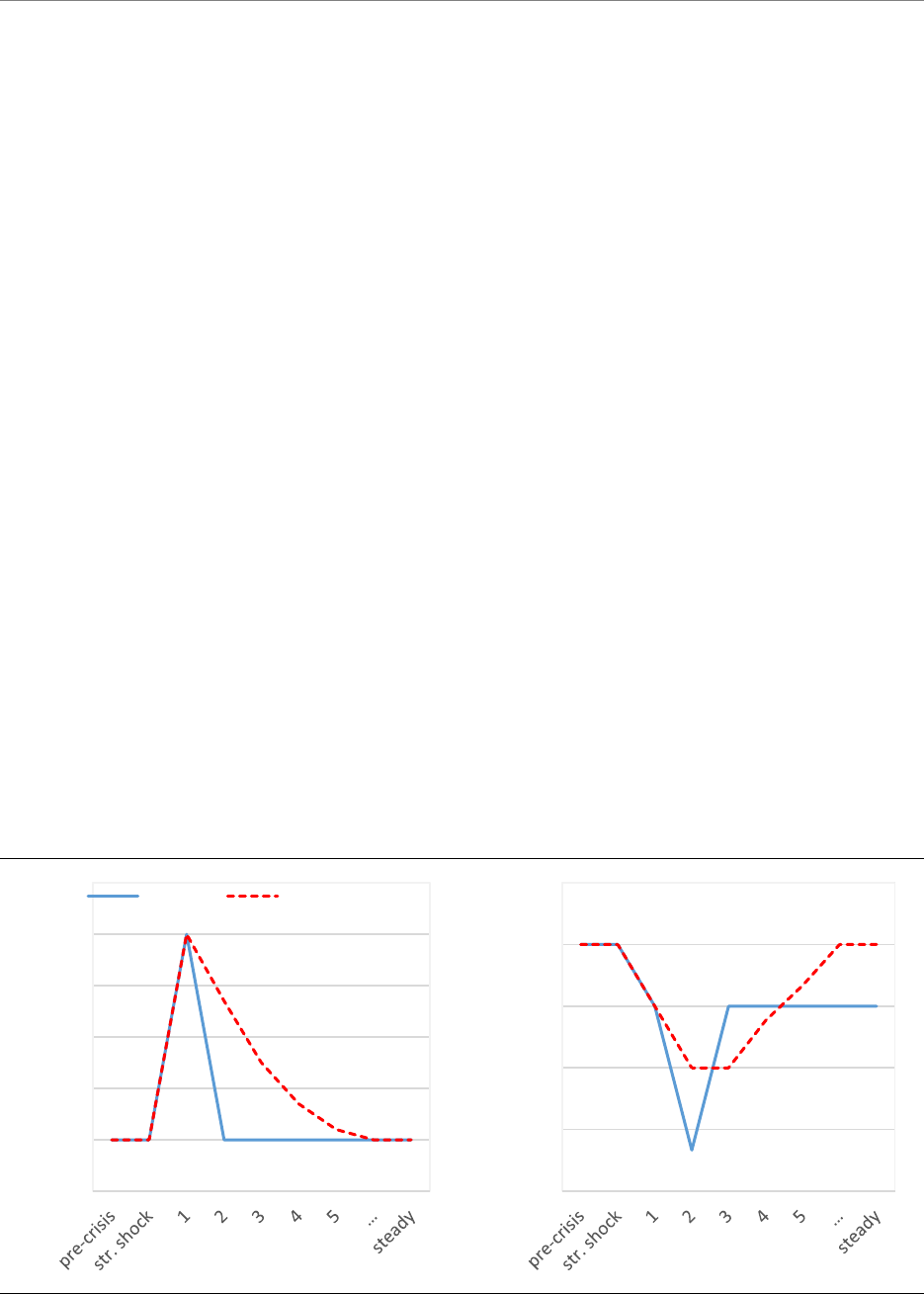
IPOL | Economic Governance and EMU Scrutiny Unit (EGOV)
106 PE 747.830
At least two caveats regarding the innovative strategy deserve close attention.
First, the fiscal policies associated with CFC must be thoughtfully designed and efficiently executed,
because they should contend with the concurrent innovations implemented in other international
areas. The challenge lies in ensuring that the related policy mix is effective with respect to the EU’s
internal goals as well as to the evolution of international competitiveness.
Second, national fiscal policymakers should avoid the temptation of utilising an appropriate CFC to
hide the expansion of their domestic fiscal policies. Maintaining an efficient relation between these two
levels of fiscal policies is crucial. The production of EPGs is envisaged as an instrument to drive
innovation and structural changes, while domestic fiscal policies are critical to pursuing fiscal
sustainability. The innovative policy mix will be effective if there is a balance between the stances of
the different policies. As our analysis points out, the current phase of the EU economy requires that the
stance of the national fiscal policies (mainly, in countries with high public debt) is harmonised with that
of the monetary policy, so that the pressure on sovereign debts is not exacerbated and the expected
impact of the ECB policy is not distorted.
The preceding pedagogical illustration of the two policy strategies is static and could be extended by
considering the different dynamics implied. Without going into complex analytical details, we offer a
rough comparison of the dynamic impacts that characterise the conventional and the innovative
strategy, respectively, using Figure 3. Panel (a) of this figure illustrates the evolving trend of the inflation
process that derives from each of the two strategies. Panel (b) compares, instead, the different results
with respect to output. The conventional approach leads to a more rapid decline in the inflation rate,
which reaches its target in the short-to-medium term; however, the cost of this adjustment is a more
severe recession and a recovery that is quite rapid but largely insufficient to reach the original long-
term equilibrium path. The innovative strategy implies that the average inflation rate takes more time
to stabilise, and the economy takes more time to reach its long-term equilibrium; however, the short-
term economic recession is milder, and the long-term equilibrium path matches the original potential
output.
Figure 3: Dynamic comparison between the two strategies
Source: Authors’ elaboration.
Note: The figure is clearly evocative to drive the reader into the adjustment dynamics. The word ‘steady’ stands for the
long-run equilibrium in Figures 1 and 2, i.e., the steady state.
1
2
3
4
5
6
7
Inflation
standard innovative strategy
88
91
94
97
100
103
Output

Achieving the right fiscal-monetary mix (in the context of the economic governance review)
PE 747.830 107
Figure 3 offers qualitative indications with a more precise quantitative assessment expected from the
models.
89
Nonetheless, this figure is sufficient to highlight that the two policy strategies have different
trajectories that lead to different results. The comparison of these respective results is not easy to do.
How can we compare the cost of a slower recovery to that of a deeper recession? How can we compare
the cost of a more persistent excessive inflation to that of long-term growth below the potential?
Different EU policymakers do not share a common preference ordering relative to the pros and cons of
economic growth, recession, excess inflation, and so on.
Here, we do not directly address these questions, which need – as a preliminary step – quantifications
based on a common unit of measure. However, two points should be made. The first is that the
quantifications should consider the different horizons (short and long term) of the relative economic
and social variables. The second is that the quantifications should consider the different risks involved
in the two policy strategies. On the one hand, the standard strategy has a more predictable impact,
whereas the innovative one has higher risks; on the other hand, the innovative strategy can allocate a
significant part of these risks to the EU, whereas the standard one is based on more traditional tools.
Our analysis cannot state that one of the two strategies dominates the other in the EU. However, an
uncontroversial hierarchy between the two strategies arises if we adopt a specific perspective. The
deep recession and low potential growth do not ease changes in the EU production model. If the ECB
is left alone in facing an excessive inflation rate in the short term, its increase in policy interest rates and
its reduction of liquidity supply will make the financing of public and private investments as well as the
green and digital transitions more costly and their implementation more difficult (Lane, 2023). These
constraints will become even more binding if two additional aspects relating to expectations are
considered. First, the restructuring of production processes and innovative choices, required by the
transitions, become riskier in a recessionary setting due to worsening expectations. Second, as stressed
above (see Section 2), the policy mix designed by the innovative strategy can strengthen the anchorage
of inflation expectations to the medium-term target thanks to its announced and credible medium-
term impact on the supply side. Hence, in our setting, the innovative policy strategy dominates the
conventional one.
89
In the next section, we will offer additional qualitative considerations. A quantitative assessment is, however, beyond the scope of the
present paper.

IPOL | Economic Governance and EMU Scrutiny Unit (EGOV)
108 PE 747.830
THE FISCAL NEEDS: SHOULD THE EU WAIT FOR ITS
TRANSITION?
4.1. Towards a new EU production model
The euro area has experienced a significant slowdown in productivity growth since the international
financial and ‘real’ crises (2007-2009).
90
The underlying causes of this sluggish performance can be
traced back to different factors, some with long-standing structural roots. Here, referring to a few main
determinants linked to the euro area’s policy mix will suffice.
Unlike the expansionary policy reaction in the United States, the European institutions responded to
the 2007-2009 crisis by adopting a swinging monetary policy and strengthening the central fiscal rules.
The aim was to constrain those EU member states with a high public debt-to-GDP ratio and harmful
imbalances in their current accounts to adjust their internal and external disequilibria. To pursue these
goals, the euro area’s weakest member states had to implement restrictive, and hence pro-cyclical,
fiscal policies implying a dramatic compression of wages and internal aggregate demand. On the one
hand, this policy mix led to sovereign debt and banking crises in the euro area, which flowed into a
new economic recession (2011-2013) and a high risk of deflation (2013-2014).
91
On the other hand, this
policy improved the area’s short-term competitiveness in international markets without increasing
long-term labour productivity.
92
Then, from mid-2015 to the end of 2018, the euro area recorded a
weak recovery due to an unconventional and expansionary monetary policy and a more flexible
definition of central fiscal rules (see Rostagno et al., 2021). In any case, even in that last period the
monetary policy remained the main responsible for the anti-cyclical initiatives. Hence, differently from
the United States and China, euro area economies were unable to lead critical innovative trajectories,
and their productivity dynamics continued unsurprisingly to be weak.
The new expansionary policies implemented in response to the pandemic crisis in the spring of 2020
resulted in further exceptional monetary and fiscal measures, including a temporary CFC. This new
policy mix was able to confine the worst depression of the last two centuries to the first half of 2020.
However, due to the binding supply bottlenecks and the need to support the income of firms and
households hit by the economic lockdown, it did not aim at relaunching the EU medium to long-term
economic growth. This relaunch became the main objective of the EU policy mix since mid-2021, when
the NGEU started the implementation phase through its main programme (the RRF) and the related
NRRPs.
The three pillars of the RRF (the green and digital transitions and social inclusion) showed that the EU
economy had a relatively strong position in terms of environmental impact and social welfare but was
suffering technological gaps with the United States and China (see Buti and Messori, 2021b, Figures 3
and 4, and Table 1). These gaps were so significant that they hindered the reproduction of the strong
points. Energy-intensive and export-driven productions have characterised the EU economy model
centred on solid but mature technologies in its most competitive sector, i.e., manufacturing. The
services sector has become large but with broad pockets of inefficiency and an ancillary position with
respect to industry. The consequent lack of innovation in the EU economy has increased its risk of
90
The decline in productivity dynamics is evident across various measurements, including output per work hour (a proxy of Marginal Labour
Productivity) and Total Factor Productivity.
91
The ‘doom-loop’ between banking and the sovereign debt crisis in the euro area has been analysed by several authors (for instance: De
Grauwe and Ji, 2013; Sapir et al., 2014). An assessment of the risk of deflation is offered by Canofari and Messori (2015).
92
See Esposito and Messori (2018). It should be recalled that Ireland is an exception. This country utilised the European aid program, required
to handle the impact of the ‘doom-loop’, to implement innovative investments and to structurally increase its labour productivity.

Achieving the right fiscal-monetary mix (in the context of the economic governance review)
PE 747.830 109
falling short of the evolving international technological frontiers. The programme proposed by the new
Commission at the end of 2019 that focused on green and digital investments was the first attempt to
upgrade the EU production model.
The implementation of the RRF since 2021 and its three pillars have put in motion a “growing machine”
for the relaunch of the EU economy in the long term (Padoan, 2023). However, only the unexpected
persistence of supply bottlenecks and the Russian invasion of Ukraine with the consequent energy
crisis have made it evident that the EU’s economy was losing its international competitiveness and
needed a new and innovative production model and not just an upgrade (see Buti and Messori, 2023).
This acknowledgment has highlighted that the green and digital transitions and improvement in social
inclusion can be achieved in a time largely beyond the end of the RRF (mid-2026) and that radical
economic changes cannot be supported only by a temporary, even if significant, CFC. The construction
of a new EU production model requires an innovative industrial policy, centralised at the EU level and
aimed at incentivising efficient public and private investments. Here, it would be inappropriate to go
into the details of the possible features of this new European industrial policy. It suffices to emphasise
that public and private investments should be financed by a permanent and significant CFC and by
mobilising vast private financial wealth.
In such a framework, the centralised fiscal policy should be expansionary, and the liquidity in circulation
should be abundant. Implementing these policies would have been highly ambitious at the beginning
of 2021, when the euro area economy was in a low-inflation and starting-recovery phase. It has become
a dramatic challenge today. As showed in Benigno et al. (2023b) and mentioned in the previous
sections, the price index started to pick up in the euro area during the first quarter of 2021 and the
inflation rate has exceeded the 2% target since July 2021. The ECB changed the stance of its monetary
policy in March 2022 and implemented a dramatic sequence of policy interest rate increases from July
2022 to September 2023 accompanied by a more gradual but severe reduction in liquidity supply. At
mid-September 2023, there is a high probability that these monetary policy decisions will lead to an
economic recession in a euro area already in stagnation (see European Commission, 2023).
In the current framework, it is understandable that the ECB is concerned about again being “the only
game in town” able to bring the excessive inflation rate under control. The considerable risk of a
persistent recession in the euro area weakens the willingness of many national policymakers to reverse
the stance of their expansionary fiscal policies implemented in the post-pandemic phase. Specifically,
in countries with high public debt stocks, the attempt is to use the RRF resources to overcome the lack
of space in the national fiscal policies due to the restrictive monetary policy implemented by the ECB.
4.2. The role of European public goods
EPGs are pivotal for implementing the triple transition (green, digital, and social) as the way to change
the EU production model, to increase sustainable growth within the area, and to enhance European
competitiveness in international markets. Being centralised projects with common funding, the EPGs
are a specific component of the CFC; however, they offer a less controversial option due to their
potential to weaken the “net balance” narrative among EU countries and to reduce tensions between
creditors and debtors (Buti et al., 2023.) The vital role played by the EPGs in the EU evolution has
become clear in the economic aftermath of the Russian invasion of Ukraine. However, the importance
of their production was already raised when the RRF’s potentials were hampered by the national
utilisation of the EU funds.
Buti et al. (2023; see also: Fuest and Pisany-Ferry, 2019) identify six priority areas for EPGs: digital
transition, green transition and energy, social transition, raw materials, security and defence, and
health. These areas address crucial EU challenges such as the aims of achieving climate neutrality,
reducing technological gaps, enhancing education and re-skilling, and bolstering open strategic

IPOL | Economic Governance and EMU Scrutiny Unit (EGOV)
110 PE 747.830
autonomy. It follows that a moderate stance is necessary to finance, produce, and deliver adequate
EPGs in a period characterised by a restrictive monetary policy. As already stressed, the implementation
of EPGs also requires a permanent CFC and appropriate European technical vehicles. As Buti et al. (2023)
point out, the intrinsic links between a permanent CFC, effective European vehicles, and the availability
of EPGs raise legal, technical, and institutional problems. It is sufficient to recall that the current
European Treaties do not leave an adequate space for centralised fiscal policies. Consequently,
European institutions face difficulty in planning increases of “own resources” to strengthen the
production of EPGs. Moreover, EU programmes such as the Connecting Europe Facility, InvestEU, and
the Innovation Fund can ease the delivery of EPGs, but they require significant improvement and
redesigning.
Here, we briefly examine three key sectors in which the availability of EPGs is clearly required for
implementing innovations that – in their turn – are essential parts of the new EU production model,
and for strengthening the social cohesion within the area. These sectors are defence (entirely reliant
on public spending), climate transition (where resources come from the public and private sectors at
roughly a one-third/two-thirds ratio), and digital transition (primarily private-driven, yet involving
important public resources).
Let us address at some length the financial aspects of the green transition. The European Commission’s
central scenario suggests that achieving a 55 per cent reduction in greenhouse gas emissions by 2030
would require about €360 billion in total investments (both public and private) for energy and
transportation (European Commission, 2020a). These financial resources are equivalent to around 2 per
cent of the EU’s GDP per annum. Moreover, additional and significant investments and related financial
resources will be required beyond 2030 to achieve net-zero emissions by 2050. Finally, additional
expenses derive from eliminating any dependence on Russian fossil fuels by 2027. According to the
REPowerEU Communication (see European Commission, 2022), the EU’s geographical reallocation of
its demand for fossil fuel will require substantial investments.
European and national regulations, centralised and decentralised taxation policies, carbon pricing,
subsidies and non-pecuniary incentives for private investments can help reduce the burden for the
public sector. However, in various cases (for instance, energy-network externalities and informational
inefficiencies), private investment cannot integrate the public one. Current projections suggest that
the contribution of the public sector to the EU’s overall climate investments should amount to about
one-third, with additional investments of around 0.6 to 1.8 per cent of EU’s GDP needed and still not
covered.
93
The EU’s multiannual financial framework and NGEU fail to address this funding gap; and
the declining private investments are largely insufficient to solve or even to mitigate the problem.
The implication is that addressing the impact of climate change in the EU will lead to heavy
consequences in terms of CFC and national debt sustainability. As Zenios (2021) outlines, there will be
a need for dramatic improvements in public investments. To avoid unsustainable increases of public
expenditures and borrowing costs in the most fragile EU member states with negative consequences
in terms of economic stability and growth, the production of appropriate EPGs will become crucial. The
latter could fill a large part of the gap. Leaving aside the other difficulties that hinder this production
and delivery, two necessary conditions directly relate to our topic: an effective policy mix and an
accommodating monetary policy. In this respect, the innovative policy strategy discussed in Section 3
becomes fundamental.
Let us now outline some problems relating to digital transition by focusing again on the funding gap.
The European Commission has calculated an investment gap for digital transformation of €125 billion,
93
The reference is to Eurostat (2021)

Achieving the right fiscal-monetary mix (in the context of the economic governance review)
PE 747.830 111
equivalent to 0.9 per cent of GDP per annum (European Commission, 2020a). A large portion of this
funding requirement should be met by the public sector. In this respect, it must be recalled that,
according to the EU Digital Compass 4 strategy, the EU’s goal is to achieve the 100 per cent online
provision of essential public services by 2030 (European Commission, 2023a). Moreover, the
involvement of the public sector is crucial in enhancing digital skills, promoting digital inclusion, and
facilitating the digitalisation of small- and medium-sized firms. Finally, several EU countries with
substantial public debt exhibit subpar performance in digital public services and digital skills. This
picture is worsened by the fact that the NGEU programmes are planning to cover a small fraction of
these investment and financial gaps (Darvas and Wolff, 2021.) Hence, even in this case, the EPGs and –
consequently – an effective policy mix and an accommodating monetary policy should play a
substantial role. In this respect, the innovative policy strategy is again crucial.
As far as defence is concerned, it is necessary to recall that in 2006 the defence ministers of the North
Atlantic Treaty Organization (NATO) committed to allocating a minimum of 2% of their respective
countries’ GDP to defence spending. In 2014, Russia’s annexation of Crimea and the Middle East turmoil
prompted a new engagement: countries falling below the 2 per cent threshold pledged to reach this
target within a decade. As of 2021, Eurostat data reveals that the average defence spending in the EU
stood at 1.3 per cent of GDP, with only Greece, Latvia, and Estonia meeting the 2 per cent
requirement.
94
NATO’s data (NATO, 2023) slightly varies from Eurostat’s, indicating that even Poland
surpassed the 2 per cent mark in 2021. However, the crucial factor is that the more recent and partial
data (2022), as well as the announced ambitious national plans, indicate that defence spending in the
EU continues to grow. The persistent war at the eastern borders of the EU implies that this growing
trend will further strengthen in the near future. Hence, it is urgent to start the centralisation of
European defence to effectively allocate the growing public spending. In this respect, EPGs should play
a fundamental role.
Despite the ongoing challenges and difficulties, the transformative potential of EPGs to shape EU
economic dynamics underscores their importance for EU institutional evolution. As shown in the
previous Sections, the policy mix and monetary policy have the decisive duty to support the production
of EPGs, and, in this respect, the innovative policy strategy appears to be the dominant strategy.
4.3. The policy mix and social cohesion
95
The rise in energy and import goods prices has adversely impacted real incomes, leading to recent
bargaining between firms and employees about a fair distribution of the losses. Firms are inclined to
raise their prices to safeguard their profit margins, while workers consider higher wage claims to offset
the erosion of their purchasing power. These dynamics can play a role in driving inflation. If each party
unilaterally tried to compensate for their specific income losses, the interconnectedness of expanding
profit margins, increasing nominal wages, and surging prices could fuel a continuous price hike. The
ECB President has warned against the potential risk of the above-described “tit-for-tat” game between
firms and workers, as this interaction would interfere with the ECB’s 2% inflation target.
96
Lagarde
emphasised that this risk justifies a long-term monetary tightening strategy to maintain economic
equilibrium during downturns and anchor expectations.
94
See Darvas and Wolff (2022); and Baccianti (2022).
95
This section is largely based on Ciccarone and Di Bartolomeo (2023).
96
Lagarde (2023b).

IPOL | Economic Governance and EMU Scrutiny Unit (EGOV)
112 PE 747.830
The risk of escalating social disputes, particularly against the backdrop of increasing income inequality,
is substantial.
97
Due to differences in production methods, labour market setups, and industry
strategies among EU countries, these disputes could have varying national impacts and cause further
strain on EU integration. The potential monetary tightening threatened by Lagarde could be less
effective or even distortionary in this setting. Anchoring expectations is a necessary but insufficient
condition to ensure monetary stability. Social agreement on income distribution grounded on income
policies is also required. Hence, it is crucial to understand that the ECB’s stabilisation strategy
fundamentally depends on a consensus about income distribution. In the presence of inflation, income
distribution is altered between those who can and those who cannot adjust the price of their goods or
services upward. The assignment of the concept of ensuring monetary stability to central banks arises
precisely from the desire to prevent income redistribution ‘through inflation’, not determined by
elected public authorities. With zero inflation, in the absence of such government measures, the
distribution is maintained only if there is consensus on it; otherwise, price-wage spirals are triggered.
In this context, Ciccarone and Di Bartolomeo (2023) recently revisited Tarantelli and Modigliani’s
proposal for managing inflation during the 1980s. Tarantelli and Modigliani were aware of the link
between ‘programmed inflation’ as an anchor of expectation and the social conflict related to income
distribution. In fact, according to Ciccarone and Di Bartolomeo (2023), the most ground-breaking facet
of their proposal was not merely the predetermination of inflation or the portrayal of unions as
proactive economic agents. Instead, it was the visionary realisation that steering inflation toward a
predetermined target requires a coordination mechanism fundamentally distinct from those
subsequently identified by theoretical frameworks incorporating rational expectations.
98
Tarantelli and
Modigliani’s proposal suggests that coordination elements
99
can skilfully guide expectations in systems
where the assumption of rational expectations cannot be invoked.
100
This idea aligns with the
Keynesian perspective that institutions, conventions, and social agreements can act as tools to
orchestrate the choices of economic actors, even when they might be unstable. When paired with
businesses setting prices based on forecasted inflation, this coordination ensures that actual inflation
matches the target.
In contemporary economies, the central bank’s inflation target has taken on a role akin to the one
Tarantelli and Modigliani assigned to the predetermined inflation rate agreed upon by social partners
and the government. However, this substitution will be robust only if it is supplemented by an income
distribution agreement. For an extended period, the concept of inflation targeting excluded the
possibility of incorporating social agreements to manage inflation. We posit that the significant
fluctuations in current inflation rates (unprecedented in the euro area) and disparities in income
distribution could trigger dynamics that monetary policy alone cannot handle. In the euro area, the
unique monetary policy has asymmetric impacts because countries vary in production structure and
labour relation types.
97
Some firms attempted to push profit margins beyond what increased costs should justify, aiming to offset past losses (from events such as
the pandemic). However, while firms can adjust prices quickly, in euro area countries wage changes often require lengthy negotiations. During
inflationary periods, this mismatch can initially cause a steep drop in real wages, potentially prompting workers to seek hefty wage raises
later.
98
These frameworks underpin the anti-inflationary monetary policies anchored to rigid rules, central bank transparency, reputation, and
similar tenets, progressively applied globally since the 1980s. Especially within inflation targeting regimes, an optimally devised monetary
policy poses a credible threat to the private sector, compelling it to endure high interest rates, engendering unemployment and adverse
production gaps until the expectations of both workers and firms align with the target.
99
Such as planned (low) inflation and negotiated (low) wages.
100
Either due to the absence of objective probability distributions concerning significant events (Knight, 1921; Keynes, 1921) or owing to their
non-stationarity over time.

Achieving the right fiscal-monetary mix (in the context of the economic governance review)
PE 747.830 113
It is paramount to recognise that the current economic landscape significantly diverges from that
observed by Tarantelli and Modigliani.
101
In addressing inflation and income distribution conflicts, a
policy adaptation of Tarantelli and Modigliani’s approach should have supported a social agreement
aligning wage moderation with improved public services and workers’ involvement in policy decisions.
Nonetheless, their proposition could still hold pertinence within the present circumstances. Today, a
policy adaptation of their approach could be based on the production of specific EPGs and appropriate
and centralised social protection during the transition to a new EU production model. Even in this case,
the aim would be to prevent wage-price spirals and favour more stable economic conditions. However,
these new income distribution agreements also have consequences for selecting an effective policy
mix and monetary policy strategy.
It is increasingly acknowledged that the unavoidable one-size-fits-all approach of the ECB’s monetary
policy tends to favour euro area countries with more flexible labour markets. However, a well-
structured social agreement could counteract this conclusion. Let us assume that the main results of
the social agreement are an additional production of EPGs and stronger social inclusion during the
green and technological transitions in exchange for wage moderation. These results would lead to at
least three achievements in terms of an effective policy mix: they can incentivise CFC and protect low
income, thus mitigating the positive supply counter-shock, bringing under control the possible source
of inflationary pressure, and supporting the implementation of the EU production model; they can
reduce national policymakers’ aversion to adjusting the disequilibria in their public balance sheets;
they can avoid excessive monetary policy restrictions because the ECB would not be left alone in
handling an excessive inflationary process.
In short, the previous analysis shows that introducing a social coordination mechanism in the policy
mix strengthens the dominance of the innovative policy strategy over the conventional one.
101
Their socio-economic context was that of the mid-1980s. At that time, the objective to keep inflation low to bolster the competitiveness of
domestic production clashed with two opposite positions: the endeavours of trade unions to uphold workers’ purchasing power by increasing
nominal wages and businesses’ efforts to determine prices ensuring profit margins congruent with those of their international competitors.

IPOL | Economic Governance and EMU Scrutiny Unit (EGOV)
114 PE 747.830
CONCLUSION
The structural shift of the EU economy, driven by the geopolitical and economic shocks triggered by
the war in Ukraine, requires the attention of the EU institutions. A strategic approach is essential as the
EU faces ongoing inflation and the necessity of transforming its production model to prevent a
prolonged decline and avoid social contrasts in the context of increasing inequalities within and
between generations. This task calls for an expansionary centralised fiscal policy coupled with a
common industrial strategy, while addressing inflation concerns through moderate restrictive
monetary measures and fiscal interventions. In the present paper, we have presented an innovative
policy mix to navigate the complex landscape created by this challenge.
Our innovative perspective acknowledges the potential short-term inflationary effects of centralised
fiscal policies but highlights the capacity for producing specific EPGs to affect aggregate supply, even
in the short run. Additionally, in cases where the CFC and production of EPGs drive transformative
restructuring accompanied by temporary reductions in the activity level for green and digital
transitions, the medium-term outcome will still be an expanded aggregate supply. Combining a
moderately restrictive monetary policy, gradual national fiscal adjustments and an expansionary CFC
makes it possible to mitigate inflationary pressures, reduce recession risks, manage the side effects of
a temporary inflation surge, and support long-term sustainable growth.
In conclusion, the imperative to reshape the EU production model underscores the need for a well-
balanced policy mix. It is crucial not to rely solely on monetary policy. This justifies our preference for
the innovative policy strategy outlined above. The resulting policy mix, focusing on EPG production,
moderately restrictive monetary measures, and tailored national fiscal adjustments can be effectively
implemented only within a supportive economic governance framework. The interplay between this
policy mix, the role of the ECB, and the impact of fiscal regulatory reform should not be underestimated,
though specific details are beyond the scope of this paper.

Achieving the right fiscal-monetary mix (in the context of the economic governance review)
PE 747.830 115
REFERENCES
• Baccianti, C. (2022), “The public spending needs of reaching the EU’s climate targets”, Greening
Europe 2022, European Public Investment Outlook, F. Cerniglia and F. Saraceno (editors),
Cambridge, UK, Open book Publisher, pp. 107–128.
• Benigno, P.P., P. Canofari, G. Di Bartolomeo and M. Messori (2023a), “The Implementation and
Rationale of the ECB's New Inflation Target”, Journal of Policy Modeling, vol. 45, n. 2, pp. 286 – 304.
Earlier version for the committee on Economic and Monetary Affairs, Policy Department for
Economic, Scientific and Quality of Life Policies, European Parliament, Luxembourg, November
2021, pp. 1-28.
• Benigno, P.P., P. Canofari, G. Di Bartolomeo and M. Messori (2023), “Inflation dynamics and
monetary policy in the euro area”, Publication for the committee on Economic and Monetary
Affairs, Policy Department for Economic, Scientific and Quality of Life Policies, European Parliament,
Luxembourg, March, pp. 1-42.
• Bartsch, E., A. Bénassy-Quéré, G. Corsetti, and X. Debrun (2021), “It’s all in the mix: How monetary
and fiscal policies can work or fail together”, Geneva Report on the World Economy No. 23.
• Baccianti, C. (2022), “The public spending needs of reaching the EU’s climate targets”, Greening
Europe 2022, European Public Investment Outlook, F. Cerniglia and F. Saraceno (editors),
Cambridge, UK, Open book Publisher, pp. 107–128.
• Buti, M. and M. Messori (2021a), “Euro area policy mix: From horizontal to vertical coordination”,
CEPR Policy Insight, n. 113, October.
• Buti, M. and M. Messori (2021b), “Towards a new international economic governance: The possible
role of Europe”, STG Policy Papers, School of Transnational Governance, November, Issue 2021/20.
• Buti, M. and M. Messori (2022a), “A central fiscal capacity to tackle stagflation”, VoxEu, 3 October,
pp. 1-5.
• Buti, M. and M. Messori (2022b), “A central fiscal capacity in the EU Policy Mix”, CEPR, Discussion
Paper Series, n. 17577, October, pp. 1-30.
• Buti, M. and M. Messori (2023), “Resetting the EU’s business model after the watershed”, EPC
Discussion Paper, 13 February, pp. 1-8.
• Buti, M., A. Coloccia and M. Messori (2023), “European public goods”, VoxEu, 9 June, pp. 1-8.
• Canofari, P., G. Di Bartolomeo and M. Messori (2022), “Dancing on the edge of stagflation”,
Publication for the committee on Economic and Monetary Affairs, Policy Department for Economic,
Scientific and Quality of Life Policies, European Parliament, Luxembourg, September, pp. 1-28.
• Canofari, P. and M. Messori (2015), “Risks of deflation in the EMU. Why is this time so deceitful? ”SEP
Policy Brief, n. 9 January, pp. 1-19; now in M. Messori, Recovery pathways. The Difficult Italian
Convergence in the Euro Area, Bocconi University Press, Milan.
• Ciccarone G. and G. Di Bartolomeo (2023), “Franco Modigliani and Ezio Tarantelli on wage
moderation and political exchange: A lesson to be learned in the new age of inflation”, Sapienza
University of Rome, mimeo.
• Darvas, Z. and G. Wolff (2021), “A green fiscal pact: climate investment in times of budget
consolidation”, Policy Contribution 18/2021, Bruegel.

IPOL | Economic Governance and EMU Scrutiny Unit (EGOV)
116 PE 747.830
• De Grauwe, P. and Y. Ji (2013), “From panic-driven austerity to symmetric macroeconomic policies in
the eurozone,” Journal of Common Market Studies, 51(S1), pp. 31–41.
• Draghi, M. (2023), “The next flight of the bumblebee: The path to common fiscal policy in the
eurozone”, 15th Annual Feldstein Lecture, NBER, Cambridge Ma., 11 July.
• Esposito, P. and M. Messori (2018), “Competitive or recession gains? On the recent macroeconomic
rebalances in the EMU”, The North American Journal of Economics and Finance, December, pp. 1-
22.
• European Commission (2020a), “Impact assessment accompanying the document: Stepping up
Europe’s 2030 climate ambition. Investing in a climate-neutral future for the benefit of our people”,
SWD/2020/176 final, Brussels, Belgium.
• European Commission (2020b), “Fiscal Statistical Tables providing background data relevant for
the assessment of the 2022 Stability and Convergence Programmes”. SWD/2022/640 final,
Brussels, Belgium.
• European Commission (2022), “Communication from the Commission to the European Parliament,
the European Council, the Council, the European Economic and Social Committee and the
Committee of the Regions. REPowerEU Plan”, Brussels, Belgium.
• European Commission (2023a), “Communication: 2030 Digital Compass: the European way for the
Digital Decade”, Brussels, Belgium.
• Eurostat (2021), “General government expenditure by function (COFOG),” in [GOV_10A_EXP_
custom_5665704] Eurostat database.
• Eurostat (2023), “Euroindicators”, various issues.
• Fuest, C. and J. Pisani-Ferry (2019), “A primer on developing European public goods”, EconPol Policy
Report, Vol. 3, November.
• Keynes, J.M. (2021), A treatise on probability, in The collecting writings of John Maynard Keynes,
vol. 8, Royal Economic Society, London, 1978.
• Knight, F. H. (1921), Risk, Uncertainty and Profit. University of Illinois, Urbana. Reprinted by Dover
Publications, New York, 2006.
• Lagarde, C. (2022), “Monetary policy in a new environment”, European Banking Congress, Frankfurt,
18 November.
• Lagarde, C. (2023a), “The path ahead”. Speech by Christine Lagarde, President of the ECB, at The
ECB and Its Watchers XXIII Conference, Frankfurt am Main, 22 March 2023.
• Lagarde, C. (2023b), “Central Banks in a fragmenting world”, Council on Foreign Relations C. Peter
McColough Series on International Economics, New York, 17 April.
• Lane, P.R. (2023), “The banking channel of monetary policy tightening in the euro area”, Macro,
Money and Financial Frictions Workshop, NBER, Cambridge Ma., 12 July.
• NATO (2023), “Defence Expenditure of NATO Countries (2014-2023)”, Press Release, Brussels.
• Padoan, P.C. (2023), “Next Generation EU as a Growth Machine”, Astrid Rassegna, March, n. 6.
• Rostagno, M., Altavilla, C., Carboni, G., Lemke, W., Motto, R., Saint Guilhem, A., and J. Yiangou (2021),
Monetary policy in times of crisis: A tale of two decades of the European Central Bank, Oxford
University Press, Oxford.

Achieving the right fiscal-monetary mix (in the context of the economic governance review)
PE 747.830 117
• Sapir, A., G. B. Wolff, C. de Sousa, and A. Terzi (2014) “The Troika and financial assistance in the euro
area: successes and failures”, Study on the request of the Economic and Monetary Affairs
Committee, European Parliament.
• Schnabel, I. (2023), “The risks of stubborn inflation”, The Euro50 Group Conference on New
challenges for the Economic and Monetary Union in the post-crisis environment, Luxembourg, 19
June.
• Zenios, S. A. (2021), “The risks from climate change to sovereign debt in Europe”
, Policy
Contribution 16/2021, Bruegel.

IPOL | Economic Governance and EMU Scrutiny Unit (EGOV)
118 PE 747.830

Fiscal adjustment supports
the fight against sticky
inflation
Daniel GROS
Farzaneh SHAMSFAKHR

IPOL | Economic Governance and EMU Scrutiny Unit (EGOV)
120 PE 747.830
Abstract
Fiscal policy becomes less potent in affecting output in an
inflationary environment. As the economy nears full employment
an increasing part of any fiscal stimulus either crowds out other
expenditure or leads to higher prices. This reinforces the case for
an accelerated reduction in deficits, especially through the
termination of energy subsidies that are no longer appropriate as
energy prices have returned to pre-war levels.
An unintended (but predictable) consequence of the past bond
buying schemes of the ECB (PSPP and PEPP) is that the net
income of the Eurosystem is likely to fall by about
EUR 70–80 billion, or 0.5–0.6 % of GDP, making the fiscal
adjustment harder.
This document was provided by the Economic Governance and
EMU Scrutiny Unit at the request of the Committee on Economic
and Monetary Affairs (ECON) ahead of the Monetary Dialogue
with the ECB President on 25 September 2023.

Achieving the right fiscal-monetary mix (in the context of the economic governance review)
PE 747.830 121
CONTENTS
LIST OF ABBREVIATIONS 122
LIST OF FIGURES 123
LIST OF TABLES 123
EXECUTIVE SUMMARY 124
INTRODUCTION 125
FISCAL POLICY AWAY FROM THE LOWER BOUND 127
2.1. A simple framework 127
2.2. Empirical estimates of changing multipliers 128
A STEEPER PHILLIPS CURVE? 129
3.1. The renaissance of the Phillips curve 129
3.2. Can fiscal policy shift the curve? 130
THE FISCAL COST OF CENTRAL BANK BOND BUYING 132
MONETARY POLICY AND THE (NEW?) ECONOMIC GOVERNANCE FRAMEWORK 135
CONCLUSION 137
REFERENCES 138

IPOL | Economic Governance and EMU Scrutiny Unit (EGOV)
122 PE 747.830
LIST OF ABBREVIATIONS
ECB
European Central Bank
EMU
Economic and monetary union
PEPP
Pandemic emergency purchase programme
PSPP
Public sector purchase programme
SGP
Stability and Growth Pact
TLTRO
Targeted longer-term refinancing operations
QE
Quantitative easing

IPOL | Economic Governance and EMU Scrutiny Unit (EGOV)
124 PE 747.830
EXECUTIVE SUMMARY
• Fiscal policy in the euro area is still projected to be slightly expansionary, with the
structural primary balance remaining in deficit (1 % of GDP in 2023 and projected to be
1.5 % in 2024). This is about 2 percentage points below the surplus of 1 % of GDP in 2018.
• The pre-pandemic benchmark is approximately equivalent to the requirement to put debt
levels on a sufficiently declining path, as required by the proposed new governance rules.
• Accelerating the move towards this benchmark would make a material contribution to
bringing inflation back under control.
• Fiscal policy adjustment should be less costly in terms of lost output or higher
unemployment than during the period of low inflation, because any increase in demand
will lead to higher interest rates, which will crowd out other expenditure.
• Moreover, a key economic parameter, the Phillips curve, is likely to have become steeper,
implying that any small reduction in output might lead to a large reduction in inflation.
• Lowering inflation is not the primary aim of fiscal policy, but at the present junction fiscal
retrenchment will support monetary policy. An acceleration of the primary balance
reduction planned for 2024 would thus be appropriate.
• The ECB’s quasi-fiscal operations (i.e. the public sector purchase programme and the
pandemic emergency purchase programme) are now having unintended fiscal
consequences, as the Eurosystem is likely to incur considerable losses that will ultimately
have to be borne by national treasuries, creating a substantial fiscal headwind.
• The sharp increase in the volatility of interest rates over the last few years, which is likely
to continue, suggests that it will not be sufficient to set a path for net primary expenditure
to reliably achieve the desired reduction in debt ratios. This uncertainty about the path for
the debt ratio is particularly high for highly indebted countries, i.e. those for which a reduction
in the debt ratio is most important.

Achieving the right fiscal-monetary mix (in the context of the economic governance review)
PE 747.830 125
INTRODUCTION
The ongoing discussion about reforms to the economic governance framework coincides with the
emergence from a double crisis and a sea change in the conditions under which fiscal policy impacts
the economy.
Fiscal policy has been in crisis-related challenges since 2020, with the rules of the Stability and Growth
Pact (SGP) suspended first because of the COVID-19 crisis and then because of a sharp peak in the
energy crisis following Russia’s invasion of Ukraine. With energy prices back to pre-war levels and the
economy having recovered from the COVID-19 recession, one can no longer argue that extraordinary
circumstances require large deficits. As Thygesen et al. (2023) argue, ‘it is time to put the fiscal
toothpaste back in the tube’
102
.
Of course, the average deficit numbers hide large differences across member countries and a return
to the status quo ante is not necessarily the main argument for why the present level of deficits is not
appropriate. Under the existing rules, Member States would have to start reducing debt levels in 2024
by one twentieth of the distance to the 60 % of GDP reference value. Under the proposed new rules,
the required adjustment still be substantial for at least some cases. The Commission has not published
the parameters it would suggest to individual Member States under its own proposal, but existing
simulations (Zettelmayr et al., 2023) indicate that just to stabilise the debt ratio, highly indebted
countries like Italy and Spain would have to improve the primary balance over and above the value
planned for 2024 by over 1 point of GDP. The more relevant comparison for macroeconomic policy is
with the 2023 value. If the aim is to reduce the debt ratio by at least 1 percentage point annually, the
required adjustment relative to 2023 would rise to over 3 percentage points for Italy and Spain. Even
Germany would then have to reduce its primary deficit by about 1% of GDP
103
.
Debt levels have diverged over the past decade, with approximately half of all euro area countries
keeping their debt-to-GDP ratios below or close to the 60 % reference value. These countries would
not be required to reduce their deficits, but many of them are doing so anyway. The result is that the
average fiscal contraction of the euro area as a whole would still amount to close to 2 % of GDP, close
to what it was in the years immediately before the COVID-19 period.
104
These adjustments will not be required immediately. Under the proposed new fiscal rules, the overall
adjustment is likely to be spread over several years.
But the environment for fiscal policy is now very different from the pre-COVID-19 period. The gradual
adjustment rules of the past (about a 0.5 percentage point annual reduction in the deficit) may thus
no longer be appropriate. There are two related reasons why the trade-offs facing fiscal policy have
changed.
First of all, interest rates are no longer glued to the lower bound. In the standard IS-LM framework
used to analyse the effectiveness of fiscal policy, this implies that the impact of a fiscal adjustment on
output should be smaller because it will be partially offset by the negative impact of higher interest
rates on investment and other interest-sensitive expenditure.
Second, there is evidence that the relationship between unemployment and inflation has changed.
Some researchers find that the slope of the Phillips curve has increased, implying that even a relatively
small impact of a fiscal retrenchment might have a significant impact on inflation.
102
See https://cepr.org/voxeu/columns/putting-fiscal-toothpaste-back-tube-its-time-normalise-euro-area-fiscal-stance-2024
103
See https://www.bruegel.org/policy-brief/longer-term-fiscal-challenges-facing-european-union
104
https://www.consilium.europa.eu/media/65609/2023-06-21-efb-assessment-of-euro-area-fiscal-stance-final_0.pdf

IPOL | Economic Governance and EMU Scrutiny Unit (EGOV)
126 PE 747.830
Taken together, these two effects imply that the output cost of the fiscal adjustment required to return
to the pre-COVID-19 stance, which had put the debt ratio on a slowly declining path, should be
relatively small, but could still have a significant impact on inflation.
It follows that fiscal and monetary policy should now move in the same direction. However, the
required fiscal adjustment may be larger than appears at first sight because of the unintended costs
of the ECB’s past quasi-fiscal operations of the ECB (the public sector purchase programme (PSPP) and
pandemic emergency purchase programme (PEPP)).
The remainder of this contribution is organised as follows: Section 2 shows why the transition away
from a ‘low-for-long’ period should reduce the multipliers, i.e. reduce the potential output cost of a
fiscal adjustment. Section 3 discusses the recent evidence that the Phillips curve has become steeper.
Section 4 provides some illustrative calculations of the fiscal cost of the ECB’s past bond buying in the
new environment of normalised interest rates. Section 5 concludes.
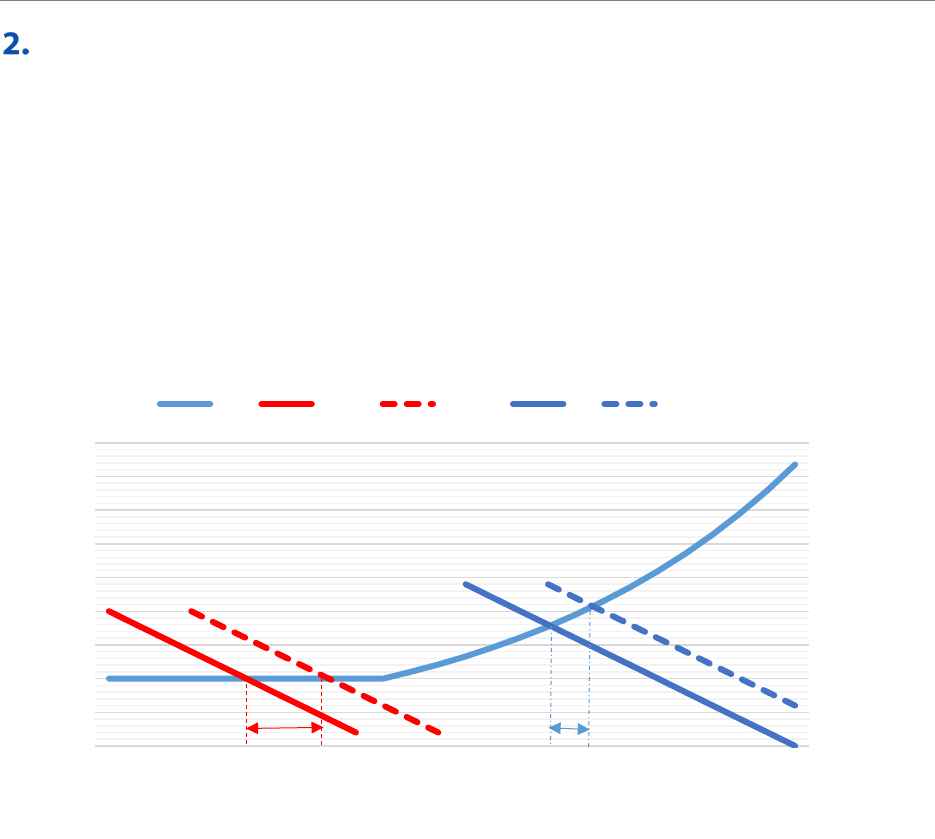
Achieving the right fiscal-monetary mix (in the context of the economic governance review)
PE 747.830 127
FISCAL POLICY AWAY FROM THE LOWER BOUND
2.1. A simple framework
During the low-for-long period, when interest rates were stuck at the lower or zero bound, fiscal policy
seemed to have become the main countercyclical instrument. The usual argument that a higher deficit
leads to higher interest rates, which then crowd out other expenditure, no longer seemed to hold. In
the standard, if dated, IS-LM framework that economists often use to describe the impacts of fiscal
and monetary policy, this corresponds to the situation depicted below, a very flat (horizontal) LM
curve. Figure 1 illustrates this using an LM curve that is horizontal for large negative values of the
output gap.
Figure 1. IS LM illustration
Source: Authors’ own elaboration.
Note: Output gap is the difference between actual GDP and potential GDP. The arrows illustrate the change in
the output gap after IS curve shift, from IS ZLB to IS ZLB2, and from IS to IS2.
A fiscal expansion, i.e. a higher deficit, would shift the IS curve to the right. It is apparent that when
the economy is at or close to the zero/lower bound, a fiscal expansion has a greater impact on output
than when the economy is far away from the zero lower bound (ZLB). This is shown in Figure 1, which
depicts a (horizontal) shift in the IS curve of the same amount for these two cases.
0,0
0,5
1,0
1,5
2,0
2,5
3,0
3,5
4,0
4,5
-2,5
-2,3
-2,1
-1,9
-1,7
-1,5
-1,3
-1,1
-0,9
-0,7
-0,5
-0,3
-0,1
0,1
0,3
0,5
0,7
0,9
1,1
1,3
1,5
1,7
1,9
2,1
2,3
2,5
INTEREST RATE %
OUTPUT GAP%
LM IS ZLB IS ZLB2 IS IS2

IPOL | Economic Governance and EMU Scrutiny Unit (EGOV)
128 PE 747.830
2.2. Empirical estimates of changing multipliers
There have been extensive efforts to estimate the size of fiscal multipliers in different circumstances
(see de Rugy and Salmon (2022) for an exhaustive survey of multiplier estimates over the last two
decades). Some contributions distinguish between the multiplier effect of different fiscal instruments
such as government spending, taxes and transfers (Forni et al., 2009; Eggertsson, 2009; Coenen et al.,
2012, Barrell et al., 2012). Several studies have investigated the cyclical variation of fiscal multipliers
(Berge et al., 2021).
Following the prolonged period of low interest rates, a large body of literature has discussed the
impact of fiscal policy during episodes of zero/lower bound nominal interest rates. Consistent with
theories, many find a larger value of the government spending multiplier with interest rates at the
zero/lower bound than in normal times (to name a few, see Christiano et al., 2010; Klein and Roland
Winkler, 2019; Di Serio et al., 2020).
The use of asset purchases and other non-standard policy instruments led to a situation (mostly in
advanced economies, including the euro area) that has been called a persistent ‘liquidity trap’, where
the further monetary expansion no longer stimulated the economy and fiscal policy became the main
countercyclical instrument (Gopinath, 2020).
More recent analyses based on state-of-the-art macroeconomic models confirm the higher
effectiveness of fiscal spending in boosting economic activity in a liquidity trap (Michau, 2019;
Lemoine and Lindé, 2023). During the COVID-19 pandemic, interest rates remained at the lower bound
(and central banks intensified the use of expansionary non-standard policies, but the massive fiscal
stimulus packages deployed by governments did not seem to have a major effect on output. This was
to be expected given the sectoral nature of the COVID-19 recession and recovery (Capolongo and
Gros, 2020)
105
.
105
See https://www.europarl.europa.eu/cmsdata/211390/2_CEPS%20final.pdf

Achieving the right fiscal-monetary mix (in the context of the economic governance review)
PE 747.830 129
A STEEPER PHILLIPS CURVE?
The Phillips curve theory suggests a trade-off between the rate of change of wages (and prices) and
the employment level. The theory was first introduced by William Phillips in 1958 based on empirical
observations of wages and unemployment in the UK, where he identified an inverse relationship
between the two variables. The underlying intuition is that when the economy is experiencing a
period of strong growth and there is a high demand for labour (unemployment is very low), wages
tend to be bid upward rather rapidly, pushing firms to increase prices, and vice versa (Phillips, 1958).
The occurrence of stagflation in the 1970s, with high levels of both inflation and unemployment,
however challenged the validity of the original Phillips curve concept and motivated the refinement
of the theory over time. Lucas (1972) proposed the new classical version of the Phillips curve
incorporating the role of rational expectations into the analysis. Keynesian economists of the 1960s
exploited the concept of the Phillips curve, reasoning that policymakers could reduce unemployment
by accepting higher inflation or vice versa. Lucas argued that if policymakers attempt to exploit the
Phillips curve trade-off by creating surprise inflation, individuals would adjust their behaviour and
factor in the expected inflation. As a result, any short-term reduction in unemployment achieved
through surprise inflation would be temporary, leading to higher inflation expectations and no long-
term reduction in unemployment, resulting in a breakdown of the Phillips curve relationship.
The relationship between inflation and unemployment has become more complex over time in view
of the strength of the labour market. Historically low unemployment, and core inflation remaining
persistently below the target preceding the COVID-19 crisis led to a discussion about whether the link
between output or unemployment and inflation had disappeared. Mishkin et al. (2019) thus asked
whether the Phillips curve was dead
106
. In the euro area, the ECB examined over 500 specifications of
the Phillips curve in 2019 using different measures of inflation (wages, core, headline, etc.) and
different slack measures (output gap, unemployment, etc.) and arrived at the conclusion that the
Phillips curve was alive
107
.
Using regional data from the US, Mishkin et al. (2019) reported that in tight labour markets the Phillips
curve may be subject to important nonlinearities. Also, Hooper et al. (2020) suggested an emergence
of nonlinear dynamics in the Phillips curve. This implies that the relationship between inflation and
unemployment may not be a simple linear trade-off, as suggested by the original Phillips curve theory
(Hooper et al., 2020).
3.1. The renaissance of the Phillips curve
The pandemic entailing significant supply and demand shocks with the corresponding
unprecedented monetary and fiscal policy responses – introduced new dynamics and challenges to
the applicability and predictability of the traditional Phillips curve, as a consequence of higher
inflation expectations, supply shocks and structural changes (Ari et al., 2023). So the linear Phillips
curve with anchored expectations failed to predict the surge in inflation following the pandemic
(Gopinath, 2022).
The key issue for the ECB at present is not so much whether a fiscal adjustment would have a large
impact on output, but whether it would have a large impact on inflation. This in turn depends on the
106
See https://cepr.org/voxeu/columns/phillips-curve-dead-or-
alive#:~:text=Figures%201%20and%202%20show,inflation%20to%20tight%20labour%20markets
107
See https://www.ecb.europa.eu/pub/economic-bulletin/articles/2019/html/ecb.ebart201904_02~d438b3e4d4.en.html#toc5

IPOL | Economic Governance and EMU Scrutiny Unit (EGOV)
130 PE 747.830
relationship between output or employment and wages (Schanbel, 2023). A key question is whether
the slope of the Phillips curve has increased (again) over recent years.
The present combination of high inflation and low unemployment suggests that the Phillips curve is
not dead (Baba et al., 2023). Moreover, unemployment has declined only marginally over the last year,
while inflation has shot up and remained high despite now-falling energy prices. This suggests that
the slope of the Phillips curve may have increased, implying that even a relatively small change in
demand could have a significant impact on inflation. Even a small negative impact of fiscal adjustment
on demand could provide considerable support for the ECB’s fight against inflation.
More recently, Chai Dao et al. (2023) present further evidence of nonlinearities in the slope of the
Phillips curve. They measure the Phillips curve as the unemployment-inflation trade-off, which is
slightly different from the growth-inflation relationships used in the ECB’s evaluations. They argue that
the slope of the euro area curve has roughly doubled relative to the pre-pandemic years. The increase
in the slope of the US curve is even greater. An important aspect of their findings is that one should
use the pre-2019 estimates as a benchmark rather than the 2022 estimates.
Chai Dao et al. (2023) report the following results:
“the slope of the US relation is about –0.3 at 8 percent unemployment but steepens
to –2 at 3.5 percent unemployment. … The euro area might have a similarly steep part
of the curve, but this remains uncertain as there has not yet been sufficient overheating
to reveal it. A further implication is that policy tightening that cools demand can
potentially achieve larger inflation reductions in a more overheated economy.“
One important use of the Phillips curve is in forecasting inflation – a key issue for the ECB. Its own
analysis (Bańbura and Bobeica, 2020) concludes that some specifications of the Phillips curve could
help forecast inflation, potentially also including nonlinear aspects
108
.
Taking into account today’s probably much larger impact of a slowing economy could be important
for the ECB in calibrating its own policy.
3.2. Can fiscal policy shift the curve?
Most modern economic models do not treat the Phillips curve as a simple relationship between some
measure of inflation and some measure of economic slack. A key third ingredient is the expected
inflation rate. Actual inflation is thus understood as the result of two elements, namely expected
inflation and the degree of economic slack (e.g. the unemployment rate). Various models and
approaches differ mainly in terms of what determines expectations of inflation. We do not want to
enter into this debate of rational versus adaptive, versus static expectations
109
.
The evidence presented in the previous subsection on the slope of the Phillips curve referred to the
magnitude of the impact of a change in unemployment on inflation, given inflation expectations.
There is also some evidence that fiscal policy may influence inflationary expectations and shift the
curve. This could mean that contractionary fiscal measures may reduce the expectations of inflation
by firms and households (at any given level of economic slack) and indirectly curb inflationary
pressures to a significant extent. Łyziak and Mackiewicz-Łyziak (2020) find that economic agents
reduce their inflation expectations in response to a more sustainable fiscal policy. Similarly, Grigoli and
Sandri (2023) find that high public debt has stagflationary effects, with weaker economic activity and
108
See https://www.ecb.europa.eu/pub/pdf/scpwps/ecb.wp2471~fc87caada8.en.pdf; for the US see
https://www.nber.org/system/files/working_papers/w31197/w31197.pdf
109
For a very recent discussion, see a long blog post by J. Cochrane https://johnhcochrane.blogspot.com/ (28 August 2023).

Achieving the right fiscal-monetary mix (in the context of the economic governance review)
PE 747.830 131
higher inflation. Increasing government spending and higher interest rates on sovereign debt have a
similar effect according to Coibion and Weber (2021). The inflation expectations channel and the pass-
through from fiscal policy to inflation, have also been documented based on a natural experiment
(D’Acunto et al., 2016).
The evidence that in some circumstances a fiscal policy that becomes more sustainable shifts the
curve is still tentative. If confirmed, it would provide another argument to accelerate the reduction in
deficits.

IPOL | Economic Governance and EMU Scrutiny Unit (EGOV)
132 PE 747.830
THE FISCAL COST OF CENTRAL BANK BOND BUYING
When inflation and interest rates increase, central banks ordinarily profit because they pay no interest
on cash and have investments whose yields rise along with interest rates. This is known as seigniorage
income, which ultimately accrues to national treasuries. In recent decades, the ratio of cash holdings
to GDP has grown in most countries
110
, thereby increasing the base for seigniorage. For example, in
the euro area, the amount of currency in circulation – almost EUR 1 600 billion
111
– is now worth about
12 % of GDP. At the present deposit rate, the ECB (the Eurosystem, to be precise) should be earning at
least 3.75 % on the assets that are the counterpart of this EUR 1 600 billion. Its seigniorage revenue
should therefore be EUR 60 billion, or 0.45 % of GDP. For the US, the theoretical seigniorage revenue
is similar as a proportion of GDP because the policy rate is higher, although the cash-to-GDP ratio is
somewhat lower at 9 %. On the over USD 2 200 billion outstanding, the Fed should now be earning
5.5 %, resulting in seigniorage revenues of USD 120 billion, or about 0.5 % of GDP
112
.
But this time is different. Central banks are now taking losses from the large amounts of bonds they
have bought over the past nearly 10 years of low inflation. Central banks bought long-term bonds
during their various quantitative easing (QE) operations because they wanted to alleviate private
investors from the interest rate risks inherent in holding long-term bonds. The stock of bonds on the
balance sheets of central banks is generally low yield and long term.
For this part of their balance sheet, the impact of rising rates on central bank accounts is the opposite
of that of seigniorage: as policy rates rise, central banks must pay more on their liabilities to banks
than they earn on the stock of bonds.
113
When the stock of bonds held under QE is larger than the cash in circulation (which is the case for
most large central banks that engaged in QE), these losses are larger than the seigniorage revenues,
leading to unprecedented overall losses for the central banks concerned. If one wants to calculate the
impact of higher interest rates due to past QE, one should look at the change in the net revenues of
central banks.
The deterioration of the profit and loss accounts of the major central banks is impressive.
In the US, the quarterly net income of the Federal Reserve went from a profit of USD 32 billion in Q1
2022 to a loss of USD 28 billion in Q1 2023, a reduction of USD 60 billion per quarter or USD 240 billion
annually, which is equivalent to about 1 % of US GDP.
114
In the UK, the losses for the Bank of England will be particularly severe because the cash-to-GDP ratio
in the UK is only 4 % and the accumulated bond purchases amounted to about 40 % of GDP by the
end of 2023. Accordingly, the Bank of England will need transfers from HM Treasury of about GBP 40
billion, or around 2 % of GDP, as long as interest rates remain at their present levels.
The Bank of England also provides an estimate of the total cumulative fiscal cost of its QE operation,
including past gains, which of course depends on future interest rates
115
. The estimates range from
110
As an aside, one should note that this fact is difficult to reconcile with the widely-held proposition that cash is disappearing, which
constitutes one of the key arguments for the digital euro project of the ECB.
111
https://www.ecb.europa.eu/stats/policy_and_exchange_rates/banknotes+coins/circulation/html/index.en.html
112
Authors own calculations.
113
Gros (2016) shows that one could consider QE operations as the investment arm of central banks, with all the attendant risks involved.
114
Federal Reserve Banks Combined Quarterly Financial Report, https://www.federalreserve.gov/aboutthefed/files/quarterly-report-
20230818.pdf
115
For an in independent source of the cost of QE, see https://www.niesr.ac.uk/news/ongoing-costs-quantitative-easing

Achieving the right fiscal-monetary mix (in the context of the economic governance review)
PE 747.830 133
over GBP 100 billion to GBP 200 billion, or between 5 % and 10 % of UK GDP. Over the next 3 years,
the Bank expects transfers from HM Treasury of GBP 40 billion, or close to 2 % of UK GDP.
116
For the euro area, the accounts of the ECB and those of the 20 national central banks that conduct the
euro area’s monetary policy are too opaque to provide a similarly simple indication of the fiscal cost
of (past) bond buying, but the overall numbers lead to a similar result: holding bonds worth close to a
third of GDP that yield nearly nothing will lead to a cost of about 1 % of GDP when the ECB has to pay
banks 3.75 % to hold their excess reserves (Gros and Shamsfakhr, 2022).
The loss to the Eurosystem as a whole will be smaller than this amount, because 40 % of this loss will
be offset by the increased seigniorage revenues mentioned above, but 0.6 % of GDP is still relevant,
corresponding to the annual adjustment effort required under the (old) fiscal rules. Furthermore, the
ECB has recently lowered the interest it pays on required reserves to zero.
117
This will have only a small
impact on the losses of the Eurosystem, but shows what steps the ECB is taking to reduce losses.
What is more, the ECB and many national central banks have large reserves that can now be used to
offset some of these losses and spread them over time. However, these accounting adjustments do
not change the underlying fact that the national central banks in the euro area, which receive the bulk
of the so-called monetary income, will have to reduce or even stop their transfers to national treasuries
for some time.
Table 1 below shows in the first column the net income, or rather the expected loss, of the three major
central banks in 2023. The second column then shows the change in the net income between 2022
and 2023. This difference reveals the loss incurred by the existing stock of low-yielding government
debt on the balance sheets of these central banks. As argued above, an increase in inflation should
normally lead to higher central bank profits. But massive QE has completely reversed this.
Table 1: Income/losses of QE- major central banks (% GDP)
Absolute loss 2023
Change in income from 2022 level (p.p.)
US Federal Reserve
0.5
1.0
Bank of England
1.9
1.9
Eurosystem
0.7
0.6
Source: Own calculations based on ECB, BoE and Federal Reserve data.
Note: The forecast for euro area GDP in 2023 is taken from the European Commission.
The losses for the Eurosystem would be even larger had the ECB not made an unprecedented
unilateral change to the terms of its long-term lending in late 2022. Back in 2020, the ECB wanted to
entice banks to take up its ‘targeted long-term operations’ (TLTRO) by promising them a rate of minus
1 % if banks expanded their loan books. This seemed aggressive, but barely justifiable, when inflation
hovered close to zero and no end seemed in sight for the negative interest rate policy. Yet, by late
2022, with inflation out of control and the ECB needing to raise its own rates quickly, the cost of this
promise had become clear. The ECB then simply decided to unilaterally change the terms on the
TLTROs, arguing that this ”drastic change in circumstances could not have been foreseen”.
118
116
Asset Purchase Facility Quarterly Report - 2023 Q2, https://www.bankofengland.co.uk/asset-purchase-facility/2023/2023-q2
117
https://www.ecb.europa.eu/press/pr/date/2023/html/ecb.pr230727~7206e9aa48.en.html
118
https://eur-lex.europa.eu/legal-content/EN/TXT/PDF/?uri=CELEX:32022D2128

IPOL | Economic Governance and EMU Scrutiny Unit (EGOV)
134 PE 747.830
The cost estimates presented here can only be approximations of the order of magnitude, as the exact
details of the holdings are not known. The key point is that, as the stock of PSPP and PEPP holdings
will diminish only in homoeopathic doses, these costs are likely to continue for as long as the ECB
keeps interest rates at current levels (Gros and Shamsfakhr, 2023).

Achieving the right fiscal-monetary mix (in the context of the economic governance review)
PE 747.830 135
MONETARY POLICY AND THE (NEW?) ECONOMIC GOVERNANCE
FRAMEWORK
Before entering into a discussion of the Commission proposals for a new economic governance
framework, it is useful to consider the history of the euro area’s fiscal rules.
The basis of the Maastricht consensus was that monetary policy would be unified only through EMU
and that the ECB would aim solely at price stability as its overarching mandate. The purpose of the
fiscal rules first enshrined in the Maastricht Treaty was mainly to prevent ”gross errors” and to avoid
pressure on the ECB from highly indebted countries. This was also the main reason why the deficit and
debt ”reference values” were included in the Treaty. These fiscal rules represent the only link between
fiscal and monetary policy. Sound public finances facilitate a monetary policy that can pursue price
stability without having to fear financial instability arising from the debt problems of individual
Member States.
The SGP operationalised the meaning of ”reference values” for fiscal policy oversight after the start of
EMU in 1999. The Pact specified that Member States should aim for a balanced budget on average
over the cycle. The purpose was to allow countercyclical policies in a recession, when the fiscal deficit
could move from balance to a maximum of 3% of GDP. The 3% limit, which was lower than the actual
value at the time of the negotiations in Maastricht, was chosen because it was thought that it would
only be reached in the event of a very deep recession. With an elasticity of the deficit relative to growth
of about 0.5, growth would have to fall by 6 percentage points below trend before countries would
see the deficit increase above 3% of GDP – provided of course that they started from a balanced
budget in cyclically normal times.
In addition, the SGP introduced an escape clause (“exceptional circumstances”) that allowed larger
deficits in the event of a severe downturn. To ensure compliance with these rules, the Pact created an
elaborate ”excessive deficit procedure” with a number of escalation stages, finally including fines for
Member States that persistently run excessive deficits.
As is well known, the SGP did not survive contact with reality. (Most) Member States did not run
balanced budgets in favourable times during the first years of EMU and thus ran into higher deficits
when the first downturn came in 2001-2002. In late 2003, the proposal of the Commission to launch
an excessive deficit procedure against France and Germany was met by opposition of the three largest
EMU Member States. This episode showed the fundamental problem with the enforcement of fiscal
rules in the euro area. Member States are always very reluctant to impose harsh measures on their
peers because they might need their votes for something else in the future.
Subsequent rounds of reforms confirmed this Achilles heel. In 2005, the Pact was made more
”intelligent” by referring more to cyclically adjusted deficits; but it also became more complicated.
This was not the last reform. The 2011 reform even attempted to overcome the enforcement problem
with the reverse majority voting system, under which a Commission proposal within the excessive
deficit procedure could be overruled by Member States only with a two-thirds majority in Council.
However, this only shifted the problem on the Commission, which then became more reluctant to
propose fines.
During calmer times after the financial and public debt crises of 2007-2012, Member States made little
progress in reducing debt levels. Some countries, in the first instance Italy but also Spain (Greece being
a special case because it was under a macroeconomic adjustment programme) caused continual
frictions with requests for more flexibility under the rules formally in force then. The limits on debts

IPOL | Economic Governance and EMU Scrutiny Unit (EGOV)
136 PE 747.830
and deficits were then suspended in 2020, as envisaged by the rules, when COVID-19 led to a severe
downturn.
The Commission has since proposed new rules that concentrate squarely on the sustainability of debt
levels. In principle, this is exactly the problem identified by Maastricht (and which materialised during
the euro debt crisis). At the same time, the new rules would require much less adjustment than the
old ones. Moreover, the basis for the new rules should be tailor-made paths for fiscal policy negotiated
individually by Member States with the Commission. The Commission maintains that this will create
more national ownership, solving the enforcement problem.
The new proposed rules, if adopted, would not require major immediate adjustments in fiscal policy.
They would therefore not influence monetary policy, at least not in the short term. The medium- to
long-term effect of the new rules all depends on their success in ensuring the sustainability of public
finances. Whether this will be the case is impossible to say at present. The main argument put forward
by proponents of the new rules is that Member States will be much more likely to follow less
demanding adjustment plans negotiated with the Commission than to comply with the more
demanding existing rules. There is no objective basis for or against this argument. It remains a hope
and only experience will show.

Achieving the right fiscal-monetary mix (in the context of the economic governance review)
PE 747.830 137
CONCLUSION
Fiscal and monetary policy should now work in the same direction.
There is no need for formal coordination. The ECB remains fully responsible for combatting inflation
and the overall stance of fiscal policy should mainly be geared towards maintaining sustainable debt
ratios and be countercyclical. At present, these two requirements coincide.
The 2024 budgets presented by Member States envisage a reduction in deficits of about 0.5 % of GDP.
This gradual path of adjustment should be accelerated, given that at the present juncture a stronger
adjustment will also help to reduce inflation. Achieving this acceleration of adjustment will be made
harder by the unintended fiscal costs of the PSPP and PEPP.
It is a different question whether the still large stock of government debt held in the Eurosystem
influences the level of interest rates and keeps them lower than they otherwise would be.
119
The
argument made is simply that the sharp increase in interest payments on reserves makes the
necessary fiscal adjustment more difficult.
The European Commission has underpinned its reform proposals for economic governance, inter alia,
with the assertion that imposing the existing rules in 2024 would require excessive adjustment.
Irrespective of the validity of this assertion in normal times, the call for softer fiscal rules comes at a
very inopportune time. The present situation of sticky (core) inflation and full employment provides
the ideal backdrop for decisive action to put debt on a plausible and sustainable downwards path.
Moreover, the ongoing discussion on the reform of the SGP has created an incentive for (highly
indebted) Member States to keep their deficits elevated this year, because this provides a higher
watermark from which the adjustment plans that would have to be negotiated/agreed under the
proposed governance framework would depart. The 4-7 year time horizon envisaged for the
adjustment plans would presumably take as their starting point the debt level at the end of 2023, with
little pressure to reduce debt even by 2027 under the 4-year horizon, or by 2030 if the country fulfils
the conditions for this extension. It is thus likely that this optimal moment for fiscal adjustment will be
missed.
119
https://www.niesr.ac.uk/news/ongoing-costs-quantitative-easing

IPOL | Economic Governance and EMU Scrutiny Unit (EGOV)
138 PE 747.830
REFERENCES
• Ari, A. and Garcia-Macia, D. (2023), ‘Has the Phillips Curve Become Steeper?’, IMF Working Paper,
WP/23/100. https://doi.org/10.5089/9798400242915.001
• Baba, C., Duval, R., Lan, T., and Topalova, P. (2023), ‘The 2020-2022 Inflation Surge Across Europe: A
Phillips-Curve-Based Dissection’, IMF Working Papers WP/23/30.
https://www.imf.org/en/Publications/WP/Issues/2023/02/10/The-2020-2022-Inflation-Surge-
Across-Europe-A-Phillips-Curve-Based-Dissection-529693
• Barrell, R., Holland, D., and Hurst, I. (2012), ‘Fiscal multipliers and prospects for consolidation’, OECD
Journal: Economic Studies, Vol. 2012/1. http://dx.doi.org/10.1787/eco_studies-2012-5k8x6k5wc58x
• Berge, T., De Ridder, M., Pfajfar, D. (2021), ‘When is the fiscal multiplier high? A comparison of four
business cycle phases’, European Economic Review, Vol. 138, 103852, ISSN 0014-2921.
https://doi.org/10.1016/j.euroecorev.2021.103852
.
• Capolongo, A. and Gros, D. (2020), This time is different: The PEPP might not work in a Sectoral
Recession, Monetary Dialogue Papers, September.
https://www.europarl.europa.eu/cmsdata/211390/2_CEPS%20final.pdf
• Christiano, L., Eichenbaum, M., and Rebelo, S. (2011), ‘When Is the Government Spending Multiplier
Large?’, Journal of Political Economy, Vol. 119, No., pp. 78-121. https://doi.org/10.1086/659312
• Coenen, G., Erceg, C.J., Freedman, C. , Furceri, D., Kumhof, M., Lalonde, R., Laxton, D., Lindé, J.,
Mourougane, A., Muir, D., Mursula, S., de Resende, C., Roberts, J., Roeger, W., Snudden, S., Trabandt,
M., and in’t Veld, J. (2012), ‘Effects of Fiscal Stimulus in Structural Models,’ American Economic
Journal: Macroeconomics, Vol. 4, No. 1, pp. 22–68.
http://www.aeaweb.org/articles.php?doi=10.1257/mac.4.1.22
• Coibion, O., Gorodnichenko, Y., and Weber, M. (2021), ‘Fiscal Policy and Households’ Inflation
Expectations: Evidence from a Randomized Control Trial’, Becker Friedman Institute, Working Paper
No. 2021-26. https://bfi.uchicago.edu/wp-content/uploads/2021/02/BFI_WP_2021-26.pdf
• D'Acunto, F., Hoang, D., and Weber, M, (2016). ‘Unconventional Fiscal Policy, Inflation Expectations,
and Consumption Expenditure’. CESifo Working Paper Series No. 5793.
http://dx.doi.org/10.2139/ssrn.2760238
• Dao, M., C., Dizioli, I., Jackson, C., Gourinchas, P-O, and Leigh, D. (20), ‘Unconventional Fiscal Policy
in Times of High Inflation’, IMF working paper, WP/23/178.
https://www.elibrary.imf.org/downloadpdf/journals/001/2023/178/001.2023.issue-178-en.xml
• De Rugy, V. and Salmon, J. (2022), ‘Declining Fiscal Multipliers and Inflationary Risks in the Shadow
of Public Debt’, Policy Brief, Mercatus Center, George Mason University.
https://www.mercatus.org/research/policy-briefs/declining-fiscal-multipliers-and-inflationary-
risks-shadow-public-debt
• Di Serio, M., Fragetta, M., and Gasteiger, E. (2020), ‘The Government Spending Multiplier at the Zero
Lower Bound: Evidence from the United States’, Oxford Bulletin of Economics and Statistics, Vol. 82,
No. 6, pp.1262–1294. https://doi.org/10.1111/obes.12382
• Eggertsson, G.B. (2009), ‘What Fiscal Policy Is Effective at Zero Interest Rates?’ Federal Reserve Bank
of New York, Staff Report No. 402.
https://www.newyorkfed.org/medialibrary/media/research/staff_reports/sr402.html

Achieving the right fiscal-monetary mix (in the context of the economic governance review)
PE 747.830 139
• Forni, L., Monteforte, L., and Sessa, L. (2009), ‘The General Equilibrium Effects of Fiscal Policy:
Estimates for the Euro Area’, Journal of Public Economics, Vol. 93 No. 3–4, pp. 559–85.
https://econpapers.repec.org/article/eeepubeco/v_3a93_3ay_3a2009_3ai_3a3-4_3ap_3a559-
585.htm
• Gopinath, G. (2020), ‘Global Liquidity Trap Requires a Big Fiscal Response’, Financial Times, 2
November. https://www.ft.com/content/2e1c0555-d65b-48d1-9af3-825d187eec58
• Gopinath, G. (2022), ‘How Will the Pandemic and War Shape Future Monetary Policy?’ IMF, Prepared
for the Jackson Hole Symposium.
https://www.imf.org/en/News/Articles/2022/08/26/sp-gita-
gopinath-remarks-at-the-jackson-hole-
symposium#:~:text=The%20pandemic%20and%20war%20have,stability%20and%20employmen
t%20or%20growth.
• Grigoli, F. and Sandri, D. (2023), ‘Public debt and household inflation expectations’, BIS Working
Papers No 1082. https://www.bis.org/publ/work1082.pdf
• Gros, D., and Shamsfakhr, F. (2023),’ Quantitative tightening in homeopathic doses: The ECB and
the long shadow of the PSPP and the PEPP’, Monetary Dialogue Papers, March 2023.
https://www.europarl.europa.eu/RegData/etudes/IDAN/2023/741482/IPOL_IDA(2023)741482_EN
.pdf
• Gros, D., and Shamsfakhr, F. (2022),’The Real Fiscal Cost of Central Bank Bond Buying’, CEPS
Explainer, CEPS.
https://cdn.ceps.eu/wp-content/uploads/2022/11/CEPS-Explainer2022-
4_Central-bank-bond-buying.pdf
• Hooper, P., Mishkin, F.S., and Sufi, A. (2020), ‘Prospects for inflation in a high pressure economy: Is
the Phillips curve dead or is it just hibernating?’ Research in Economics, Vol. 74, No. 1, pp. 26–62.
https://doi.org/10.1016/j.rie.2019.11.004
• Klein, M., and Winkler, R. (2019), ‘The Government Spending Multiplier at the Zero Lower Bound:
International Evidence from Historical Data’, Journal of Applied Econometrics, Vol. 36, No. 6, pp. 744–
759. https://doi.org/10.1002/jae.2835
• Klein, M., and Winkler, R. (2019), ‘The Government Spending Multiplier at the Zero Lower Bound:
International Evidence from Historical Data’, Journal of Applied Econometrics, Vol. 36, Issue 6, pp.
744-759. https://doi.org/10.1002/jae.2835
• Lemoine, M. and Lindé, J. (2023), ‘Fiscal stimulus in liquidity traps: Conventional or unconventional
policies?’ European Economic Review, Vol. 151, 104324.
https://doi.org/10.1016/j.euroecorev.2022.104324
• Leeper, E.M. (1991), ‘Equilibria under "active" and "passive" monetary and fiscal policies’, Journal of
Monetary Economics, Vol. 27, pp.129–147.
https://www.sciencedirect.com/science/article/abs/pii/030439329190007B
• Leeper, E.M., and Leith, C. (2016), ‘Understanding Inflation as a Joint Monetary-Fiscal Phenomenon’,
Handbook of Macroeconomics, Vol. 2, pp. 2305–2415.
https://www.sciencedirect.com/science/article/abs/pii/S1574004816000136
• Lucas, R.E. (1972), ‘Expectations and the neutrality of money’, Journal of Economic Theory, Vol. 4,
No. 2, pp. 103-124. https://doi.org/10.1016/0022-0531(72)90142-1

IPOL | Economic Governance and EMU Scrutiny Unit (EGOV)
140 PE 747.830
• Łyziak, T. and Mackiewicz-Łyziak, J. (2020), ’Does fiscal stance affect inflation expectations?
Evidence for European economies, Economic Analysis and Policy, Vol. 68, pp. 296-310.
https://doi.org/10.1016/j.eap.2020.09.010
• Michau, J.-B. (2019), ‘Monetary and fiscal policy in a liquidity trap with inflation persistence’, Journal
of Economic Dynamics and Control, Vol. 100, pp. 1-28. https://doi.org/10.1016/j.jedc.2018.12.006
• Phillips, A.W. (1958), ‘The Relation Between Unemployment and the Rate of Change of Money Wage
Rates in the United Kingdom, 1861–1957’, Economica, Vol. 25, No. 100, pp. 283-299.
https://doi.org/10.2307/2550759
• Regling, K. (2022), ‘EU Fiscal Rules: A Look Back and the Way Forward’, Vol. 57, No. 1.
https://www.intereconomics.eu/pdf-download/year/2022/number/1/article/eu-fiscal-rules-a-
look-back-and-the-way-forward.html
• Sargent, T., and Wallace, N. (1981), ‘Some Unpleasant Monetarist Arithmetic’, Federal Reserve Bank
of Minneapolis, Quarterly Review, Vol. 5, No. 3.
https://ideas.repec.org/a/fip/fedmqr/y1981ifallnv.5no.3.html
• Schnabel, I. (2023), ‘Disinflation and the Phillips curve’, Speech a conference organised by the
European Central Bank and the Federal Reserve Bank of Cleveland’s Center for Inflation Research
on “Inflation: Drivers and Dynamics 2023”, Frankfurt am Main, 31 August 2023.
https://www.ecb.europa.eu/press/key/date/2023/html/ecb.sp230831~c25314a3fc.en.html

PE 747.830
IP/A/ECONMD/FWC/2020-002
Print ISBN 978-92-848-1119-9 | doi:10.2861/362812| QA- 05-23-339-EN-C
PDF 978-92-848-1120-5 | doi:10.2861/276919| QA- 05-23-339-EN-N
Alignment of monetary and fiscal policies has proven to be decisive for the euro area's ability to
withstand successive crises over the years. Today, the European Central Bank (ECB) continues its
fight against inflation by implementing a monetary policy tightening unprecedented in pace and
scale. At the same time, after allowing for some deviations from regular budgetary rules with the
activation of the general escape clause in 2020, the EU is set to reapply its fiscal rules fully from 2024.
In addition, co-legislators are currently discussing the proposed legislation by the European
Commission for the reform of the economic governance framework. Five papers were prepared by
the ECON Committee’s Monetary Expert Panel, discussing the interaction between monetary and
fiscal policies in the euro area.
This document was provided by the Economic Governance and EMU Scrutiny Unit at the request of
t
he Committee on Economic and Monetary Affairs (ECON) ahead of the Monetary Dialogue with the
ECB President on 25 September 2023.


